It’s been just over a year since the first Suunto Ambit came out (which for clarity I’ll use the term Ambit1 during this review), and during that time Suunto has made impressive progress on the original unit through a series of pre-announced and predictable (and even on time!) firmware updates. Today, Suunto has officially announced their latest addition to the lineup, the Ambit2 and Ambit2 S. With the new Ambit, Suunto is squarely taking aim at not only the ultra-running and hiking market that the Ambit1 targeted, but now – the triathlete. It introduces both indoor and openwater swimming functionality, as well as multisport mode. With a slew of other features, make no mistake that this is aimed directly at the Garmin FR910XT.
But, how well does it work? And can it knock the FR910XT off the top spot? Well, I’ve spent a lot of miles with the watch recently, and am here to give you all the details: Good, bad, and ugly.
Because I want to be transparent about my reviews – Suunto sent me two final retail units to try out (Ambit2 and Ambit2 S). Once I’m complete here, I’ll send this back to Finland and then go out and buy my own (to be able to support y’all in the comments section down the road). Simple as that. Sorta like hiking in wilderness trails – leave only footprints. If you find my review useful, you can use any of the Amazon or Clever Training links from this page to help support future reviews.
Lastly, at the end of the day keep in mind I’m just like any other regular triathlete out there. I write these reviews because I’m inherently a curious person with a technology background (my day job), and thus I try and be as complete as I can. But, if I’ve missed something or if you spot something that doesn’t quite jive – just let me know and I’ll be happy to get it all sorted out. Also, because the technology world constantly changes, I try and go back and update these reviews as new features and functionality are added – or if bugs are fixed.
So – with that intro, let’s get into things.
Unboxing:
Because I’m covering two slightly different variations of the Ambit in this post, I’ll be doing two unboxing’s below, somewhat in concert.
Here are the two models. The Ambit2 is on the left, and the 2S is on the right. Apparently there was a mix-up and they sent me the original Ambit1 box for the Ambit2 S. Nonetheless, here they are:
On the back however, you’ll see in the SKU that it does list the 2S on the right side for the lime one. Perhaps they were trying to recycle old boxes. Shrug.
Taking a detour for just the full Ambit2 model, here’s its inner box removed from the outer shell:
Inside, you’ll find the watch looking up at you:
Below the watch is a compartment with all of the accessories included. This will vary slightly depending on whether or not you picked up the variant with the heart rate strap. Otherwise, you’ll still find the USB charging cable, and the manual.
Here’s a closer look at the Ambit2 (Sapphire):
And the back:
Switching back to the Ambit2 S, here’s its inner/outer box:
Inside you’ll find the 2S just like Ambit2:
Inside the box of the 2S you’ll find the USB charging cable, the manual, and depending on which variant you’ve bought – the heart rate strap.
And the backside of the 2S. You’ll see it’s essentially identical on the back to that of the Ambit1, and the Ambit2.
Looking at the common accessories, you’ve first got the USB charging clip. This four-pin charging clip simply bites onto the unit itself, and can be powered via any old USB wall outlet you have lying around – or a computer.
Then depending on which bundle you bought you’ll also have the HR strap. This includes the strap piece, and the little pod that snaps in between it:
Here’s how it snaps into place on both sides (in this photo, it’s half-snapped on the left-side):
Note that the Suunto strap included is NOT ANT+. Meaning the strap included is not compatible with any ANT+ devices you may have, instead, only working with other Suunto devices over a proprietary variant of ANT. That said however, if you do have an ANT+ strap (say you’re converting from being a Garmin/Timex/etc…. user), then that will work with the Ambit lineup (all Ambits). Good deal, huh?
Finally, you’ve got the manual. Unlike most companies in the sports technology world however, Suunto’s manual is actually really detailed and very solid. And in nine languages.
Now that everything is unpacked, let’s go ahead and look at how it compares in size to other units.
Size Comparisons:
As you can see above, the watch face sizes are actually really similar across the most competitive units in this space: The Ambit’s and Fenix. Virtually indistinguishable. On the far sides we have other triathlon-focused watches with integrated GPS. At the far left is the Timex Global Trainer, then the Garmin FR310XT, then the Garmin FR910XT, then the Garmin Fenix. Continuing towards the right we have in silver the Suunto Ambit2 Sapphire, then the Ambit2 S Lime, then the original Ambit followed by the Magellan Switch Up. Both the Garmin FR910XT and the Magellan Switch up in these photos are utilizing the quick release kits.
Here’s a closer look at the three Suunto Ambits. Again, from left to right: Ambit2 Sapphire, Ambit2 S Lime, Ambit1.
What’s actually somewhat interesting is the height of the display. You’ll notice that the Ambit1 is the thickest alongside that of the Garmin Fenix, with the Ambit2 following, and the thinnest being the Ambit2 S. You’re looking at the airgap between the watches and the desk.
(Preemptive question and answer about previous section: If I send everything back, how is it that I have all these units for the rolling pins? Simply put: I buy them. Supporting the site through the links you see at the end helps with this. In recent months, Clever Training helps out with the majority of the unit re-purchases from their retail stock.)
Next is to note that the Ambit2 and Ambit2 S are slightly different in terms of thickness. Not a ton, barely noticeable unless you had them both and something like this to measure them:
As you can see below the Ambit2 (silver) is 1.74mm thicker than the Ambit2 S (Lime) – again, remember we’re talking millimeters here. I threw in the older Ambit1 (black) as well, which is .75mm thicker than the Ambit2.
Width-wise, all Ambit units are identical – I measured it as 49.89mm (excluding the buttons):
Then if we look at weight, the Ambit2 is heavier than the Ambit2 S as well. The Ambit2 is 93g, whereas the Ambit2 S is 73g. This comes from the addition of the barometric altimeter and temperature sensors, which adds 9g of weight between the Ambit2 S and the non-Sapphire Ambit2 (82g – not pictured):
While the above is the Sapphire model (for the non-S Ambit2), the non-Sapphire model is slightly lighter at 82g – identical to that of the Garmin Fenix.
And for reference, here’s the weight’s of the Ambit1 (78g) and the Garmin Fenix (82g):
Many folks ask about smaller wrists, so I always defer to The Girl’s opinion on this given her 5’2” height and small wrists. Her wrist size is 14cm (or 5.5 inches), my wrist size is 17cm (or about 6.5 inches). She did a couple of runs with the Ambit2 S.
In her case, she had to have it tightened down to the very last notch in order for it to be snug. Anything less and it was bouncing around.
For those curious about her thoughts – she actually didn’t mind running with the unit (she ran a few times with the Ambit2 S) ,and didn’t find it uncomfortable or too large (she’s run with the Garmin FR310XT and FR910XT previously, but is currently using the FR10).
In comparison, here’s what it looks like on my wrists. First, the Ambit2 S:
Then the Ambit2 Sapphire:
With that, let’s start running!
Running:
First up is pressing the Start button and choosing exercise. It’s here that you’ll select which activity type you’ll be using. In our case, we’re going to go with running:
We’ll dive into all the other activity types later on. Each activity type has pre-configured device pairings associated with it, for example – a heart rate monitor, or a bicycling cadence sensor. In this case, I’ve got my ANT+ heart rate strap paired to it, so it goes and finds that first:
Then it looks for satellites. As I’ll cover in the satellite section, it doesn’t take too long at all – merely a second or two sometimes.
Once that’s done, you’re ready to being running. Note that you’ll see I’ve got the metrics displayed as minutes/mile (typical running format):
However you can also display them in metric format as well, and that can be easily changed in the settings menu:
After pressing the start button to begin running you’ll see your pace, distance, HR and any other metric you’ve configured on the screen. To iterate between the different data pages you’ve configured, you’ll use the next button. Then the view button can be used to change the bottom half of the screen within a given data page. Sorta like a rotating banner.
In the below screen I have workout time up on top, current pace in the middle, and average workout pace along the bottom:
In the next screen I’ve tapped the view button to keep the top screens but change the bottom screen to BPM (heart rate):
Then I tap the Next button and now I’m in a more heart-rate focused screen. Current HR in the middle, average HR at the bottom, and the Training Effect at the top.
All of these screens are customizable and I’ll talk about that later on.
To pause the run, you can simply tap the start/stop button which will trigger a pause. To resume, you’ll press the same button. Additionally, you can press the lap button to create a lap marker that will allow you to see lap-specific intervals either during the run/ride, or later on within the Movescount site.
While running there’s an option called ‘FusedSpeed’, which effectively blends together accelerometer based wrist movements with GPS speed in an attempt to smooth out your speed and provide a smoother pacing experience. Note that FusedSpeed doesn’t work indoors because it depends on the GPS speed.
Below is a short video clip I took showing what the instant-pace looks like on the Ambit2 while running. You’ll see that it’s remarkably stable. I was pacing against a boat along the river (which I assume was doing the same speed as they almost always do in this section). My pace was just going back and forth between 6:15/mile and 6:20/mile. Note that the Ambit2 won’t display 6:17/mile – it displays pace in :05/mile increments. The number you’re watching is the middle number (that’s my instant pace):

For those city runners you can configure AutoPause to automatically pause the watch when you stop running, and then resume the watch after you start running again.
Like the Ambit1, the Ambit2 and Ambit2 S both support the ANT+ footpod. The footpod enables you to gather speed/distance data while indoors on a treadmill, or in situations where GPS may be problematic (such as some trail running scenarios and/or canyons). To pair to the footpod, you’ll go via the settings menu into the pairing menu. From there, simply select ‘Foot POD’:
The Ambits support two types of footpods: Suunto ANT footpods, and ANT+ footpods. As I’ll talk about later, it’d be completely silly to buy a Suunto-only footpod when the ANT+ footpods work with every unit on the market today except Polar devices. Further, the ANT+ footpods are cheaper than the Suunto ones and work just as well (same innards actually).
In any case, once you’ve got everything all paired up, you’re pretty much good to go and calibrate it. You should do this with a known distance location – such as a track. You’ll run around the track at your normal pace (min suggested is 400m, I suggest 800m), and then post-activity you’ll adjust the distance of the activity to the actual distance you ran on the track.
Once paired the unit will at this point automatically use the footpod in place of GPS for speed and distance data, as well as provide cadence data.
Now, let me repeat that again – as it’s a pretty big stumbling block. Instead of supplementing your speed/distance data in cases where the GPS data may drop out (such as a tunnel), it will flat-out replace it for the entirety of the run. This sucks. This means you’ve got to have the footpod calibrated correctly, and even then, it still sucks. That’s sorta the point of buying a GPS watch.
Other units on the market today will automatically failover to the footpod in times of need (i.e. a tunnel), while still using the footpod cadence data and recording that for the entirety of the run.
I’m hopeful that Suunto will change this behavior. In the meantime, to understand more about footpods and how they work – read my super-detailed post on them here (which applies to all ANT+ footpods).
Cycling:
Cycling with the Ambit2 is in many ways like running. First you’ll start off with choosing the sport – obviously cycling in this case.
In doing so it’ll attempt to pair to any of the sensors you’ve previously configured via the pairing menu. The Ambit2 supports three bike profiles. However, these bike profiles are a little different than most other units in that they apply to specific pods, and not to the whole bike. Meaning that if you have separate power meters for each bike (somewhat rare today, I do understand), then you’ll have to manually pair the power meter each time as the Ambit2 units today only support a single power meter pairing.
As for the other pods, it can be a bit confusing. Bike Pods are what Suunto calls any ANT+ speed/cadence combo sensor. Meaning that when pairing these sensors – be sure you select ‘Bike Pods’ and not Cadence Pods. As the Cadence Pods are specifically the Suunto ANT (but not ANT+ sensors).
And, since we’re talking about that – remember that Suunto now supports ANT+ sensors from any vendor, but that the sensors Suunto makes themselves (I’ll cover them later) are NOT ANT+ but rather Suunto ANT. Suunto ANT is private and closed, and only Suunto devices can use it. There’s zero advantages to Suunto ANT, it’s just how they used to do things before they went to open standards.
Ok, at any rate, once paired up and you’ve got satellite you’re ready to begin cycling.
Note that in cycling mode you’ll see metrics displayed in the format of MPH (Miles Per Hour), or if you’ve configured it for the Metric format you’ll see KPH (Kilometers Per Hour).
Like in running, you can switch through the different bike related fields by simply tapping the Next button, and then the Lap Button to alternate the bottom portion of the screen:
The one challenge with cycling with the Ambit is that by default there’s no quick release system, thus it’s either on your wrist, or you pickup one of the cheap $10 universal rubber bike mounts for your handlebars. I’ve put some links in the accessories table at the end to utilize for this. Of course, you can also jury-rig something too. In the case below I was using my Dad’s bike and it had an older FR305 bike mount on it. This provided just enough thickness over the slim handlebar to allow me to wrap it around it:
For triathlon bikes, you’re kinda hosed. You’ll need to pickup not only a universal mount, but also one of the Profile Designs UCI mounts and combine the two together. All in you’re only looking at less than $20US though.
Indoor cycling is no problem at all any of the bike sensors. In my case I went with just using the ANT+ speed/cadence sensor. It’ll then report the wheel speed of my wheel on my trainer, as well as the cadence and power information.
Note that you can configure the wheel circumference for each of the bike pods you’ve configured.
Within the indoor mode, you won’t get any GPS information – because obviously you aren’t going anywhere. But the rest of the information is exactly as how you’d see it outdoors in terms of detail.
By default the Indoor Training mode on the watch doesn’t attach to the cycling computer pieces, so you’ll either need to use the default Cycling mode indoors (and just tap ‘Later’ for GPS), or simply create your own cycling mode with GPS disabled on Movescount:
Note how I’ve set the GPS fix to off, but left the recording rate at 1s and kept the power/cadence/bike/HR sensors on.
Cycling Power Meter Notables:
The Ambit2 and Ambit2 S are the first Suunto products to support cycling power meters. In doing so, they’ve supported the ANT+ power meter standard, which is used for virtually every power meter on the market today (except the $2,500 Polar/Look Keo system). Power meters enable a cyclist to measure their actual output, irrespective of environment conditions such as head winds or changing grade (a mountain). Output is measured in watts (displayed such as 250w), however comparisons between riders should always be done with watts/kg – as bigger riders will generally put out more than smaller riders. This enables you to compare the output of a 200lbs rider to a 110lbs rider. It’s also how Pro Teams compare power output between riders.
Measuring and recording power meter data is probably one of the most fickle things you can do in sports technology today. While it seems easy, there are literally a hundred ways companies can (and do) screw it up. These screw-ups often come in the form of incorrectly parsing the data, or more importantly, the drops of data. How a given head unit handles different power meters, the calibration of such, and the data recording rates are absolutely critical to accurate power data. Riders can spend an entire season just to move their FTP (Functional Threshold Power) 5-10w, so data screw-ups that have a wider margin of error are simply unacceptable.
Before we get into how the unit performs in the data space, let’s look at the pairing process. Doing so is relatively simple. You’ll dive into the settings menu and then within the pairing menu you’ll choose ‘Power POD’:
It’ll find the unit and complete pairing. Ideally this should only take a moment, though I have seen issues with the ANT+ pairing process taking multiple attempts for no good reason.
Once it’s paired, the unit will then be available the next time you select cycling from the exercise menu. In doing so, it’ll activate the power meter search process, which searches for your previously paired power meter:
Once found, it’ll notify you of that:
Then, it’ll immediately do a manual calibration of the unit. This is of particular note, because you generally want to be prepared for such things. For example, in the case of a PowerTap, you should be off your bike and holding it still. In the case of the Quarq, you should be off your pedals and not rotating them.
Once that’s complete, it’ll comeback with success or failure.
Now, what’s interesting here is that it actually will track these values for you. Or at least, the last and current value. Each time you calibrate it’ll show you the current value to the left, and the previous value to the right. This is actually pretty cool. I just wish it went one step further and recorded this within the file for later reference.
If along the ride you wish to manually calibrate (and you should about 10-15 minutes in), you can access the manual calibration menu quickly by holding the middle button down (Next) for a few seconds. Then, select Calibration.
Like before, it’ll come back with current and previous offsets.
Finally, you can enable Auto Zero for those power meters that support it via this menu. Auto Zero enables some power meters to effectively self-calibrate in known situations. For example, while coasting the PowerTap will calibrate. Or if you pedal backwards on the Quarq while coasting – the same thing.
While doing all of this, the Ambit will continue to record data unless you’ve otherwise paused it. And I should point out that this is the fastest process for accessing the calibration menu I’ve seen on any cycling ANT+ head unit to date. Almost all of the others require more steps than the tango to complete.
While riding, power information is displayed with the data pages and fields that you’ve set it up for. By default this includes instant power, 3s averaged power, 10s averaged power, and 30s averaged power. Or essentially the trifecta of averaged power display modes. I find it much more realistic and easier to pace based on a combination of 3s and 30s averaged power. Note this doesn’t impact the recording rate which by default is 1-second. This only impacts the display rate, which effectively averages the previous/trailing 30-seconds.
You can however change to a 10-second power recording mode for ultra-long cycling. However, I’d highly recommend you don’t do so. At that rate, you’ve largely lost any of the detail necessary for power meter metrics such as TSS/NP/IF to work.
Note that the Ambit2/S doesn’t support TSS/NP/IF within the data fields to choose from, however, with the improved App Zone functionality – it may be possible for someone to create an app to display those data fields manually. Here’s all that it supports from a power standpoint today by default.
Also of note is that the Ambit2/S will utilize cadence from ANT+ power meters that transmit it.
Finally, I have seen some drops in power (in particular on a trainer workout). It’s not 100% clear whether or not this was the fault of the Ambit2, the power meter, or some other factor. I did not see these drops on another device that was recording power at the same time however.
In the coming day or two I’ll be finishing up the ANT+ power meter test suite tests (8 tests in total) that validate power meter collection across a wide swath of scenarios focusing on accurate data collection. These tests are quickly becoming the go-to method for head unit companies to validate power meter data collection has occurred correctly. They are put together by the folks at Quarq, but also cover scenarios from other power meter companies. As time allows, I’ll be going back to previous reviews and adding these as well.
Swimming – Openwater:
Both the Ambit2 (and 2S) support openwater swimming, which enables you to track distance, strokes and swimming pace while swimming in openwater (lakes/oceans/etc…). This is different from pool tracking, which I’ll talk about in the next section.
While in openwater swimming mode, the Ambit2 will utilize both its internal accelerometer (to measure stroke information) as well as the GPS antenna to measure distance and speed. To enable openwater swimming mode you’ll go to start an exercise and choose ‘Outdoor swimming’.
Note that the ANT and ANT+ transmission protocols that the Ambit2 utilizes to transmit heart rate don’t transmit well underwater (about 1-2”), thus, you won’t get any heart rate data.
Once satellite reception is completed, you’ll be ready to swim:
While swimming the unit will update distance and time information, as well as pace information in realtime.
Additionally, you’ll get stroke information as well (strokes per minute):
You can press lap and create laps just as you would in any other mode. In my case, I created one at the outbound of my short swim, so I could see the rough split between the outbound and return. These would then show up later on in the site:
And again, this works on the Ambit2 S as well:
Once you’re done with your swim you’ll stop it just like normal. In the event of a triathlon and multisport mode, you’d continue onto the next sport and wouldn’t get summary information until the very end. But for those of you just doing a single session swim, you’ll get typical post-exercise summary around distance and speed:
Because it’s most definitely the wrong time of year to be swimming openwater in the northern most reaches of the planet, my time with the watch is somewhat limited in this respect. I have more swims I’ll be able to do in May and will update accordingly.
Thus I only have a single distance test to work with for outdoor swimming. In this case, I took along a Garmin FR910XT on one wrist, and the Ambit2 on the other wrist (I gave the Ambit2 S to another swimmer to capture data as well, but not for comparative purposes since that was the only device they had on). I then swam a well known and very well documented course when it came to distance. While my sighting likely wasn’t an example of absolute perfection, I did probably get very close though.
Here were the two watches upon completion:
The actual distance of the route should have been 704y or .40 miles (this particular route between buoys is well measured by folks repeatedly each year). I suspect I probably swam closer to .42-.43 miles based on my non-perfect line. As you can see, the FR910XT came closest at .45, while the Ambit was closer to .55 – a bit high (ok, a lot high). Now, before one assumes it’s off 20% do remember that in most cases when I look at openwater units (such as the FR910XT) we tend to see cases where the further you go, the better the results get. This is because of the way it plots points along the way, attempting to average large chunks of distance.
Remember that neither the Ambit2 nor the FR910XT can receive GPS signals underwater, so it’s constantly losing signal during each stroke and then attempting to regain that signal in the split second between when the watch is back underwater again. Within that split second of satellite signal the actual accuracy may be +/- 50m or 500m. So the points it is plotting could literally be all over the map. The watch then attempts to plot the most likely path across this range of dots, ultimately ending up with a track that it displays to you.
You can then see this track (from the Ambit2) later on within the Movescount site online:
Here’s how that compares with the same track as seen by the Garmin FR910XT:
In both cases it overestimates my turnaround point slightly. If you were to zoom in on the Garmin side, I actually touched all four buoys along the course, whereas both units assume I went a bit wider around them than I did.
On the Ambit side you can see that it’s note quite as smoothed – accounting for some of the differences I see in distance.
Overall, it’s a touch too early to say how accurate the unit is overall, simply because I don’t have quite enough time with it. Given a bit more time and I’ll be able to have better data. However I still wouldn’t expect that the unit will be as accurate as the tried and true swimcap method – which is just putting the watch in your swimcap. This means you won’t get stroke data, but you will get spot-on distance data. While the Ambit2 is a bit large to stick up there (especially with the harder wrist straps), it does sorta work:
Ok, openwater swimming complete – let’s head indoors.
Swimming – Indoor Pool/Lap:
Welcome to ‘my’ pool. About one of the craziest I’ve swam in (and I’ve swam in a LOT of places), in terms of everything from the size (33m) to the density of people in each lane (average is 10, maximum I’ve swam in is 17 per lane). And that’s all before we talk about the locker rooms…
As such – it makes for a great test bed for the Ambit2 and Ambit2 S and their ability to count laps while indoors in a pool.
The technology within the watch that enables this is the 3D accelerometer inside. The accelerometer measures acceleration and movement on a 3D axis. This is similar to how your phone understands when you tilt it from portrait to landscape mode, or when you play games by moving it. The same technology enables the watch to track stroke type and lengths within the pool – ultimately giving you distance and pace information.
Because the unit is measuring changes in acceleration, it’s critical that it understands how long your pool is, along with when you change directions (finish a length). I’m going to talk a bit later on how to improve your accuracy in these situations – in part based largely on my recommendations for similar watches such as the Garmin FR910XT. But for now, let’s talk about how to use it.
First up is selecting ‘Indoor Swimming’ from the exercise menu:
Then, you’ll select your pool size. By default you’ve got four sizes – 25y, 25m, 50y, 50m.
However, you can also select ‘Custom’, which enables you to enter in wonky pool sizes like my 33m one:
The ‘Custom’ setting allows you to enter a pool as small as 15y/15m, and a pool as large as 1,200yd/1,200m. Yes, those of you in Vancouver with your 120m pool are good to go! And all of us stuck in short hotel pools can do endless flip turns in style.
Once that’s done, you’re pretty much ready to start swimming. You’ll notice that your pool size is listed on the right side:
To start, simply press the Start button. If and when you want to create a lap, you’ll press the Back/Lap button. As you swim, it’ll provide the distance and current pace, along with the time. But that does require you to tap the next button. Otherwise it’ll just show this screensaver page of sorts, a picture of a swimmer – with no current split information. Below though is what you’ll see once you tap it:
You can change the view by pressing either the Next button, or the View button, which alternate through screens as well as the bottom portion of the screen:
The unit will record per-length information, which is then available later on. I’ve been using Laps/Intervals however to record various sets of mine. For example, if I do a 500m set, I’ll just create a lap at the start and end of it.
Additionally, the unit will record stroke type – which can be retrieved later on on the Movescount site:
Unfortunately however, the only stroke I ever did was freestyle. Which means that either my stroke sucks (very likely), or the unit isn’t very good at stroke recognition (also likely). To be fair, most units on the market suck at stroke recognition, and given the crowded pool I’m in, I’m happy it thinks I’m swimming at all.
As I said earlier, one thing I don’t like though is a strange swimmer screensaver screen that pops up while I’m swimming. Just a blank screen with a picture of a swimmer on it – like a screensaver. I then have to press a button to have it go away. Kinda really super annoying. I asked Suunto about this and they are looking at modifying this so that the current split shows. But in the meantime, you’ve gotta look at the empty screen until you tap it.
So how’s swimming accuracy? Well, surprisingly good. Keeping in mind that with 10-17 people in a lane at one time there’s a lot of stop and go, a lot of hard and quick passes down the centerline, and just a lot of chaos. Thus, I was pleasantly surprised that in most of my swims I was within 25m of the actual laps. And in every case I knew exactly which lap I got it off-count (due to a mid-lane stop). For this, I really can’t blame the watch.
Here’s a comparison to the Garmin FR910XT one day. Note, before I remembered to change from 25m to 33m – so paces are super-slow. In the below comparison, neither were actually correct. The correct distance was half-way in between (2050y, though in reality 1.3X higher than that if we accounted for the wrong pool length.)
And then a comparison to the Garmin Swim another day. Note, before I remembered to change from 25m to 33m – so paces are super-slow. Also note that in this example, the Garmin swim got paused on one set for 100m due to my improper button pushing. My bad. Real distance is 100m higher for the Garmin swim.
And finally, another comparison with the Garmin Swim:
Based on what I’m seeing, I have no problems using this watch from an indoor swimming standpoint. Yes, it’s bulkier than the slim Garmin Swim, but it’s on par with the Garmin FR910XT from a width/weight/size standpoint.
Finally, let’s spend a brief second to talk about improving your accuracy. The below is an updated variant from my Garmin FR910XT review – and it’s what most folks have been using to help improve the accuracy of their swim data.
Troubleshooting Pool Swim Data
I wanted to quickly cover this, since I’ve seen a number of folks ask about accuracy in the pool. Some have had the distance issues where the unit reports longer than normal. And a few people have issues where it reports shorter. With that, I wanted to provide some tips based on my using the unit. In all of the cases with the Ambit2, I’ve only seen errors due to stopping mid-lane. So, I’d consider that fairly accurate. Along with all of my time with the Garmin and Swimsense products I have a really high level of accuracy. So I figured I’d share my tricks.
The first thing to keep in mind is that the unit measures distance purely on accelerometer data. That means that it’s measuring what your wrist is doing, and in particular, changes to direction and acceleration. Thus, you have to keep in mind that any movement you make while the timer is running is being analyzed. The watch is constantly thinking “Is this a stroke?”, “Was that just a new lap?”. Keeping that in mind is critical to accurate data.
1) When you’re not actively swimming back and forth, pause the timer. I know that there’s some guidance that says you can just keep it going, but honestly, that’s wrong. If you’re standing at the wall waiting for your next set – just pause the timer. That tells the watch to stop looking at whether or not you should be swimming. And thus, it won’t increment the distance until you press start.
2) Separate out your laps/sets using the lap button. If my workout calls for 1,000y warm-up, then a 500y build, then a slew of 100’s, I’m going to press lap between each section. Thus, at the 1000y marker I press lap to create that set. At the 500y marker, I press lap. And then after each 100y I press lap. In the case of the 100’s, I’ve got a short rest at the wall, so I FIRST press lap, then I press stop (note: For reasons beyond me, you can’t press stop then lap on the Ambit, you have to press lap then stop. It’s annoying, as I generally recommend the other way because it makes your data cleaner).
3) Be strong on your wall push-offs. Because the Ambit2/2 S is looking for changes in acceleration, you want to ensure that you push off the wall strongly. Fast being the key. It doesn’t matter if you do a flip turn or an open turn (I vary sometimes for fun), it just matters that you do it with conviction. If you ever-so-slowly do a turn at the wall and make it more graceful than Ms. Daisy, the unit might never actually detect an acceleration change, and thus, no new lap.
4) Be aware that passing someone mid-line is an acceleration change: Folks have reported issues with sudden surges to pass another swimmer mid-way down a lane being counted as a new lap. I do a lot of this in my new pool in Paris, and I’ve yet to have it false trigger with the Ambit. By a lot, I mean just about every other length. My advice here is to try and ‘soften’ the acceleration/deceleration just a touch to not trigger it. I realize of course that when it comes time to pass someone mid-lane, the most important thing is doing it quickly – but just easing into the pass for that split second longer will help. Or, do it at the end of the lane (again, not always possible).
5) Pause when in drills: Because the unit is looking for one of the recognized stroke types, it will only be accurate when you’re doing one of those stroke types. So if you’re doing a bunch of drills with three pieces of swim equipment and look like a fish out of water, it’s best to pause the timer.
6) It won’t work if your arms aren’t moving: This goes hand in hand with the above, but if you’re doing kick-only drills, the unit simply won’t measure that distance. For these, I just pause the unit. The time is counted in total activity time, but it doesn’t try and incorrectly record laps (which it will, trust me).
7) Don’t leave the unit running when you go to the bathroom: I only mention this, because I got an upset e-mail from someone that indicated that the unit incorrectly added a lap when they went to the bathroom while leaving the timer running. I really wanted to note that technically they probably did go 50y round-trip, but decided against it. Again, remember, as your arm swings, it thinks you’re swimming. So as you get out of the pool, walk to the bathroom door, open the door, go to the bathroom, and do it all again in reverse, it’s prime time for the unit to think you’re swimming. Just pause, you’ll be happier later.
Hopefully these tips will help you get the best possible swim data from the Ambit2 units.
Multisport (Triathlon) Mode:
Many folks often ask what the difference is between a multisport watch, and a watch that can do both cycling and running. They key differentiator is the ability for the watch to seamlessly transition from one sport to the next without ending the activity currently underway. This is critical to any multisport athlete that competes in an event with two or more legs (the very definition of multisport). Watches like the Ambit1 did support both cycling and running, but didn’t support any way to seamlessly transition from cycling to running. Whereas the Ambit2 units support multisport mode, which allows you to create multiple segments of a given event.
In this case, we’ll start off with the default sport of Triathlon, as per the default watch settings. In this sport it assumes one will first swim outdoors, then cycle outdoors and then run outdoors. I note outdoors each time because it’s using the GPS in those modes. Opposed to something such as indoor pool swimming (which I’ll talk about in moment).
After going into the exercise menu and selecting triathlon, it’ll then tell you which sport is up next:
Then, it’ll switch into the display settings for that sport. In this case with swimming, you’ve got metrics relative to pacing per 100yds and distance (again, customizable):
Once you’ve completed that sport segment, you’ll then hold the upper left button down for about three seconds. The outer ring will then loop around 360* as you hold it, to prevent just an accidental change of sport.
Once it changes the sport it then displays the new sport – in this case, cycling:
The context would change as well from being pace per 100 yards to MPH (or KPH). During this it would connect to the applicable cycling sensors – such as power meters. This is exactly the same way other watches work on the market.
Then, you rinse and repeat again for running:
And now in the running mode you’ll see running-specific stats.
You can create laps just as you normally would within any given sport by simply pressing the lap button as always. Additionally, you can pause and resume by pressing the start/stop button as normal.
When you’re done you’ll simply pause and then do a long hold of the start/stop button to save the activity in the same fashion as any single-sport activity would.
Once everything is uploaded, the activity data is displayed as a single entity:
In my case I didn’t have any swim-bike-run bricks, but I had bike-run bricks. So you can see I just used the swim mode for 4 seconds and then switched sports. What is somewhat interesting however is that I can overlay my heart rate across the entire activity. In the below example you can see my bike power stop at the 26 minute marker, then a short gap as I paused the unit to get downstairs outside (my transition essentially), and then my HR resume on the run for my interval work.
Note that the unit doesn’t include the ability to set separate transition times between sports (which most units do include), so that’s an area that I’d love to see added as it really makes a lot of sense. In some triathlons (take for example, the Escape from Alcatraz triathlon you’ve got a really long run from swim to bike (over a half a mile before you even get into the massive transition area). That time significantly skews your various averages (for example you can likely run much faster than swimming, and you run much slower than cycling).
You can however create your own multisport modes, so if you’re like me and do a lot of bike-run bricks, you can just go ahead and create your own Brick Mode. The cool part is that it allows you to select your other pre-created sport modes:
And in fact, what I thought about while writing this section is that I could actually create my own transition section. Check it out. I created a vanilla sport that recorded GPS distance but wasn’t really tied to any other sport, I then called it transition. Then I just simply layered it in as a sport:
Bingo! DIY transition times! I’ll have to try it out tomorrow…
Calorie Burn/Count Information, Indoor Training, and Heart Rate Information:
The Suunto Ambit2 utilizes the information you set within the personal profile in conjunction with the heart rate strap to determine calorie burn. This is true even in cases where you are indoors.
Calorie burn is shown within the activity screens during an activity by default, and can be accessed by tapping the lower left view button (or next button depending on which page you’re on). Below for example, you can see the kcal displayed – 372kcal at this point.
Additionally, you can see the average HR for this activity and the peak for this activity. These are all customizable of course from the Movescount site. And post-activity you’ll see the graphs of your HR displayed as well:
For indoor activities the Ambit doesn’t at this point use the accelerometer for any sort of movement tracking (aside from swimming), such as how the Motorola Motoactv does in terms of activities like basketball or Yoga. Perhaps some day they’ll incorporate that.
Finally note that activities exported from Movescount online will contain RR information, which is a more detailed level of heart rate information supported by some 3rd party applications such as FirstBeat.
Compass, Routing & Navigation:
First up is waypoints and navigation to waypoints. The Ambit2 supports the ability to create waypoints or points of interest which you can utilize the magnetic compass to navigate to. The magnetic compass was introduced on the original Ambit, and allows you accurate navigation with the device. A magnetic compass is different from the compass found on some other GPS units in that it doesn’t rely upon any speed to determine heading. Instead, upon rotation you’ll notice that it still gives the correct bearing for magnetic North:
To calibrate the compass it only takes two quick steps of rotating the watch 360* while flat, and then 90* tilted.
Once that’s setup, you’re ready to navigate.
Navigation can occur at any time from the menu. This can be navigating within the context of an activity, or outside of an activity just wandering around. To navigate outside of an activity you’ll just press the Start button and then choose Navigation.
From there you can select a point of interest or route to navigate to:
Once you begin navigation to a given point of interest, it’ll provide direct navigational compass directions to that point. Meaning that it’s ‘as the crow flies’ and doesn’t take into account any terrain features that may be in the way (you know, like a river). So do keep that in mind.
The unit will then show you a small arrow which helps you navigate to the waypoint. When the arrow is long, it means you need to turn in that direction before continuing.
Then, once you’ve pointed the correct direction the arrows will shorten up and look like this:
In addition to navigating to already created points, you can create your own POI’s at any time via the same navigation menu. The system allows you to create types of POI’s, as well as name them (sorta):
Next is looking at routes. To create a route you’ll go online with Movescount and into the Plan & Create, and then “Routes Planner” section:
Within that, it’s very similar to how MapMyRide or other sites work. You just click and drag along the route:
You can configure the site to also follow roads as well (I recommend it). Note that each dot I create is considered a waypoint, and the routes features supports 100 waypoints each.
Once I’m done, I’ll go ahead and click ‘Save Route’. You can also export the route as well to other formats:
By default it should immediately show up in your account, but you need to go in and edit it within the settings to be enabled:
Just check that box at the bottom that says “Use this route in watch.” With that, it’ll get transferred over. You may just want to unhook your watch and re-hook it in to have it re-download.
Once outside you can go ahead and go into the navigation menu. Again, this is supported on both the Ambit2 and the Ambit2 S.
Once in the navigation menu you’ll select Routes:
From there you’ll select the route in question. Obviously, mine is pretty important:
After the route enumerates you’ll get a listing of all the waypoints. You can navigate to any specific waypoint on the route.
There isn’t any concept such as ‘start the route’, rather, you just start at a given waypoint. Obviously choosing the first waypoint makes sense. What’s cool though is that you can then select to navigate the route forwards or backwards. This means that after you successfully hit that waypoint, do you go to the next waypoint in the list, or the one previous to it (ideal for going back home).
Once you choose to navigate to a given point, it’s pretty much just like before as far as the compass goes:
You do also get a map of all the waypoints on it, along with a bit of a breadcrumb trail. Note that you can’t seem to zoom in any less than .25 miles:
To show the difference between forward and backwards, I had each watch configured to route differently. In the case of one watch it’s telling me to go onto the next logical step in the waypoint towards Ice Cream. Whereas the other watch is telling me how to get home. Both watches just checked off the same waypoint however.
Update Aug 30th, 2013: As of the firmware update released today, the Ambit2 does now support a proper trackback function where it retraces your steps back to the start.
Note that the Ambit2 doesn’t support a trackback function. Trackback is when you go wandering in the woods for 5 miles, and then want to use the watch to retrace your exact steps back to the start. Instead, the Ambit has the ability to utilize predefined routes (ones that you have to setup on your computer ahead of time), and the ability to navigate straight to a point. But neither of these is Trackback, and both require you to know exactly where you’re going in advance and to set it up far in advance (at your computer).
Altimeter & Elevation Accuracy:
Elevation accuracy testing amongst sports watches is generally quite difficult to nail down. This is for a few reasons. First, is that when testing this, absolute and trusted elevation information about a given location can be hard to obtain. It’s often marked at various points on mountains, but isn’t usually found outside of mountains (or minor hills in Florida).
Second, is that barometric elevation information typically requires an initial fix – which is then used to help gauge all subsequent fixes. This is often not at the peak of a mountain, but rather in a place even less likely to have an accurate elevation marker.
And third, as you’ll see – even two devices that should be alike, still aren’t alike. In general, for me, I’m less concerned with small variations in absolute accuracy as I am concerned in relative accuracy. Meaning, when I climb up and down a hill on the same route, is my altitude ascent and decent identical? That’s more of interest than knowing whether I’m 30 feet off at the top of a 6,000ft mountain.
With that, let’s dive into a few tests I did. First, was a climb a few weeks ago to the top of Mount Ventoux. This is fabled stage in the Tour de France (here’s a good video of it here), outside of Alpe d’Huez, probably the most famous TdF climb in the world. During this test, I had four units running. They were the Suunto Ambit2 and Ambit2 S, the Garmin FR910XT, and the Polar RC3. The Ambit2 and FR910XT use barometric altimeters, whereas the RC3 and Ambit2 S use a GPS based altimeter. In an effort to keep all units on a level playing field, I let all units sit outside the night before for about 30 minutes and get both a GPS fix, as well as any automated altitude information. Given I didn’t have a base marker, I didn’t have anything to manually set (which the Suunto and Garmin units do support).
Then I dragged my butt via bicycle up to the top. It’s a long way up.
The top was officially marked as 1,912 meters (6,272.965ft). And all of the photos taken were taken within 2 feet of that marker. Given how much effort they’ve put into marking every 1KM of the entire route, I’m going to make the assumption that in this case their altitude markings are probably correct. Here’s the results:
To put that in writing (remember the top is 1,912m/6,273ft):
Suunto Ambit2: 1,895m / 6,217ft
Suunto Ambit2 S: 1,899m / 6,230ft
Garmin FR910XT: 1,907m / 6,255ft
Polar RC3: 1,904m / 6,246ft
And here’s the variance:
Suunto Ambit2: -17m / -56ft
Suunto Ambit2 S: –13m / -43ft
Garmin FR910XT: –5m / -18ft
Polar RC3: –7m / -27ft
In this case, the FR910XT did better than either of the two Ambits. More interesting was that the non-barometric altimeter on the Ambit2 S actually beat the barometric altimeter on the Ambit2. Even further however, was actually how well the RC3 did, which I didn’t expect to be so close. And in fact, I think it was actually even closer before I took the photo, but drifted slightly downwards.
Now in this scenario I had FusedAlti enabled for the Ambit2 (the 2S doesn’t support it). FusedAlti combines GPS and Barometric altimeter reading to in theory offer a more accurate representation of situations such as where both environmental conditions change and altitude changes (like ascending a mountain).
Using as a watch day to day:
In addition to sport uses, the watch also functions just fine as a day to day watch. Obviously given its weight (93g), it’s a bit heavy. So some folks may find it uncomfortable, or even simply too large. But if you don’t mind the size and weight, then it has a number of functions that cater towards day to day use.
First up is the dual-time aspect. This enables you to display two different times (as in time zones) on the front. You can’t specify labels though for them, so you’ll just have to remember what they are. You can see this above where I have my home time zone shown (Paris), and the time zone I was in (Seattle).
You’ll set these through the settings menu. Note that unlike many GPS watches, the Ambit2 doesn’t actually automatically set the current time with time zone information. Meaning if I got on a plane from NYC to LA, it won’t correctly show my new time as 3 hours behind when I land and turn on GPS. You’ll have to manually set the time zone – though it does utilize GPS to set the time relative to GMT. I’ve never quite understood why companies do this, as that’s not terribly useful to me. I generally know the minutes/seconds – it’s the hour piece that can be confusing. In any case…
In addition to the dual-time zones you’ve also got the ability to set alarms:
You can set one alarm and for the alarm you can use both audible and display alerts.
Also, in using it day to day I went into the tone settings and turned off beeps for both button presses and other actions. This just keeps it more quiet. Obviously, for running alerts, you’d want to leave alerts on and just button presses off.
In addition to changing the tone settings you can also modify the display. First up is the ability to change contrast and brightness, as well as modify the backlight:
Then you can also invert the display such that black becomes white and vice versa:
And, for those curious – here’s the backlight:
And with one unit’s backlight on, and the other’s off:
Finally, the watch does slip under dress shirts fairly easily, so it’s not too bulky in that respect.
Other Random Uses (Flying):
Being that it’s a GPS device, you can use it to record just about anything you can think of. In my case, since I fly a ton I figured I’d just see how well it tracked on a long intercontinental flight. This is often an interesting test for me as some GPS devices struggle with it.
Throughout my flight (yes, GPS devices are permitted by the way – read the back of your airlines magazine).
However, perhaps even more interesting is that FusedAlti kicked in here. Normally on a plane when using a GPS unit with a barometric altimeter you won’t get any altitude numbers higher than about 8,000 feet – which is typically what aircraft are pressured to. However, with FusedAlti and the idea of using both GPS and barometric altimeter data I got correct elevations all the way up:
Really cool.
Accuracy wise I was getting both altitude and speed numbers that were identical to what the inflight entertainment system was providing:
The only caveat I saw here was that the unit looks to have some data field bugs with the average speed data field not supporting something in the 500MPH range (though, instant speed is fine), and the current altitude field not supporting over 30,000ft (though, total ascent is fine). Additionally distance over some number of thousand miles isn’t supported (between 1,000 and 4,000m – not sure where as I fell asleep after 800 miles).
Here’s the map at the end of the day:
For recording the data, I simply used the default cycling mode. When my flight left I was at 98% battery, and when I landed some 9 hours later, I was down to 40% battery. Not too bad, and of course not in the full battery saving mode either.
Nonetheless, the point of this section being that you can use the unit to record just about anything you can think of.
Satellite Reception and Accuracy:
When it comes to reception and accuracy of satellite, one is easy to measure, and one is like altitude accuracy – fairly difficult. The first up, satellite reception. I’ve had no issues running with the unit in a slew of different areas, from the downtown streets of Paris, to the mountains of France, to Seattle. All work just fine.
Upon first going to a new location, it generally seems to take about 30-45 seconds. A fair bit faster than most units on the market today.
However, turning on in the same location again, I’ve seen the GPS reception take as little as 1-2 seconds. Pretty astounding actually. So fast I really can’t get a photo of it. Just from 0% to Ready in a flash:
Here’s a quick video demonstrating that. You’ll see that I tell it ‘later’ for the footpod, since I didn’t have that with me for this run.

Within the context of cities and buildings, I’ve taken a look at some of my track files to see how they tracked. And in general, things seem to track quite well – they recorded where I ran as expected.
There are case where it’s not perfect around turns even at 1-second, but it’s on par with other GPS units. The yellow thick highlight is where I actually went:
Now, to show the difference between the 60-second ultra recording mode and the 1-second mode. Check out these two routes. Done at the exact same time, one configured for 60-second mode to get 50 hours of battery, and the other in the typical 1-second fashion. I’ve highlighted again with the highlighter where I actually went:
Now, in August 2013 (yes, this section is updated/new), Suunto introduced a new 5-s recording mode. In this recording mode the unit records data every 5-seconds, as opposed to either 1-second or the longer 60-second mode. The idea here being to gain a bit more battery life. For the Ambit2 this gets you 24-hours, while the Ambit2s this gets you 12 hours.
Over the past few runs I’ve been looking at how this impacts total distance measured. In my tests of standard city runs (non-trails), I’ve found that it’s in the same ballpark as other devices within 1s recording. Not perfect, but no more different than what I expect with different units in GPS accuracy. I expect this might vary a fair bit more in trail running and faster cycling, but not considerably since in the case of trail running you’re moving slower than street running.
To show an example of the differences in data, let’s look at two screenshots. Focus on the yellow line, where I’m coming from across the bridge/water, and then looping down to the water and back under the bridge:
The second is the Ambit 2s with the 5-second recording. You’ll see that it’s not quite as smooth, but still gets the general idea of where I was. Above you’ll notice how I actually went a bit further (to where the trees open) before making the turn, simply because there’s a wall there you can’t see on the satellite. But because of the 5-second recording below it ‘skip’s that short section.
Thus you see that while it’s not 100% perfect, for running I think it’s perfectly fine in most cases. In cycling, I’d avoid it for use with a power meter, but otherwise for longer rides, it’s going to cover things fairly well. Of course, you still have the ‘gold-standard’ 1-second recording available to you, so keep that in mind.
Next is how it tracks relative to other units. This is where things can get a bit dicey. For starts, you don’t really know which unit is truly correct. Instead, you’re taking a bit of a swag. I’ve done accuracy tests in the past with units, but I haven’t subjected the Ambit2 to this test yet.
In all of my testing thus far, I’ve found the Ambit2 and 2S to be incredibly close to the other units I was testing – be it the Garmin Edge 500, 800, 610, and the Polar RC3. In most cases I saw them within .1 to .3 miles on longer routes (i.e. over 20 miles), and about .01 to .05 on shorter running routes.
One final item to be aware of is that with the footpod enabled, there isn’t a way to select whether the speed/distance comes from the footpod or the GPS. This is actually a pretty big gap, as it means it will use footpod over GPS data, which in general isn’t as accurate as GPS. I cover this more in the running section though.
Battery Life Considerations:
The extended battery is one of the major reasons the first generation Ambit devices got so much attention. It was the first wrist-mounted GPS device to go upwards of 50 hours while recording GPS tracks. At the time, the next nearest device only did 20 hours (Garmin FR910XT).
The Ambit2 supports a battery life of up to 50 hours of recording time with GPS enabled. However in such mode the recording rate is reduced to every 60 seconds. In standard 1-second recording mode, the Ambit2 gets 15 hours of recording time.
The Ambit2 S has a battery life of upwards of 25 hours with GPS enabled, but also in every 60 second mode. In standard mode it’s only 8 hours. 8 hours isn’t sufficient for all but the world’s fastest triathletes to finish an Ironman in, so this is one stumbling block.
I wish there was the ability to configure with a bit more flexibility here. For example, in swimming I’m somewhat indifferent, so a lesser time (say every 5-10 seconds is sufficient). In cycling with a power meter, 1-second recording is absolute must for useful power meter data. But back in running, I could probably do with every 5-10 second again and not have it have a big impact in a typical Ironman race. Ideally you’d want to get to about 17 hours to cover an Ironman event. But really, I suspect that most power meter users are falling between the 8-13 hour timeframe, thus finding a blend that covers power meter users at 1s and still getting 13 hours of battery would be a good happy median.
Interval Mode:
The Ambit supports a very basic interval mode. And by basic, I mean 99-cent store basic. In fact, I wouldn’t even call it an interval mode. I’d call it alerts. Because really, that’s what it’s doing. Here’s the sum total of what you can set:
On the left side you set effectively the work interval. In my case, I just went with 1-mile. In the middle you set your recovery, I figured 2 minutes was fine. And then reps you can set the number of repeats:
Then you save it. That’s it.
To access it you’ll just hold down the ‘Next’ button and then activate it when you’re ready.
Honestly, it’s not very useful. It’s not what an interval feature should be. Ideally you’d be able to set paces/speeds/wattages/anything as a target, and then the number of repeats, along with the targets of time or distance for both work and rest portions of the interval. You’d be able to set the warm-up, the cool-down as well. Perhaps in the future they’ll update this area.
Suunto AppZone Apps:
Suunto originally introduced the Appzone concept back in November of 2012, with the introduction of Apps to the original Ambit. This allowed folks to create basic applications that took variables such as your speed or distance, and then did simple math equations on them. At the time the functionality was primitive, as it wouldn’t allow saving of any of the data or any complex calculations. Additionally, you could only run a single app at a time, which was really just a single data screen. You can read more in-depth about my thoughts then.
With the Ambit2 comes an update to the Appzone that enables additional features. First is that you’ve got a much wider range of data fields to pull from. Looking at the developer manual, there’s literally pages upon pages of attributes – such as max power, stroke type and various sensor data components. Tons of stuff. Second, you can now have multiple app screens on your unit displayed. And third, most importantly, you can now save your work (these calculations) into various attributes that show up later on.
In addition, the logic is far more advanced than in the past – almost code-like (though, not quite full-fledged).
All of the previous apps are still available, but now you can create (and download new apps). Ultimately, this is the direction that sports technology is going in, just like phones went in this same direction.
To access apps you’ll go into Movescount online and under ‘Plan & Create’ you’ll select Apps:
You can then search and filter apps. In general at this point I’d recommend filtering by date, just because the newest ones are those apps likely to be fully able to take advantage of the Ambit2 and Ambit2 S.
Picking one sorta at random, here’s the Aerodrag. The idea behind this is to calculate drag based on a variety of known metrics. Of course, being this is somewhat a heavily simplified calculation, I wouldn’t quite use this as the end-all-be-all of aerodynamics. But still, it shows some of the thinking that’s possible.
Here’s another couple examples of Apps:
To go ahead and add an app to your unit you’ll simply click ‘Save App’, which adds it to your account.
The next step is to go into your device settings within Movescount and add it to a given display field, within an activity profile (I went with Running). In my case I selected one of the 8 display pages available, and then selected ‘My Apps’ and chose the 10K time app.
On the next data page that I had empty, I went ahead and added in the Oxygen one:
With all that set, it’s outside we go to check out the apps on the unit.
Once in the mode you set them up for, you’ll access them just like any other data pages by pressing the Next button:
I encourage you to go check out my much more detailed look at apps. And hopefully once we see a few more Apps out there in the AppZone for the Ambit2 and 2S I’ll revisit this. Right now, things are pretty slim there.
Uploading workouts to Suunto Movescount (online site):
In order to upload data you’ll need to connect the Ambit to your computer (Windows or Mac) via the included USB cable. Once that’s done, you’ll also need to download the Suunto Moveslink software, which acts as a device agent to upload data from your watch to the Movescount site.
After that’s all installed and configured you can go ahead and connect your watch to your computer and the Moveslink agent will upload the data automatically.
After the data is uploaded, you’ll then head over to the Movescount site (Movescount.com), which is Suunto’s free online site for viewing and analyzing your workouts. In conjunction with the Ambit2 release, the Movescount site got a pretty significant upgrade – both in terms of functionality, but also some of the UI design. So if you’re an existing Suunto Ambit user, you may want to swing over and check it out.
After logging in you’ll likely be at your dashboard:
(In case you’re wondering why or how I did 6,000 miles of cycling, it comes from an airplane flight)
It’s here that you can go ahead and dive into any of your latest activities (they call them ‘Moves’):
Clicking on any one of them will bring you to the activity detail page. Starting at the top you’ll have summary information:
Then as we move down the page we’ll get into the map. You can click on any point in the map and get further details about that exact point in the activity.
As we slide down the page we’ll get more information in graph format. You can toggle the different fields via just clicking on the titles. In this particular case, I do wish ‘pace’ was shown, rather than just ‘speed’.
Looking at a different activity with a few more laps in it, you’ll see the lap data below (and more detail on the bar chart data):
In addition to viewing the data on Suunto’s site, you can also export the data out and import it into other sites via the Export Tools:
I’ll export out a few files and post them later tonight for those folks wishing to try it out on their favorite websites. Look for them to be posted here in this section once I do that.
[Update: Here’s the sample files from my workouts. Included is a file sample set of every sport type – indoor swim, outdoor swim, bike, run, and multisport workout.]
Data Fields:
Below are the data fields that can be configured within the Ambit2:
Note that for the 2S, you will not get any of the Altitude or Environment data fields except ‘Attitude Current’. For both watches, you can display heart rate fields as BPM or % of Max HR.
Here are the swimming data fields:
All data fields can be displayed as imperial or metric (but has to be defined on the entire watch). Additionally, compass can be displayed as mils or degrees. GPS formats that you can select are as follows:
For each ‘sport’ you define (custom or default), you can configure 8 data pages. Each page can include from either 2 or 3 pieces of information, and apps can display a single piece of information. You can always create an app to simply display a single value from above.
There is a limitation of 8 active sports loaded onto the watch at at time, but you can have other sports non-active in your Movescount account and sync them as needed.
Compatible Ambit Accessories:
Accessories for the Ambit is actually an unusually interesting subject. There are effectively two classes of compatible accessories with the Suunto lineup. The first is their proprietary sensors (they call them POD’s) that only work with Suunto devices). The second is open ANT+ accessories that work with any device in the ANT+ ecosystem (hundreds of devices and hundreds of phone apps). One is expensive. One is cheap. Branding doesn’t matter when it comes to functionality, for the most part virtually every ANT+ accessory is built in the same factory by the same company and just rebranded to the various companies you know and see.
Thus in the below chart I’ve included both the proprietary accessories, as well as the ANT+ accessories. It should be obvious though that buying the Suunto accessories at this time would be downright silly (the one exception is the footpod, which actually is both Suunto ANT and ANT+ compatible, but even then that only matters if you have older Suunto devices). Just buy the open ANT+ accessories that work with any device, should you switch down the road (or add other devices).
| Product | Street Price | Amazon | |
|---|---|---|---|
| 2013 Recommendations: Running GPS Watches | |||
| 2014 Giveaway Extravaganza | |||
| 2014 Summer Recommendations: Running Watches | |||
| 2014 Winter Recommendations: Running Watches | |||
 | PowerTap G3 ANT+ Power Meter (Hub) $790 (hub only) | $790 (hub only) | Amazon |
 | PowerTap Pro ANT+ Power Meter (Hub) $899 | $899 | Amazon |
| Garmin ANT+ Heart Rate Strap (Classic Plastic Strap) - HRM1 $37.00 | $37.00 | Amazon | |
| Garmin ANT+ Heart Rate Strap (Premium Soft-Strap) - HRM2 $69.00 | $69.00 | Amazon | |
 | Garmin ANT+ Heart Rate Strap (Premium Soft-Strap) - HRM3 $50 | $50 | Amazon |
| Garmin ANT+ Running Footpod (Mini) $45 | $45 | Amazon | |
| Garmin ANT+ Speed/Cadence Cycling Sensor (GSC-10) $35.00 | $35.00 | Amazon | |
| Motorola ANT+ Speed/Cadence Cycling Sensor (Quick Install) - BEST! $55.00 | $55.00 | Amazon | |
 | Power2Max ANT+ Power Meter $970 (no cranks) | $970 (no cranks) | N/A |
| PowerCal ANT+ Estimated Power Meter $99 | $99 | Amazon | |
| SRAM Quarq Cinqo (Original) ANT+ Power Meter Discontinued | Discontinued | Amazon | |
| SRAM Quarq Elsa & RED ANT+ Power Meter $1,600 (with cranks, no chainrings) | $1,600 (with cranks, no chainrings) | Amazon | |
| SRAM Quarq Riken ANT+ Power Meter $1,200 (with cranks, no chainrings) | $1,200 (with cranks, no chainrings) | Amazon | |
| Stages ANT+/Bluetooth Smart Power Meter $699 | $699 | N/A | |
| Suunto ANT/ANT+ Running Footpod (good for both ANT types) $70.00 | $70.00 | Amazon | |
| Suunto Ambit 1/2/2s Charging Cable $29.00 | $29.00 | Amazon | |
| Suunto Bike Mount Kit (for mounting any watch onto handlebars) $10.00 | $10.00 | Amazon | |
| Suunto-ANT (not ANT+) Bike Cadence Sensor Pod - Suunto-Devices Only $59.00 | $59.00 | Amazon | |
| Suunto-ANT (not ANT+) Bike Speed Sensor Front Wheel Pod - Suunto-Devices Only $70.00 | $70.00 | Amazon | |
| Suunto-ANT (not ANT+) Bike Speed Sensor Pod - Suunto-Devices Only $59.00 | $59.00 | Amazon | |
| Suunto-ANT (not ANT+) Heart Rate Strap - Suunto-Devices Only $72.00 | $72.00 | Amazon |
As you can see above, there’s a lot of compatible stuff from companies other than Suunto. I don’t simply just show you the Suunto accessories. Instead, I’m showing you everything that I use that’s compatible. I see no reason to buy a Suunto branded item when an identical item branded with a different logo costs half as much (or is twice as good for half as much). Just the way I am.
Note that the Ambit does NOT contain any Bluetooth or Bluetooth Smart technology/chips in it, thus is not compatible with any Bluetooth Sensors, nor can it connect directly to phones. Further, it does NOT at this time support the ability to wirelessly transfer workout files (FIT files) to phones like some of the Garmin watches can do when combined with the Wahoo Fitness iPhone/iPod/iPad adapter.
Bugs that I saw:
The firmware that I tested for this review was the final shipping firmware that’s included on units arriving this week to customers. Within that context I’ve actually seen no critical show-stopper bugs. There are things I don’t like (i.e. the lack of footpod settings for using GPS over it), and bugs that make using the watch annoying. But, I haven’t seen or had any incidents where the unit flat-out stopped working or otherwise corrupted my experience (either from a display or data standpoint).
Smaller less critical bugs that I have seen are:
– Issues with pairing ANT+ accessories: Routinely accessories would not pair (initial pairing), across both units and a myriad of ANT+ devices. The sensor would pair just fine to other units, but not the Ambit’s. I talked with Suunto about this and they have confirmed they see it as well in some cases, and are working on a fix.
– Issues with edge case scenario data fields: As noted in the airplane I saw bugs with lack of high speeds (i.e. 500MPH) or high altitudes (about 30,000ft). In talking Suunto, they did this on purpose to filter out potential bad data points. Nonetheless, they are looking to fix this in an upcoming update.
– Occasional ANT+ power drop Issues: I can’t be 100% certain that this is an Ambit issue, or some other communications impacting issue in my place. However, I did see a handful of ANT+ power meter drops where the Ambit dropped the power meter channel, but other ANT+ head units maintained the channel. This is going to take longer monitoring in controlled environments (like inside where I noticed it) to see if this is a bigger issue.
– Inability to see swimming data mid-length: This may not be a bug per-se, but it’s annoying enough to me that I’m declaring it a bug. As it stands today you cannot glance at your wrist mid-stroke or mid-length and view data on your current interval (pace/split/time/anything). Instead, you have to stop and press the ‘Next’ button to view it. I’ve asked Suunto about this, and they were open to suggestions on how to handle it. I suggested they do what everyone else does and simply update the screen shortly after the flip/turn at the end of each length. That’s all I’m looking for. [Update: The swimming screensaver has been removed in an Aug 30th, 2013 firmware update]
That’s not to say there aren’t more bugs (because I can guarantee there likely are). It’s just that I’m not seeing any others for the scenarios I’ve tested as outlined in this review. Just like there were edge cases I found with the airplane flight, there are likely also edge cases that others will find too.
Differences between the Ambit2 and the Ambit2 S:
While I’ve covered the majority of the differences throughout the article, here are the core areas that are different between the two units:
Barometric Altimeter: The Ambit2 has a barometric altimeter via an internal pressure sensor. The Ambit2 S does not, instead relying on GPS altitude data. Note that the original Ambit1 does have this sensor (barometric altimeter), but it doesn’t have FusedAlti (the combination of GPS and barometric altimeter).
Temperature Sensor: The Ambit2 has an internal temperature sensor (used in conjunction with the altimeter). The Ambit2 S does not. The original Ambit1 does have this sensor.
Screens: Due to lack of barometric altimeter, the Ambit2 S does NOT include the alti-baro screen. Additionally, current Ascent/Descent and Vertical Speed functions are not present in the Ambit2 S. However, they are considering adding these back in via firmware update, based on GPS data instead (and the stability seen thus far).
Compass: The compass is not within the main modes of the Ambit2 S, however it is still offered via the start menu as a temporary screen. The thinking behind this being that the Ambit2 is focused more towards outdoor/hiking, whereas the Ambit2 S is more towards the performance athlete. Again, the compass is still there, just not as readily accessible.
Size/Weight: As seen earlier in the review in the size comparison section, the Ambit2 is slightly heavier than the Ambit2 S, as well as just a touch thicker (in terms of depth).
Battery Life: The Ambit2 S has a GPS-on battery life of 25 hours (every-60s), whereas the Ambit2 has upwards of 50 hours (every 60s). At 1-second recording, it’s 8 hours and 15 hours.
Price: The Ambit2 S is the least expensive model, starting at $400, versus the Ambit2 starts at $500 (plus more for heart rate strap or Sapphire versions).
Colors: The Ambit2 S offers three colors (Graphite/Lime/Red), while the Ambit2 offers three slightly different colors (Sapphire/Black/Silver). In this review you see the Lime (2S) and Sapphire editions (Ambit2)
Based on what I’m seeing with the GPS altimeter, I wouldn’t have any problem recommending the Ambit2 S over the Ambit2 for triathletes or cyclists in some situations. Ironman finishers with power meters are going to have some challenges with the 2S due to the lack of battery. On the altimeter side, as you saw in my climb data, it was pretty darn close. And the other functions (temperature sensor) just aren’t of much use to most performance athletes (I’m not saying they aren’t interesting as I’m a data geek too, but I’ve yet to hear a training-specific reason in three years of devices having temperature recorded as to why it’s useful to know the current temperature you’re in).
Note: Because this can be a bit confusing (and really important), I specifically sent Suunto this small section and asked them to validate it ahead of the review.
Existing original Ambit Owners:
If there’s one thing that won’t make existing original Ambit owners happy – it’s the fact that almost none of these new features I’ve discussed are making it to the original Ambit. In fact, the only feature that will be made available on the original Ambit is additional App logic relate to saving app state and ‘If’ statements in the code (and this doesn’t even require a firmware update). No doubt, these are great improvements within the App Zone functionality – but in comparison to the wide swath of features being added to the Ambit2, it’s going to come across as a big slap in the face.
While part of the firmware changes are dependent on updates to both the units CPU and GPS chipsets (same type, but just newer versions in the Ambit2), Suunto has argued that many of the changes simply wouldn’t have required additional processing power. I don’t really buy that. For example, the recording of ANT+ power meters would have required no more processing power than recording heart rate or cadence data (done today). I could potentially understand the swimming calculations or dual-app pieces requiring more CPU, but others such as multisport mode are a tough one to believe as well.
The case of not updating the existing Ambit is especially of note due to the age of the previous original Ambit only being about a year old. Further is that Suunto had made quite a big deal at trade shows, consumer events, and in the media about their plans to ‘continually upgrade’ the watch. You can see this starting at about the 1:15 marker in this video from a year ago. Or in this video at the 25-second marker, one of their sponsored athletes working the booth talked about year over year software updates.
And, to be fair – these updates did happen numerous times in calendar year 2012 – with the addition of new features to the original Ambit. And today’s update to Movescount does extend some of the new app functionality to the original Ambit. That said, in talking with Suunto, the last firmware update to the Ambit1 will be a near-term bug-fix only update. No new features will be added to the Ambit1 going forward.
Perhaps with some additional consumer pressure we’ll see a larger set of the features ported from the Ambit2 back into the firmware updates for the Ambit1.
Update May 7th, 2013: As a result of said pressure and feedback, Suunto has announced a series of changes and updates they’ll be making to the Ambit1 (original Ambit). You can read the full announcement letter here.
Product Comparison Tables:
You can utilize the below comparison table that’s dynamically updated over time (so as features change via firmware) to compare the different watches that I’ve reviewed – including the Ambit2, 2S and original Ambit1. Note the key part being ‘I’ve reviewed’. There are no doubt many other great watches on the market, it’s just that if I haven’t reviewed it, I don’t feel right including it based on some marketing fluff. However, with that said – I’d also suggest that within the GPS running/hiking/triathlon market, I’ve reviewed virtually every major product that you’d want to be looking at.
Since the Ambit is a bit of a higher end product (actually, the most expensive GPS watch on the market), if you’re looking for a more wallet-friendly option, see my GPS recommendations post from a few months ago.
| Function/Feature | Suunto Ambit2 | Suunto Ambit2 S | Suunto Ambit | Garmin Fenix | Garmin Forerunner 910XT |
|---|---|---|---|---|---|
| Copyright DC Rainmaker - Updated April 29th, 2021 @ 5:06 am New Window | |||||
| Price | $319 | $219 | $400.00/Discontinued | $299 (on sale) | $399 |
| Product Announcement Date | APR 29, 2013 | APR 29, 2013 | Jan 18, 2012 | JUL 10, 2012 | OCT 4, 2011 |
| Actual Availability/Shipping Date | May 2013 | May 2013 | Apr 2012 | AUG 2012 | JAN-APR 2012 |
| GPS Recording Functionality | Yes | Yes | Yes | Yes | Yes |
| Data Transfer | USB | USB | USB | USB & Bluetooth Smart | ANT+ Wireless |
| Waterproofing | Yes - 100m | Yes - 50m | Yes - 100m | Yes - 50m | Yes - 50m |
| Battery Life (GPS) | 50 hours | 25 hours | 50 hours | 50 hours | 20 Hours |
| Recording Interval | Variable | Variable | Variable | 1s to variable | 1s or Smart |
| Alerts | Sound/Visual | Sound/Visual | Sound/Visual | Vibrate/Sound/Visual | Vibrate/Sound/Visual |
| Backlight Greatness | Great | Great | Great | Great | Great |
| Ability to download custom apps to unit/device | Yes | Yes | Yes | No | No |
| Acts as daily activity monitor (steps, etc...) | No | No | No | No | No | Connectivity | Suunto Ambit2 | Suunto Ambit2 S | Suunto Ambit | Garmin Fenix | Garmin Forerunner 910XT |
| Bluetooth Smart to Phone Uploading | No | No | No | Yes | Via Wahoo Fitness Adapter |
| Phone Notifications to unit (i.e. texts/calls/etc...) | No | No | No | Yes | No |
| Live Tracking (streaming location to website) | No | No | No | Yes (as of Feb 2014) | No |
| Emergency/SOS Message Notification (from watch to contacts) | No | No | No | No | No |
| Built-in cellular chip (no phone required) | No | No | No | No | No | Cycling | Suunto Ambit2 | Suunto Ambit2 S | Suunto Ambit | Garmin Fenix | Garmin Forerunner 910XT |
| Designed for cycling | Yes | Yes | Yes | Yes | Yes |
| Power Meter Capable | Yes | Yes | No | No | Yes |
| Power Meter Configuration/Calibration Options | Yes | Yes | N/A | N/A | Yes |
| Power Meter TSS/NP/IF | No | No | N/A | N/A | Yes |
| Speed/Cadence Sensor Capable | Yes | Yes | Yes | Yes (full support added Sept 2013) | Yes | Running | Suunto Ambit2 | Suunto Ambit2 S | Suunto Ambit | Garmin Fenix | Garmin Forerunner 910XT |
| Designed for running | Yes | Yes | Yes | Yes | Yes |
| Footpod Capable (For treadmills) | Yes (internal accelerometer) | Yes (internal accelerometer) | Yes | Yes | Yes |
| Running Dynamics (vertical oscillation, ground contact time, etc...) | No | No | No | No | No |
| VO2Max Estimation | Yes | Yes | Yes | No | No |
| Race Predictor | No | No | No | No | No |
| Recovery Advisor | Yes | Yes | No | No | No |
| Run/Walk Mode | No | No | No | No | Yes | Swimming | Suunto Ambit2 | Suunto Ambit2 S | Suunto Ambit | Garmin Fenix | Garmin Forerunner 910XT |
| Designed for swimming | Yes | Yes | No | No | Yes |
| Openwater swimming mode | Yes | Yes | N/A | N/A | Yes |
| Lap/Indoor Distance Tracking | Yes | Yes | N/A | N/A | Yes |
| Record HR underwater | No | No | No | No | No |
| Openwater Metrics (Stroke/etc.) | Yes | Yes | N/A | N/A | Yes |
| Indoor Metrics (Stroke/etc.) | Yes | Yes | N/A | N/A | Yes |
| Indoor Drill Mode | Yes | Yes | N/A | N/A | No |
| Indoor auto-pause feature | No | No | N/A | N/A | No |
| Change pool size | Yes | Yes | N/A | N/A | Yes |
| Indoor Min/Max Pool Lengths | 15m/y to 1,200m/y | 15m/y to 1,200m/y | N/A | N/A | 20m/22y to 100y/m |
| Ability to customize data fields | Yes | Yes | N/A | N/A | Yes |
| Captures per length data - indoors | Yes | Yes | N/A | N/A | Yes |
| Indoor Alerts | No | No | N/A | N/A | Yes | Triathlon | Suunto Ambit2 | Suunto Ambit2 S | Suunto Ambit | Garmin Fenix | Garmin Forerunner 910XT |
| Designed for triathlon | Yes | Yes | No | No | Yes |
| Multisport mode | Yes | Yes | N/A | N/A | Yes | Workouts | Suunto Ambit2 | Suunto Ambit2 S | Suunto Ambit | Garmin Fenix | Garmin Forerunner 910XT |
| Create/Follow custom workouts | No | No | No | Yes (As of Dec 6, 2013) | Yes |
| On-unit interval Feature | Barely | Barely | No | Yes (As of Dec 6, 2013) | Yes |
| Training Calendar Functionality | No | No | No | No | Yes | Functions | Suunto Ambit2 | Suunto Ambit2 S | Suunto Ambit | Garmin Fenix | Garmin Forerunner 910XT |
| Auto Start/Stop | Yes | Yes | No | Yes | Yes |
| Virtual Partner Feature | No | No | No | Yes | Yes |
| Virtual Racer Feature | No | No | No | No | Yes |
| Records PR's - Personal Records (diff than history) | No | No | No | No | No |
| Tidal Tables (Tide Information) | No | No | No | No | No |
| Weather Display (live data) | No | No | No | No | No | Navigate | Suunto Ambit2 | Suunto Ambit2 S | Suunto Ambit | Garmin Fenix | Garmin Forerunner 910XT |
| Follow GPS Track (Courses/Waypoints) | Yes | Yes | Yes | Yes | Yes |
| Markers/Waypoint Direction | Yes | Yes | No | Yes | No |
| Routable/Visual Maps (like car GPS) | No | No | No | No | No |
| Back to start | Yes (added Aug 30, 2013) | Yes (added Aug 30, 2013) | Yes (point to point only) | Yes | Yes |
| Impromptu Round Trip Route Creation | No | No | No | No | No |
| Download courses/routes from phone to unit | No | No | No | Yes | No | Sensors | Suunto Ambit2 | Suunto Ambit2 S | Suunto Ambit | Garmin Fenix | Garmin Forerunner 910XT |
| Altimeter Type | Barometric, GPS (FusedAlti) | GPS | Barometric | Barometric | Barometric |
| Compass Type | Magnetic | Magnetic | Magnetic | Magnetic | GPS |
| Heart Rate Strap Compatible | Yes | Yes | Yes | Yes | Yes |
| ANT+ Heart Rate Strap Capable | Yes | Yes | Yes | Yes | Yes |
| ANT+ Speed/Cadence Capable | Yes | Yes | Yes | Yes | Yes |
| ANT+ Footpod Capable | Yes | Yes | Yes | Yes | Yes |
| ANT+ Power Meter Capable | Yes | Yes | No | No | Yes |
| ANT+ Remote Control | No | No | No | Yes | No |
| ANT+ eBike Compatibility | No | No | No | No | No |
| Shimano Di2 Shifting | No | No | No | No | |
| Bluetooth Smart HR Strap Capable | No | No | No | No | No |
| Bluetooth Smart Speed/Cadence Capable | No | No | No | No | No |
| Bluetooth Smart Footpod Capable | No | No | No | No | No |
| Bluetooth Smart Power Meter Capable | No | No | No | No | No |
| Temp Recording (internal sensor) | Yes | No | Yes | Yes | No |
| Temp Recording (external sensor) | No | No | No | Yes | No | Software | Suunto Ambit2 | Suunto Ambit2 S | Suunto Ambit | Garmin Fenix | Garmin Forerunner 910XT |
| PC Application | Moveslink Agent | Moveslink Agent | Moveslink Agent | Basecamp | GTC/ANT Agent |
| Web Application | Movescount | Movescount | Movescount | Garmin Connect | Garmin Connect |
| Phone App | Suunto Movescount | Movescount | Suunto Movescount | Garmin Basecamp (iOS) | iOS/Android |
| Ability to Export Settings | Yes (online) | Yes (online) | Yes (online) | Yes (profiles XML) | No | Purchase | Suunto Ambit2 | Suunto Ambit2 S | Suunto Ambit | Garmin Fenix | Garmin Forerunner 910XT |
| Amazon | Link | Link | Link | Link | Link | DCRainmaker | Suunto Ambit2 | Suunto Ambit2 S | Suunto Ambit | Garmin Fenix | Garmin Forerunner 910XT |
| Review Link | Link | Link | Link | Link | Link |
Remember to click the ‘Expand Results’ button as it’ll show a gazillion more rows than the quick preview above. Or, you can mix and match your own comparison table here with products that are of interest to you.
Pros and Cons:
As always, I’d suggest that the below pros and cons is highly concentrated, and doesn’t really cover all the details of the 11,000+ words above. But, with that warning, here we go:
Pros:
– Multisport mode is now included, and customized creation of these modes is neat
– Supports power meters
– New App Functionality increases ability for unit to be customized
– Now supports swimming (openwater and pool)
– FusedAlti helps in narrowing the gap between GPS and barometric altimeters
– Movescount site updates fairly impressive in some areas
– Route navigation forward and backwards is handy
Cons:
– Multisport mode needs transition times added (manual workaround is semi-functional)
– Ambit2 S battery is tough for iron-distance triathletes with power meters
– No vibration alarms on any of the Ambits
– No proper Trackback feature for getting un-lost [Update: Firmware update added it Aug 30th, 2013)
– Indoor swimming screensaver screen sucks [Update: Firmware fixed Aug 30th, 2013)
Again, there are lots of little details that I’ve sprinkled throughout the review that are worth paying attention to.
Summary:
It’s been a while since I’ve been excited about a triathlon or multisport watch. Mostly because most of them in the market today don’t really do all three legs of a triathlon. Doing bicycling and running and declaring yourself a triathlon watch is like saying you’ve delivered baby after six months of pregnancy. Both the Ambit2 and Ambit2 S deliver on all three sports for triathlon, and they have multisport mode – critical for racing.
The next area to look at is whether the watch is good enough to hold its own within any single sport that makes up a triathlon. Meaning, is it still a good running watch? Or a good cycling head unit? In this case, I’d give the unit B+ marks from an individual standpoint in running and cycling, and about a C+ in swimming (until they workout the swimming screensaver thing, then it’s an ‘A’ [Update: Fixed in Aug 30th firmware update]). The main reason I mark it slightly lower in running and cycling is that other units in the market simply have more features (i.e. a real interval feature, workout support, virtual pacing support, nutrition alerts, etc…). For example in running the inability to choose whether speed/distance data comes from GPS or the footpod is a problem. And in cycling, the lack of TSS/NP/IF metrics inbox can be an issue for some.
With that said – I’d still have no problems using it as a triathlon multisport watch (either model). Is it the best overall unit on the market today? Not yet. Could it be? It has the hardware to, just a matter of the software improvements.
When it comes to hiking, navigation and outdoors, I’m seeing minimal improvements over the Ambit1. The addition of FusedAlti is definitely a helper, but not a reason in my mind to go out and upgrade the watch from an existing Ambit. Overall the Ambit2 was more about the sport athletic side than it was about the hiking/outdoor side of things. In many ways, the Ambit as a name for this product may not have actually been a good choice. In reality the Ambit2 and 2S now compete more with the Garmin FR910XT than they do with the Garmin Fenix. Whereas in the past, the Ambit competed more with the Fenix.
Going forward, the increased capabilities of the application engine can and likely will continue to produce some really intriguing options. It’s really too bad though that Suunto didn’t add in a Bluetooth chip to the unit, as that would have significantly opened up the game for connectivity out to the internet. In that single aspect this watch lags behind something like the Fenix, in the power of the phone app side from Fenix.
Overall though I’m impressed with the Ambit2 and think it makes for a solid multisport and outdoor/hiking watch – hopefully one that Suunto will improve upon for years to come.
As always, thanks for reading, and feel free to drop any questions below.
Found this review useful? Here’s how you can help support future reviews with just a single click! Read on…
Hopefully you found this review useful. At the end of the day, I’m an athlete just like you looking for the most detail possible on a new purchase – so my review is written from the standpoint of how I used the device. The reviews generally take a lot of hours to put together, so it’s a fair bit of work (and labor of love). As you probably noticed by looking below, I also take time to answer all the questions posted in the comments – and there’s quite a bit of detail in there as well.
I’ve partnered with Clever Training to offer all DC Rainmaker readers an exclusive 10% discount across the board on all products (except clearance items). You can pickup the Suunto Ambit’s below. Then receive 10% off of everything in your cart by adding code DCR10BTF at checkout. By doing so, you not only support the site (and all the work I do here) – but you also get a sweet discount. And, since this item is more than $75, you get free US shipping as well.
Suunto Ambit2 (with/without HR strap)
Suunto Ambit2 S (with/without HR strap)
Suunto Ambit2 Sapphire (with/without HR strap)
(All colors available)
Additionally, you can also use Amazon to purchase accessories (though, no discount on either from Amazon). Or, anything else you pickup on Amazon helps support the site as well (socks, laundry detergent, cowbells). If you’re outside the US, I’ve got links to all of the major individual country Amazon stores on the sidebar towards the top. Though, Clever Training also ships most places too and you get the 10% discount. Thanks for reading!
As you’ve seen throughout the review there are numerous compatible accessories for the unit. I’ve consolidated them all into the below chart, with additional information (full posts) available on some of the accessories to the far right. Also, everything here is verified by me – so if it’s on the list, you’ll know it’ll work. And as you can see, I mix and match accessories based on compatibility – so if a compatible accessory is available at a lower price below, you can grab that instead.
| Product | Street Price | Amazon | |
|---|---|---|---|
| 2014 Summer Recommendations: Triathlon Watches | |||
| 2014 Winter Recommendations: Triathlon Watches | |||
 | PowerTap G3 ANT+ Power Meter (Hub) $790 (hub only) | $790 (hub only) | Amazon |
 | PowerTap Pro ANT+ Power Meter (Hub) $899 | $899 | Amazon |
| Garmin ANT+ Heart Rate Strap (Classic Plastic Strap) - HRM1 $37.00 | $37.00 | Amazon | |
| Garmin ANT+ Heart Rate Strap (Premium Soft-Strap) - HRM2 $69.00 | $69.00 | Amazon | |
 | Garmin ANT+ Heart Rate Strap (Premium Soft-Strap) - HRM3 $50 | $50 | Amazon |
| Garmin ANT+ Running Footpod (Mini) $45 | $45 | Amazon | |
| Garmin ANT+ Speed/Cadence Cycling Sensor (GSC-10) $35.00 | $35.00 | Amazon | |
| Motorola ANT+ Speed/Cadence Cycling Sensor (Quick Install) - BEST! $55.00 | $55.00 | Amazon | |
 | Power2Max ANT+ Power Meter $970 (no cranks) | $970 (no cranks) | N/A |
| PowerCal ANT+ Estimated Power Meter $99 | $99 | Amazon | |
| SRAM Quarq Cinqo (Original) ANT+ Power Meter Discontinued | Discontinued | Amazon | |
| SRAM Quarq Elsa & RED ANT+ Power Meter $1,600 (with cranks, no chainrings) | $1,600 (with cranks, no chainrings) | Amazon | |
| SRAM Quarq Riken ANT+ Power Meter $1,200 (with cranks, no chainrings) | $1,200 (with cranks, no chainrings) | Amazon | |
| Stages ANT+/Bluetooth Smart Power Meter $699 | $699 | N/A | |
| Suunto ANT/ANT+ Running Footpod (good for both ANT types) $70.00 | $70.00 | Amazon | |
| Suunto Ambit 1/2/2s Charging Cable $29.00 | $29.00 | Amazon | |
| Suunto Bike Mount Kit (for mounting any watch onto handlebars) $10.00 | $10.00 | Amazon | |
| Suunto-ANT (not ANT+) Bike Cadence Sensor Pod - Suunto-Devices Only $59.00 | $59.00 | Amazon | |
| Suunto-ANT (not ANT+) Bike Speed Sensor Front Wheel Pod - Suunto-Devices Only $70.00 | $70.00 | Amazon | |
| Suunto-ANT (not ANT+) Bike Speed Sensor Pod - Suunto-Devices Only $59.00 | $59.00 | Amazon | |
| Suunto-ANT (not ANT+) Heart Rate Strap - Suunto-Devices Only $72.00 | $72.00 | Amazon |
And as always, feel free to post comments or questions in the comments section below, I’ll be happy to try and answer them as quickly as possible. And lastly, if you felt this review was useful – I always appreciate feedback in the comments below. Thanks! Finally, I’ve written up a ton of helpful guides around using most of the major fitness devices, which you may find useful in getting started with the devices. These guides are all listed on this page here.


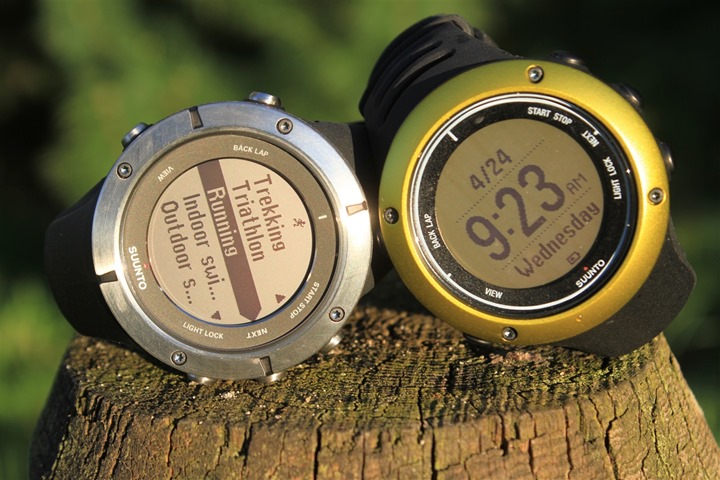
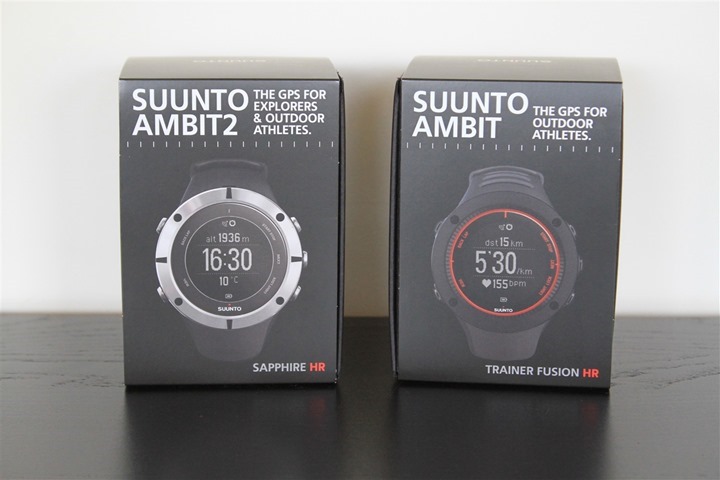
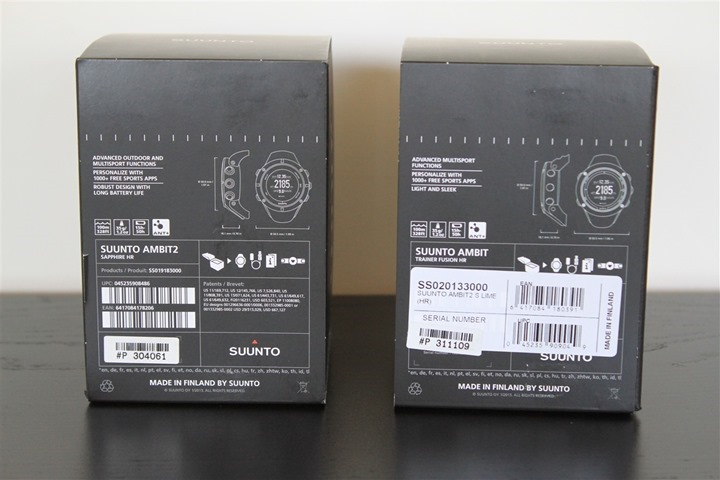
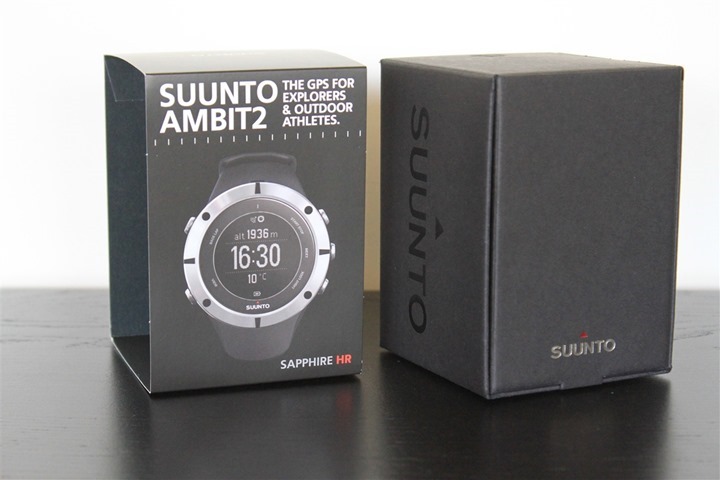

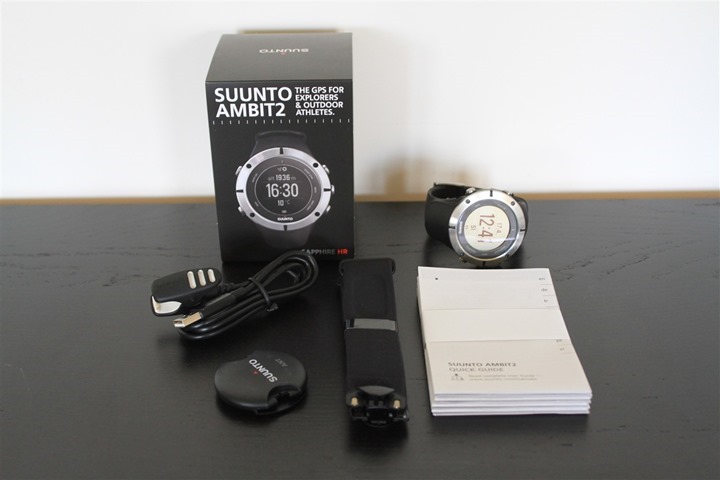
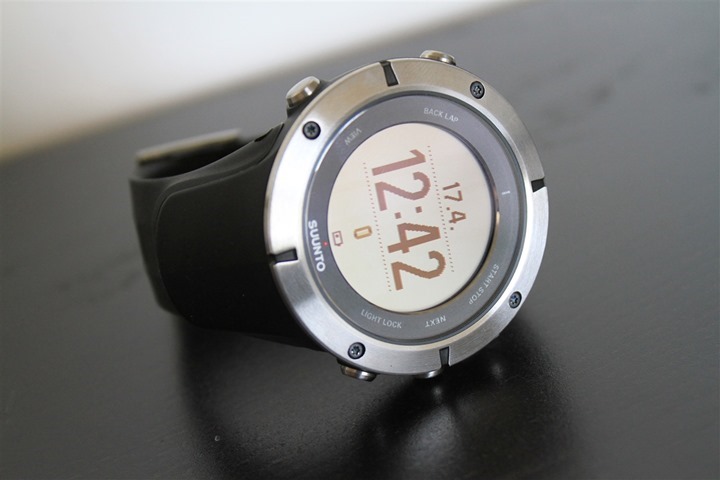
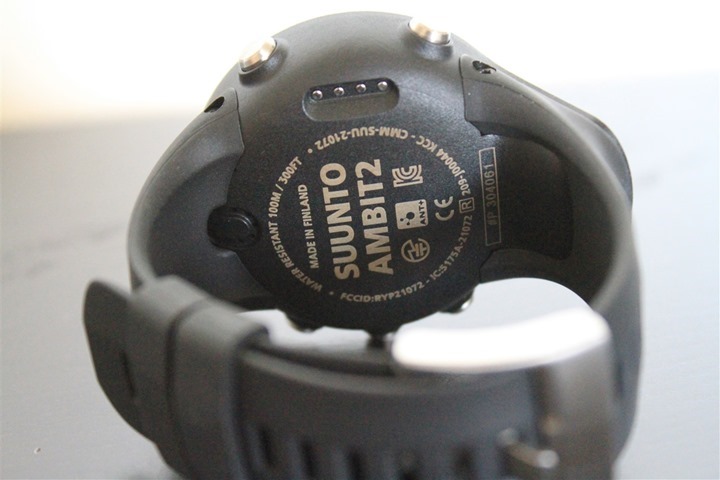
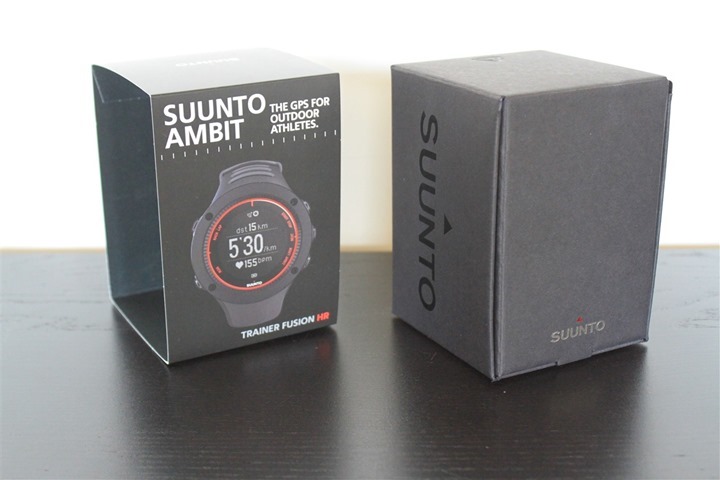
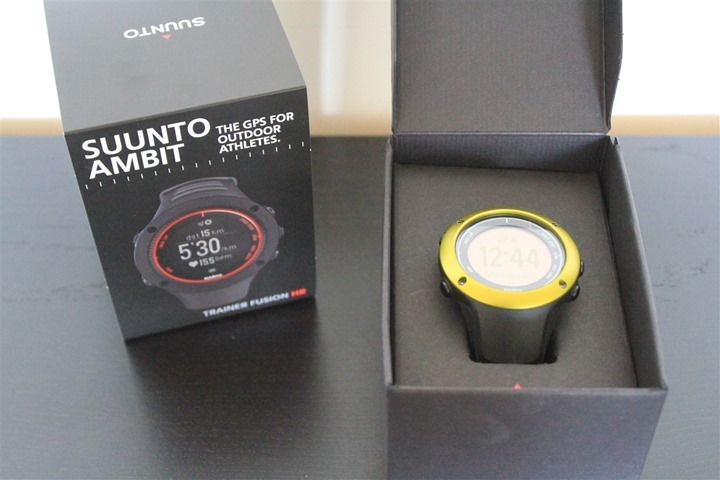
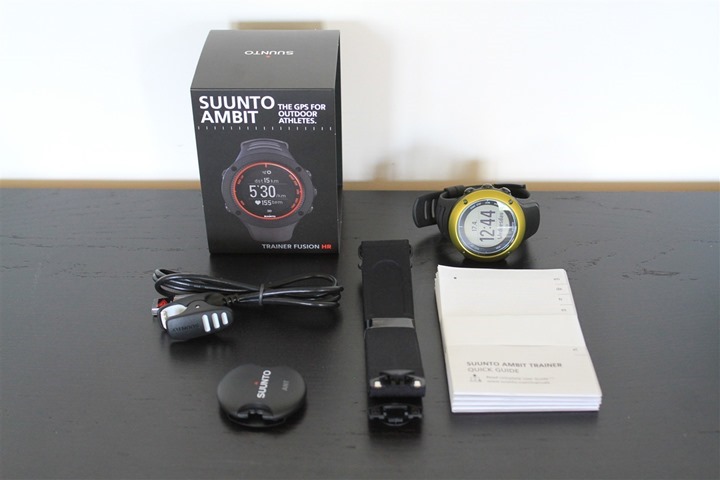
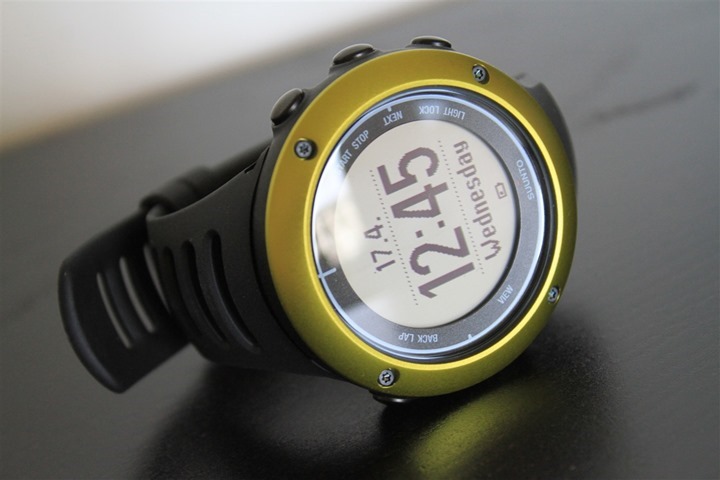
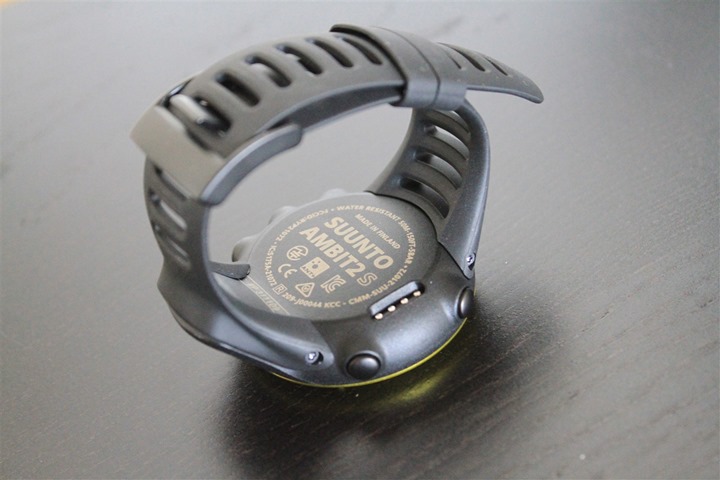
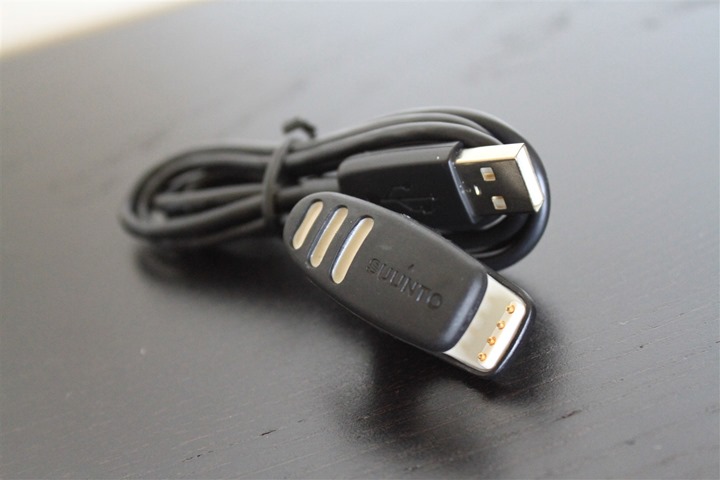
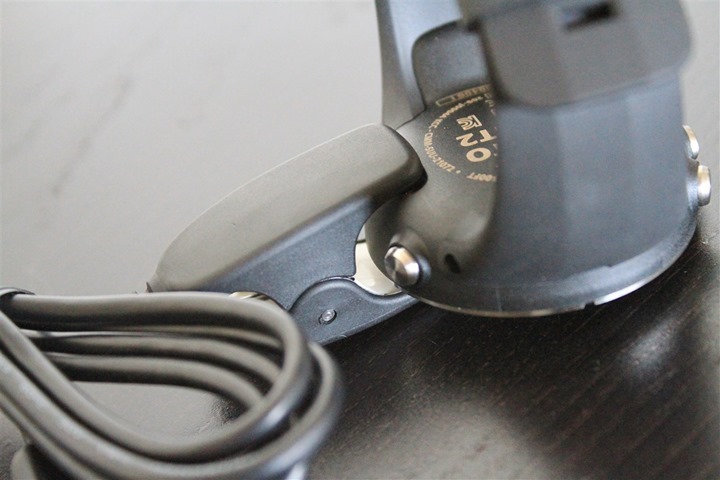
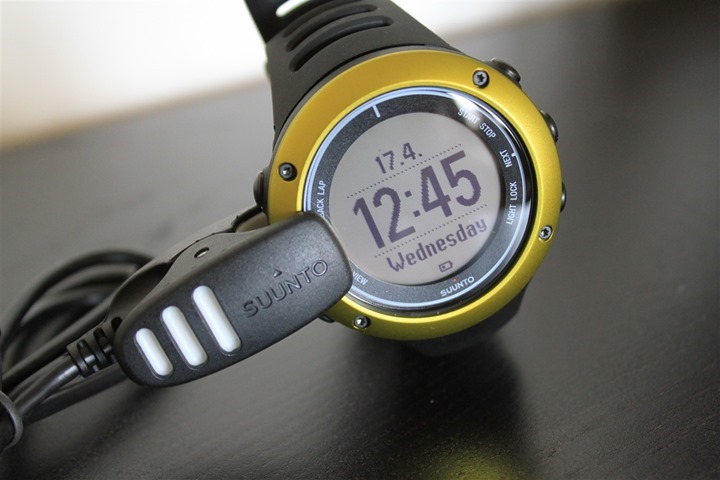
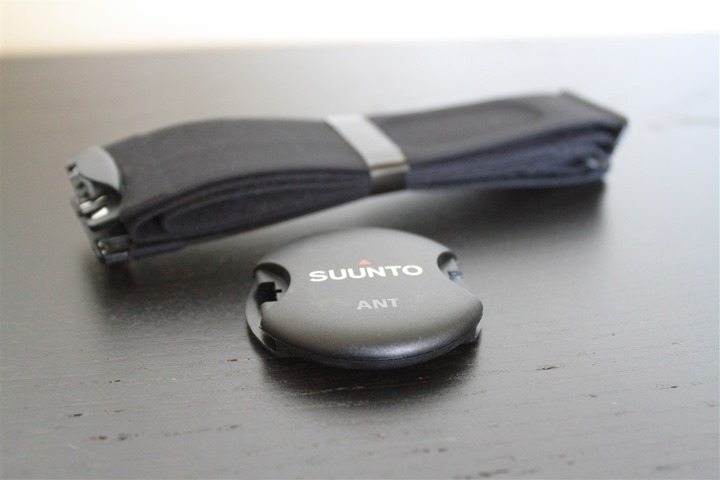
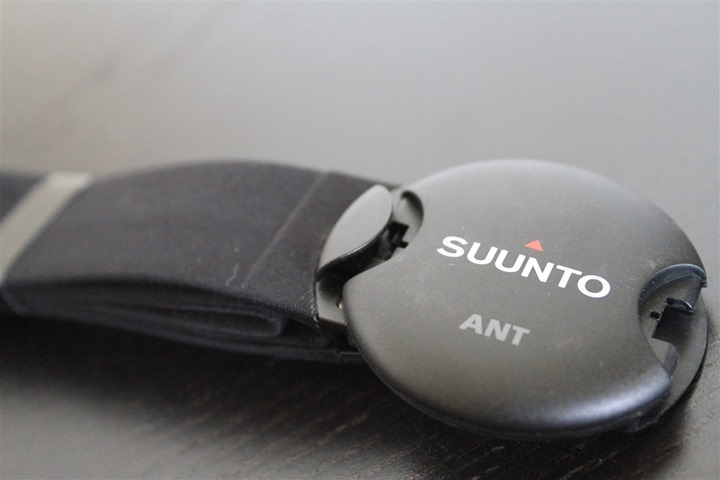
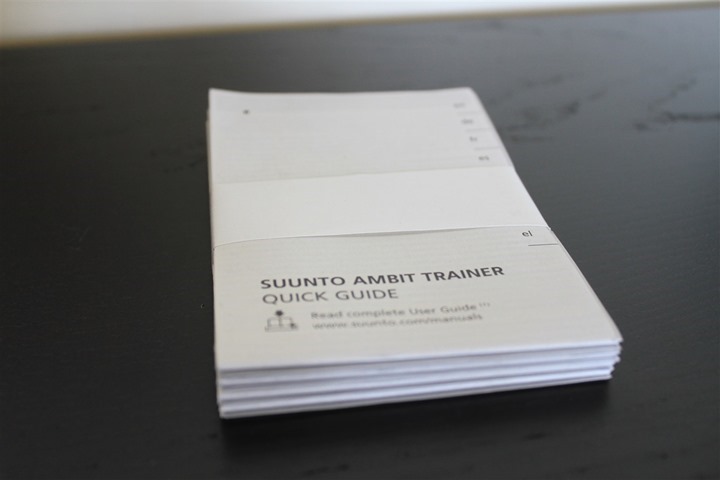
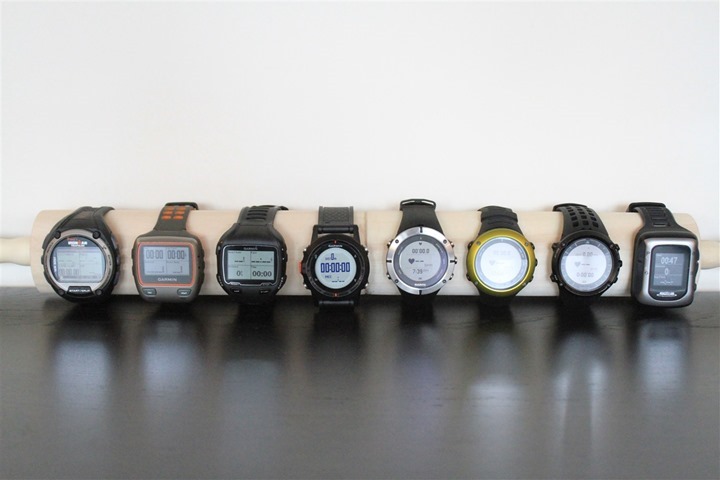
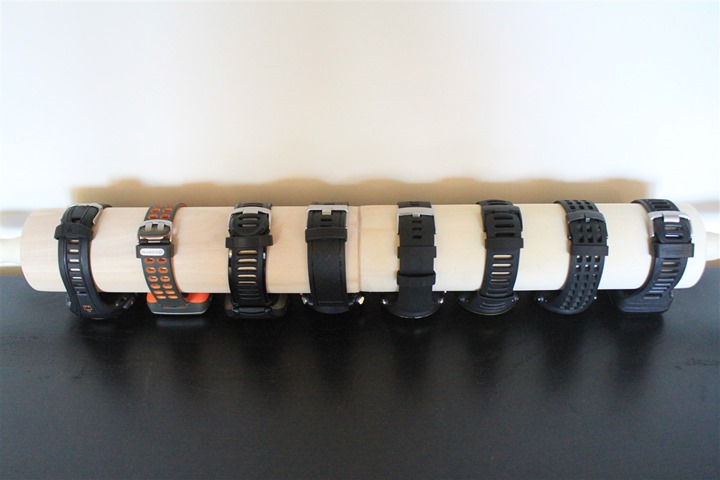
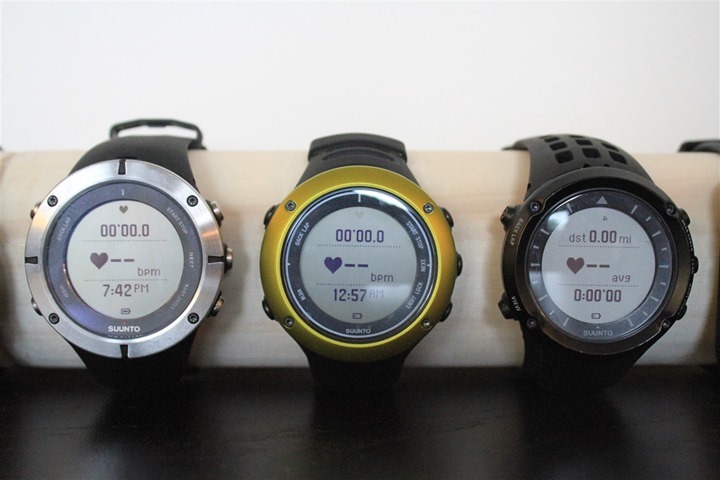
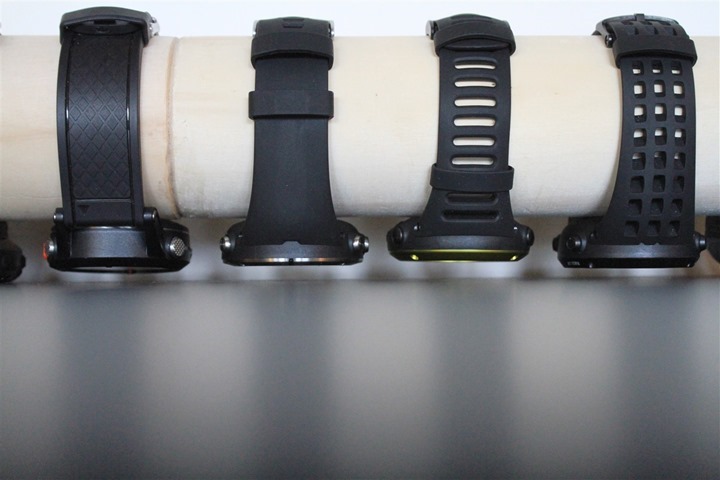
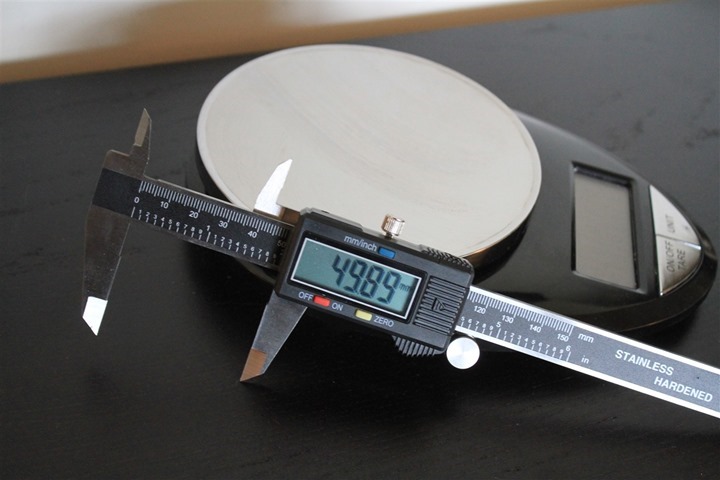
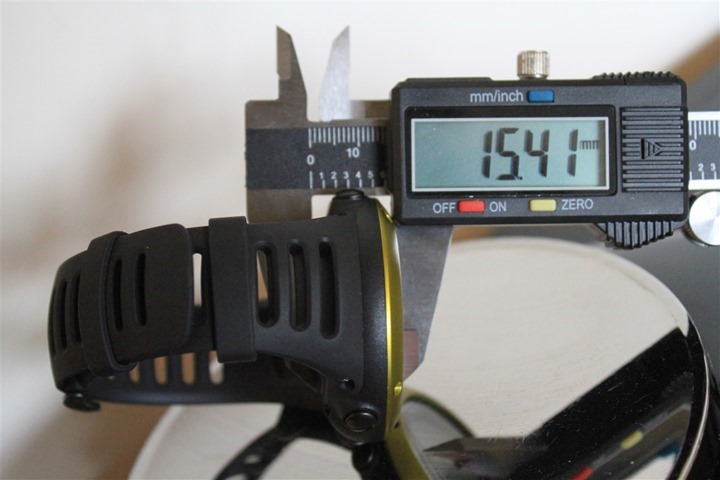
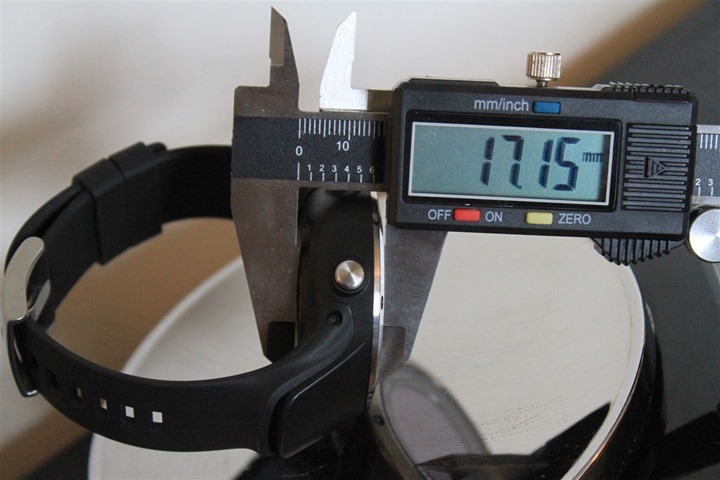

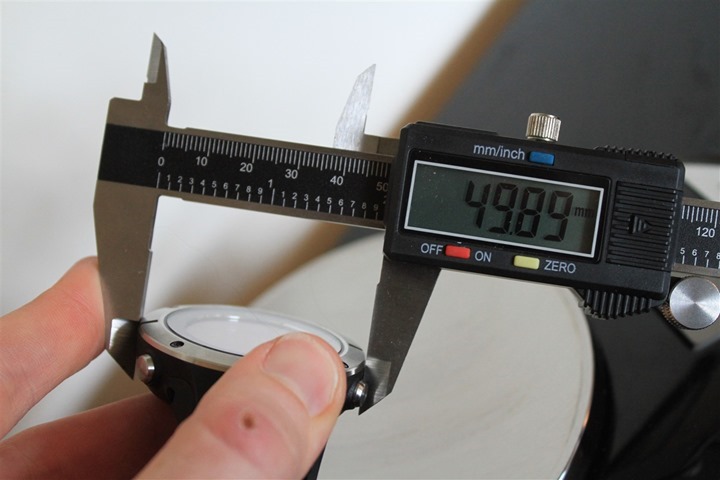
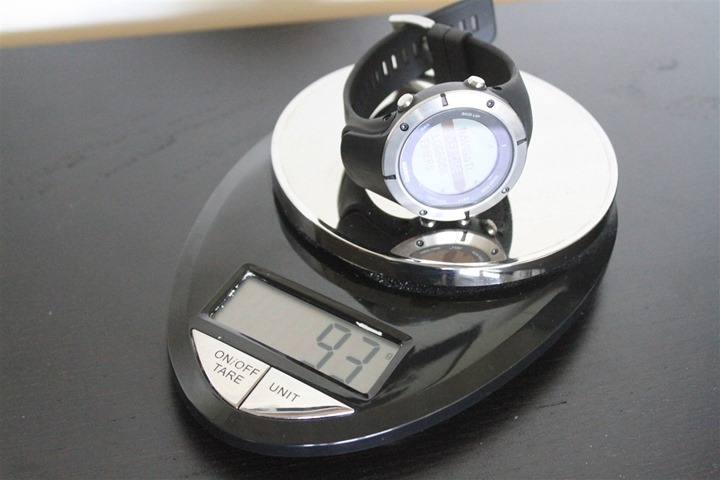
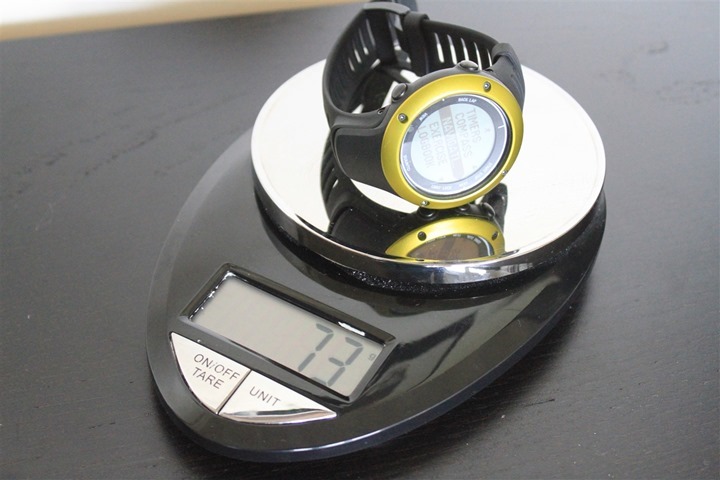
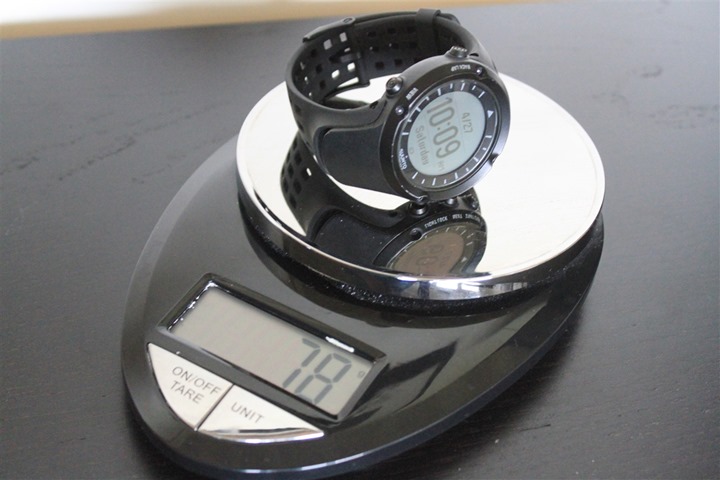

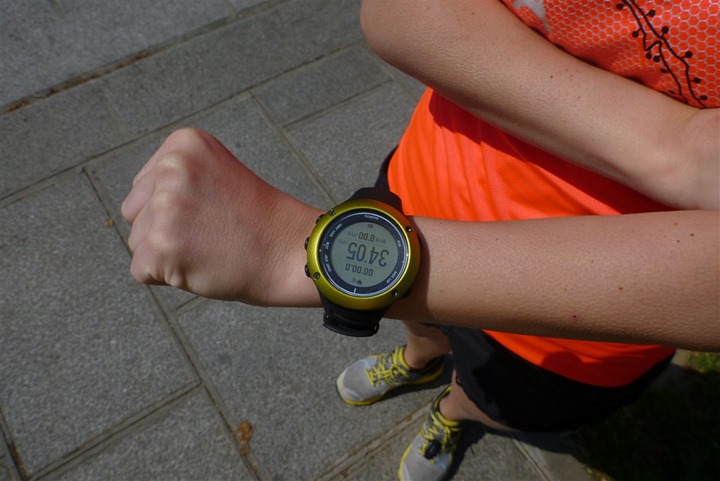
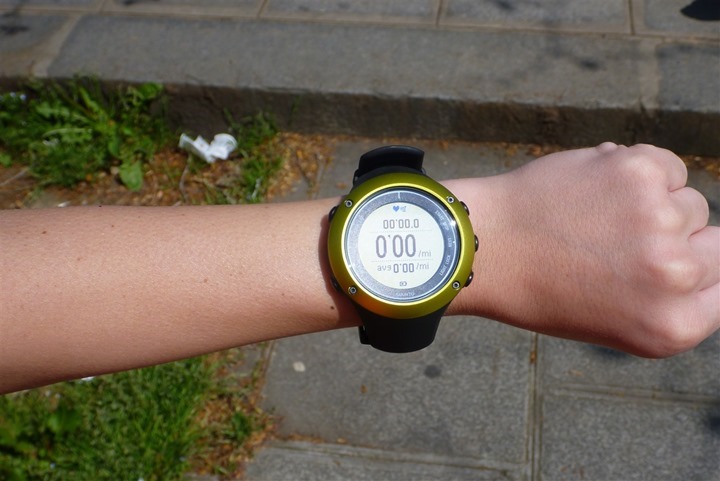
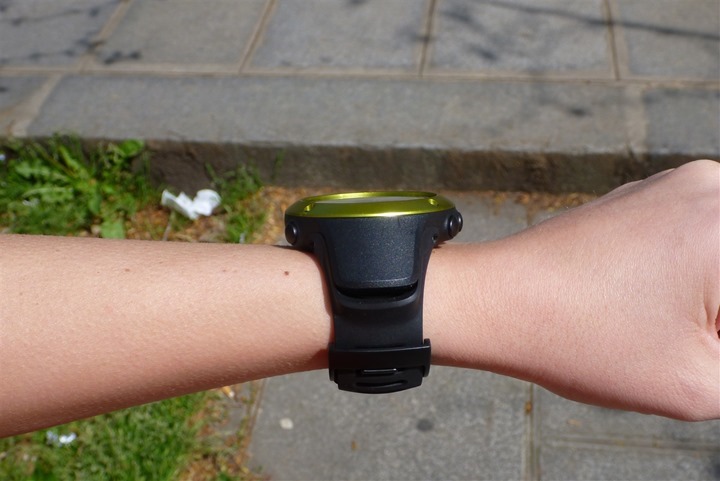
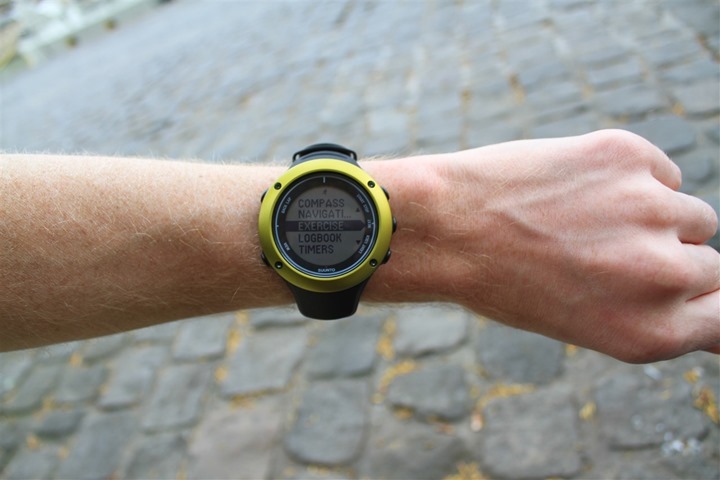
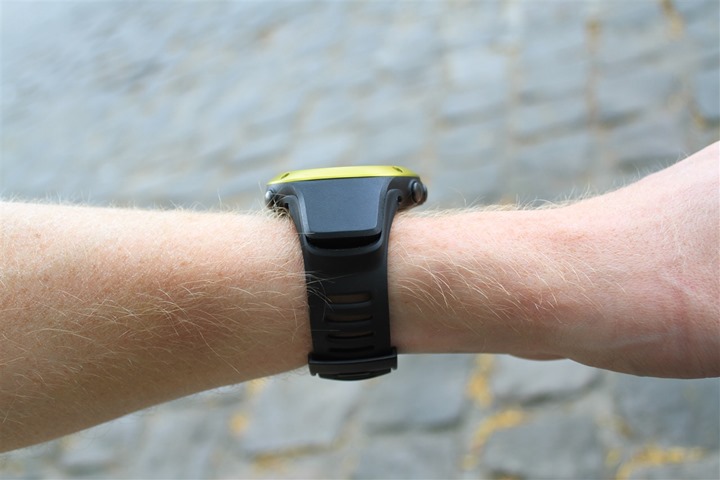
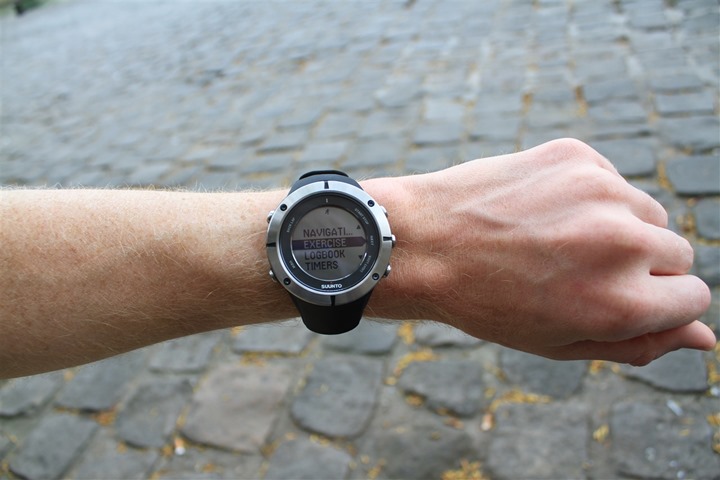
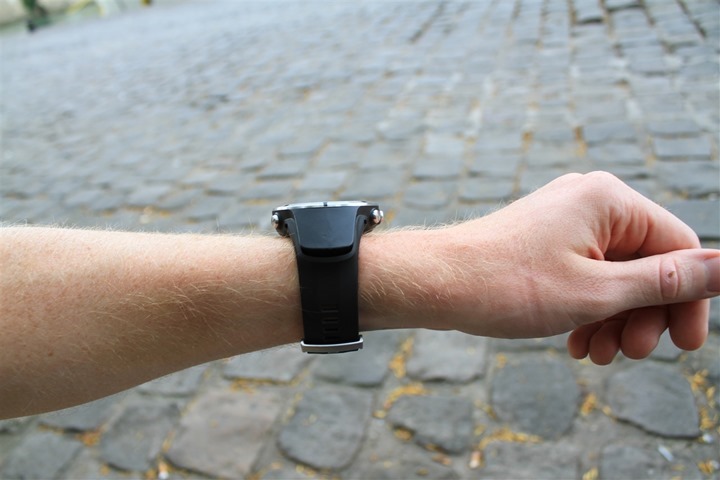
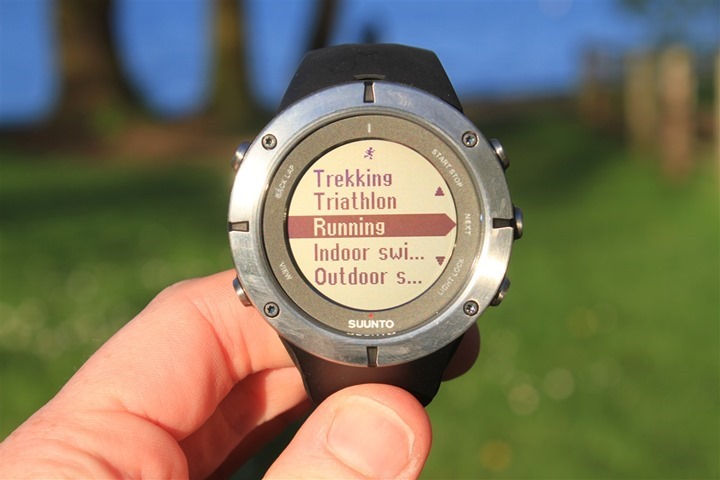
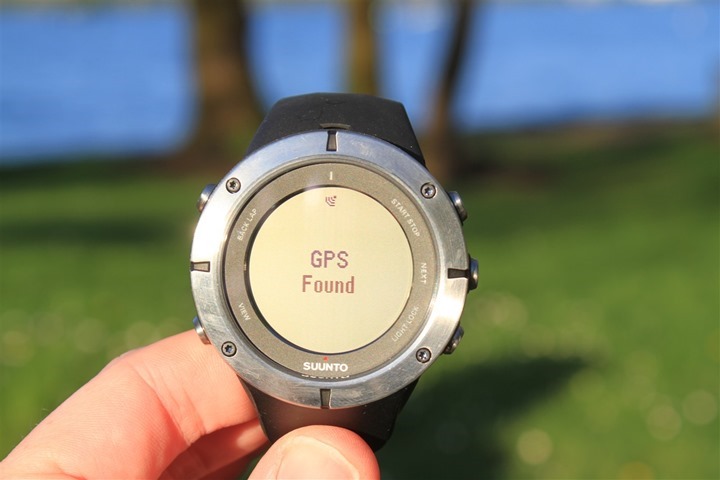
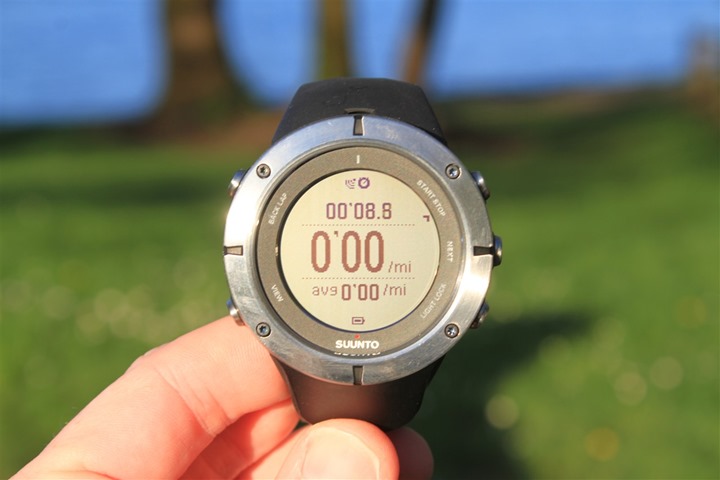
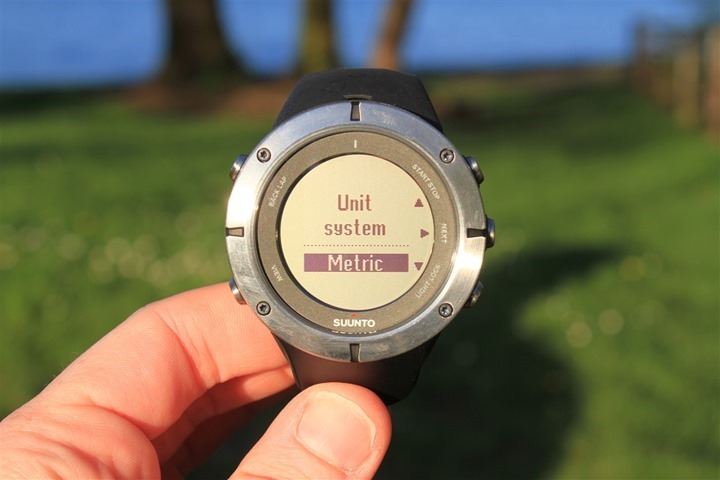
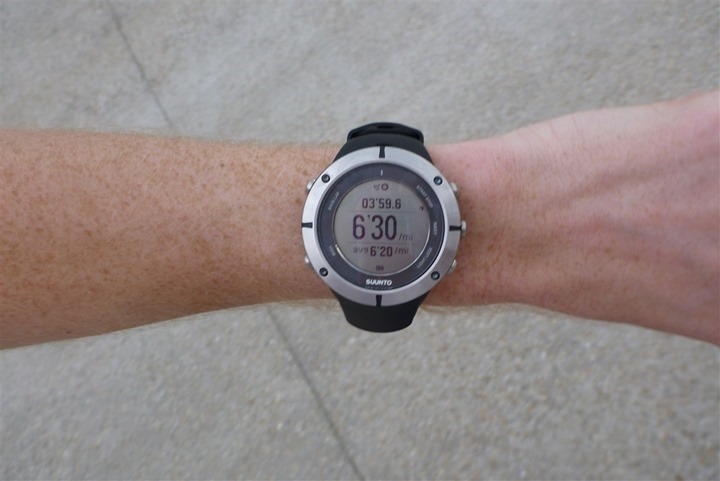
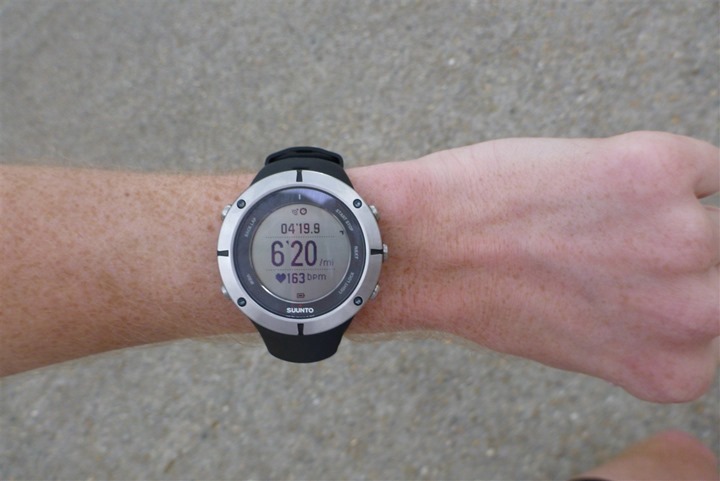
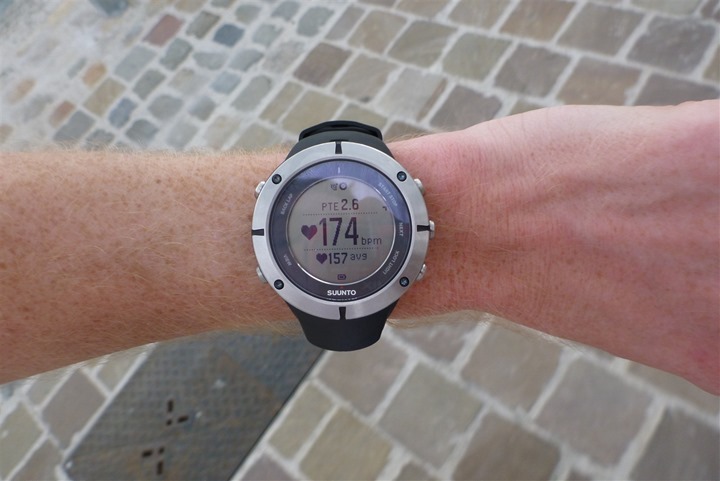
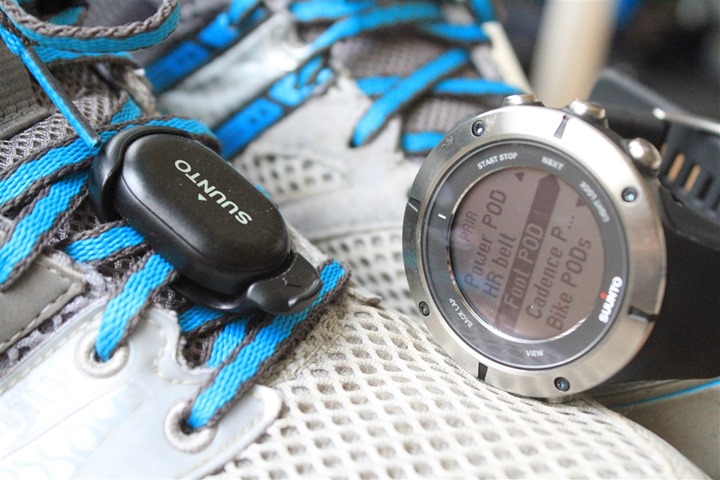
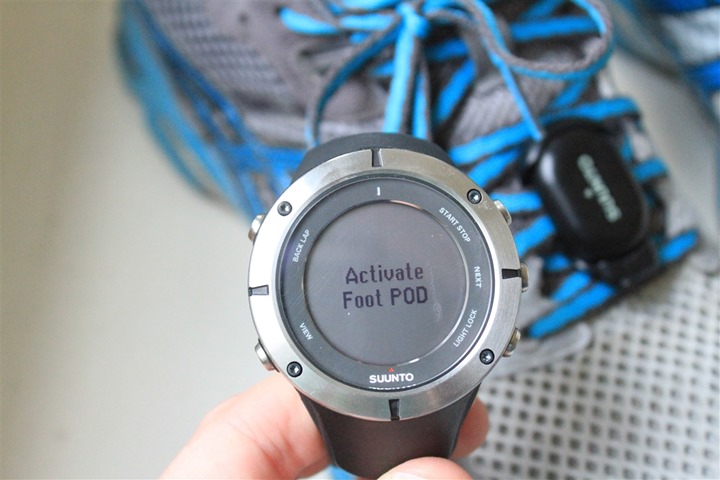
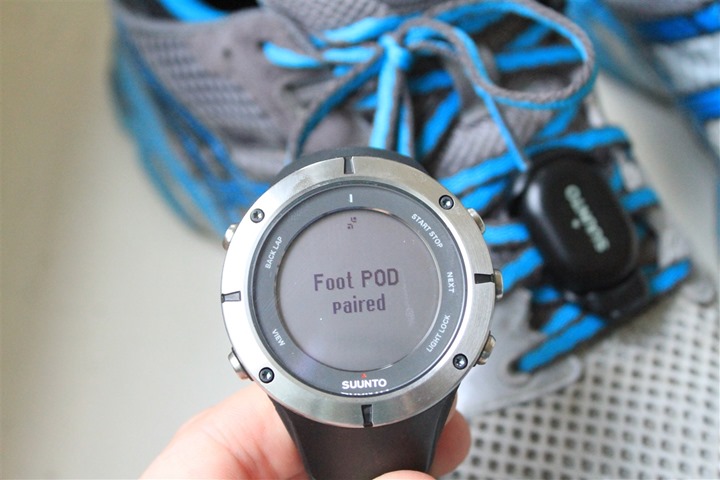
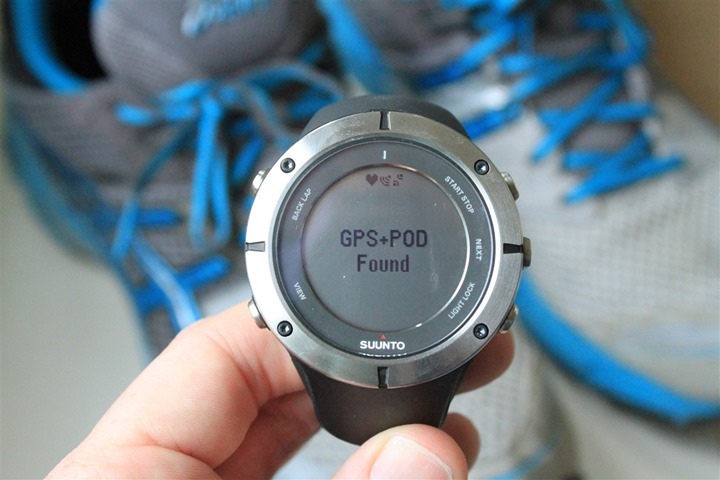
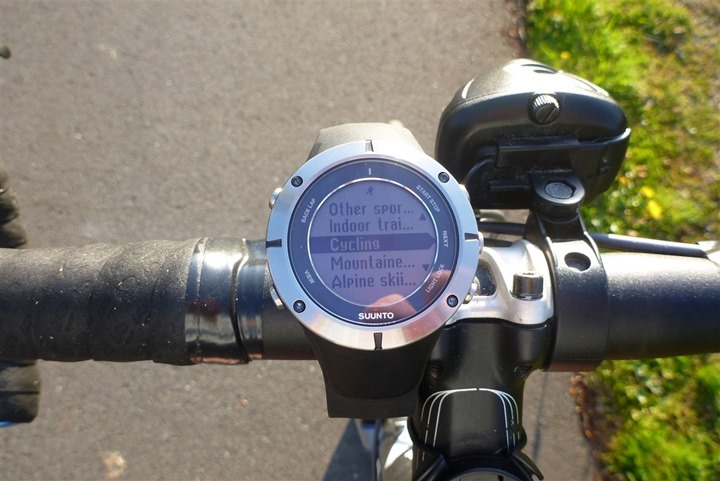
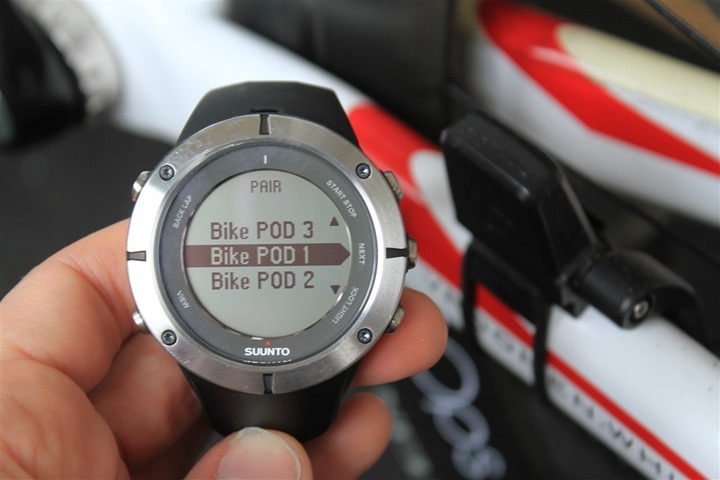
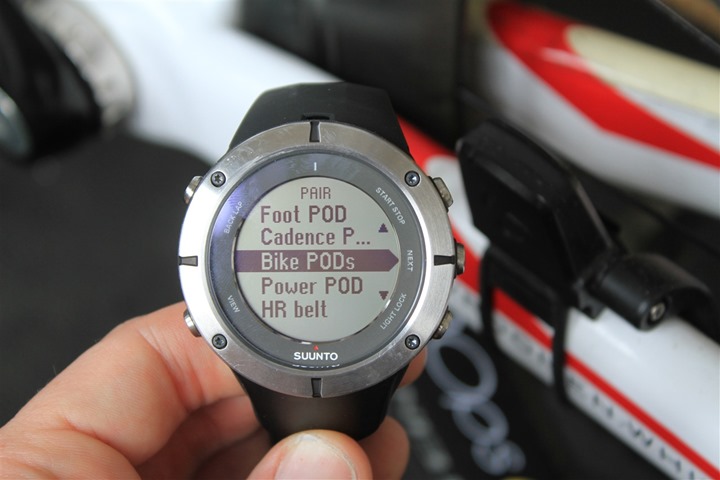
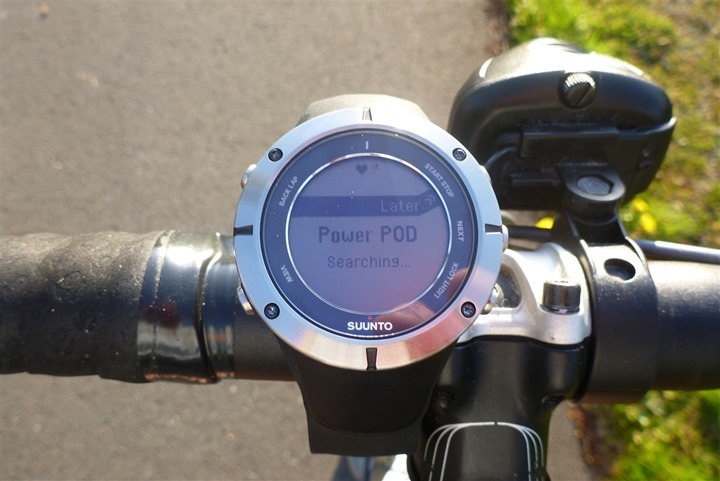
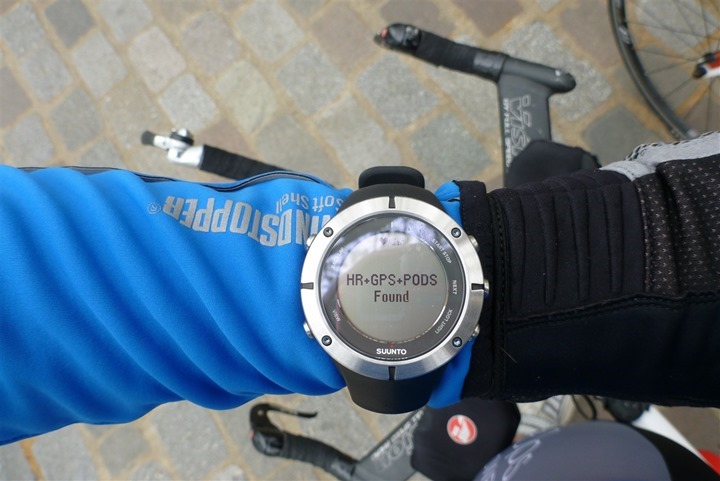
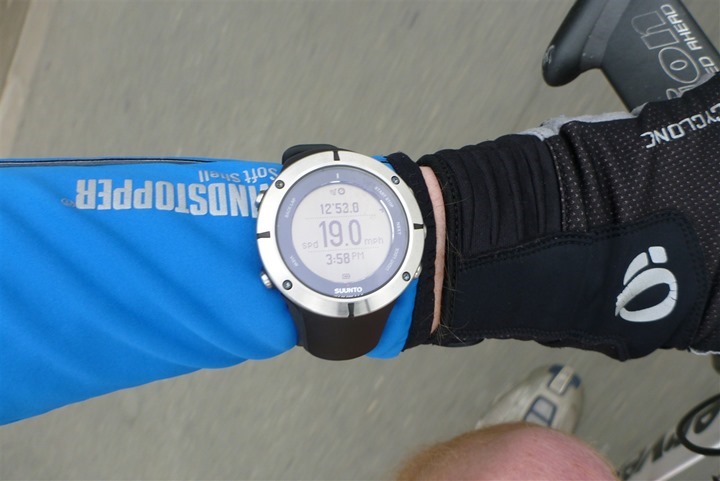

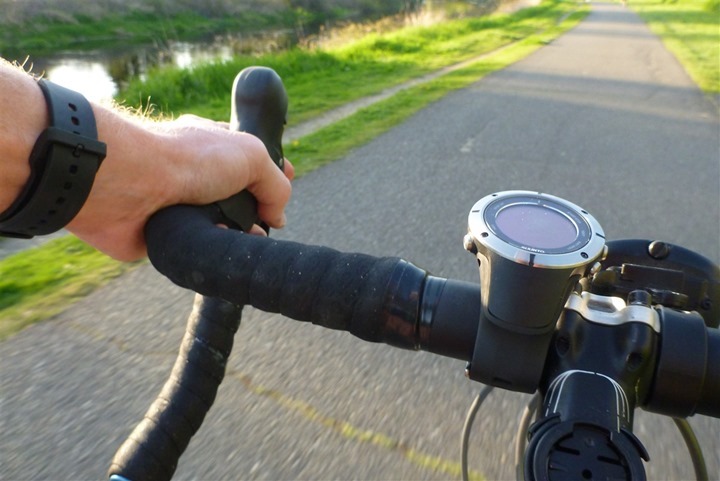

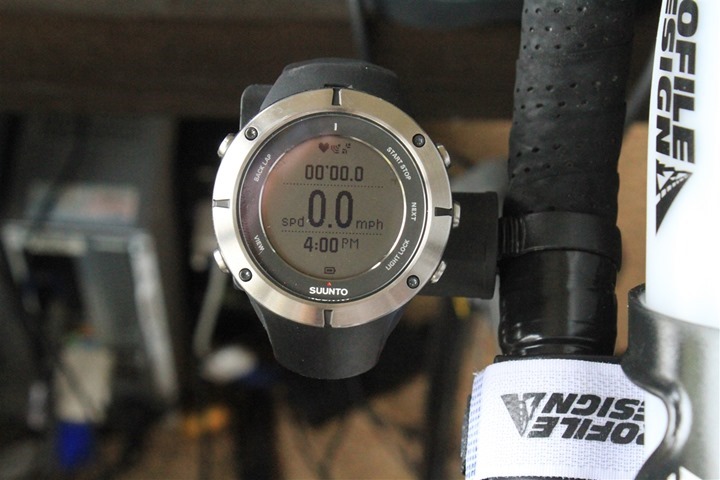
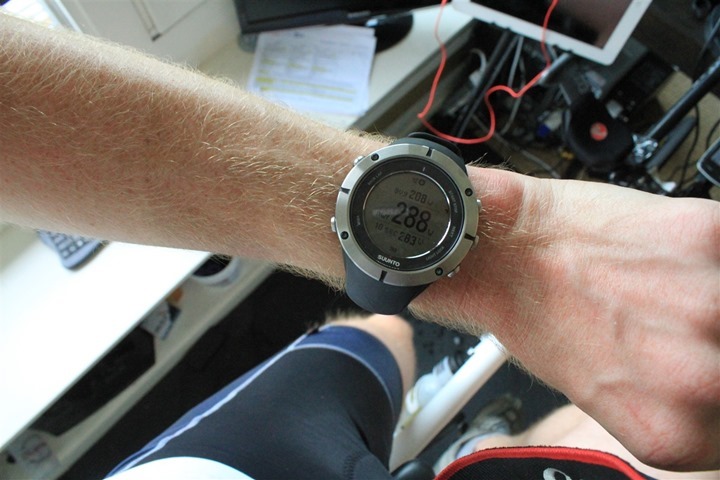


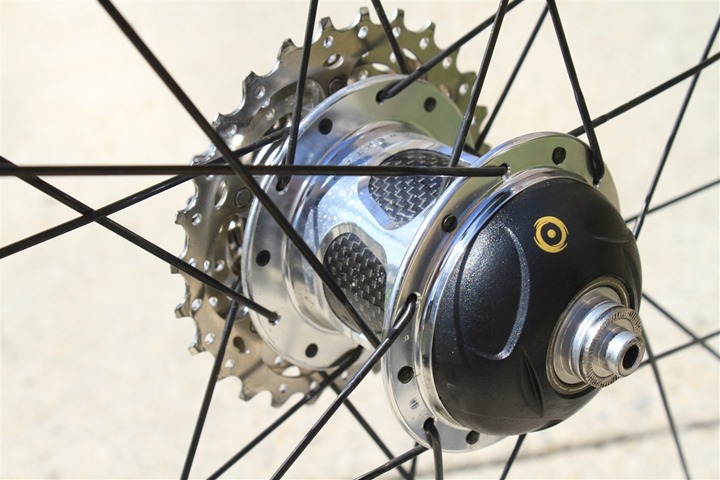
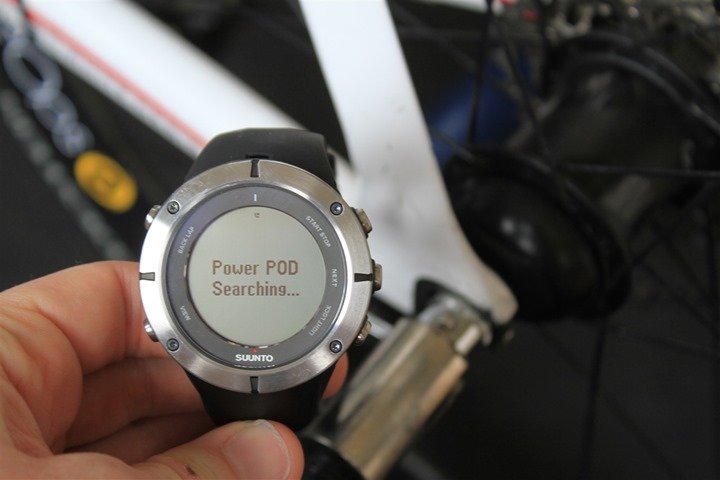
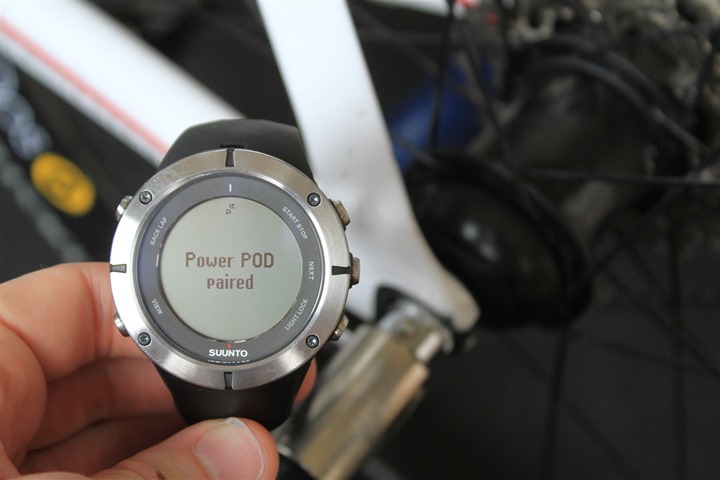
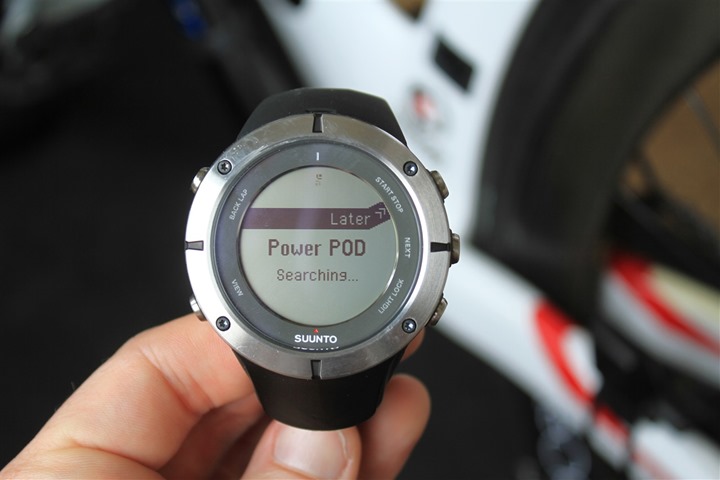
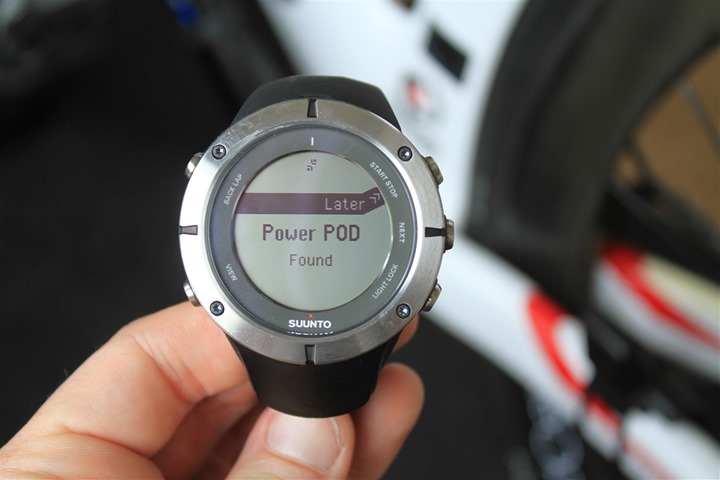
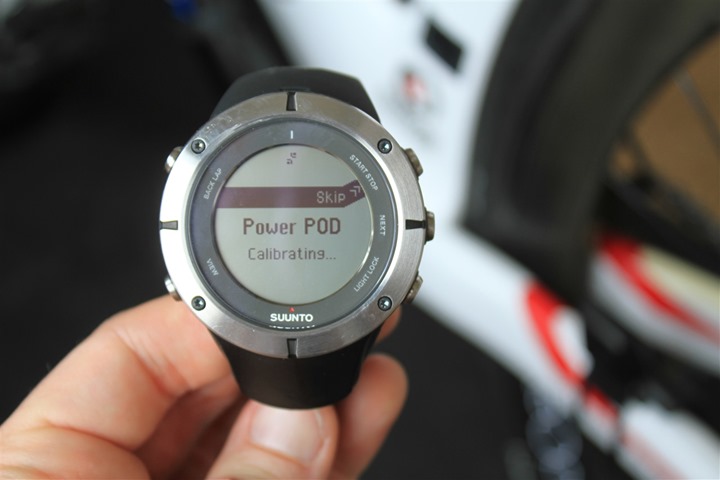
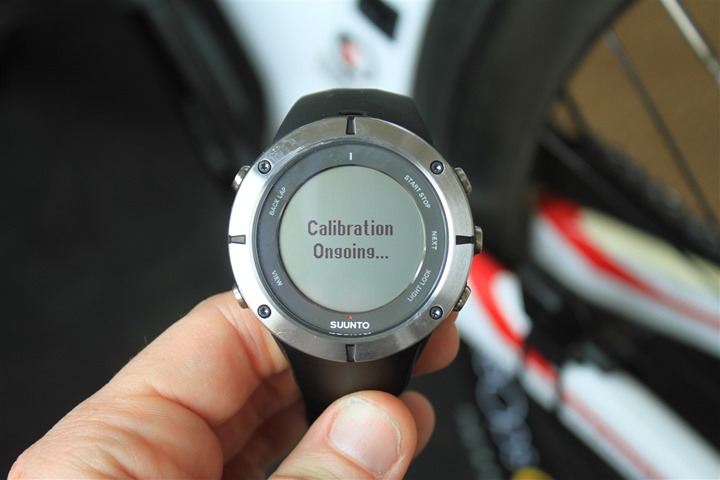
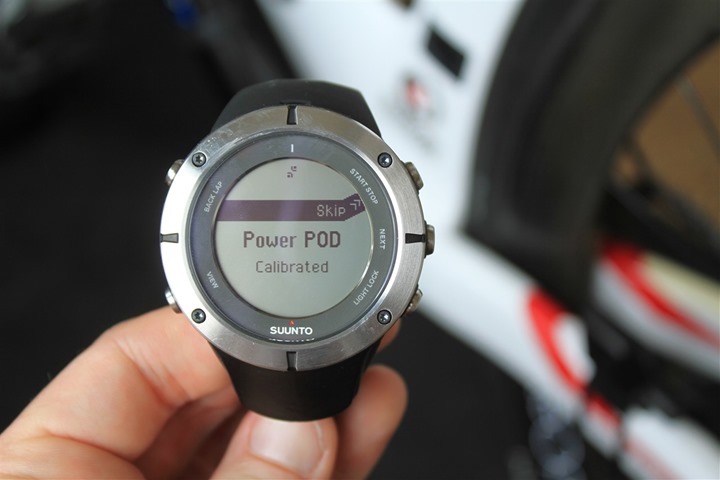
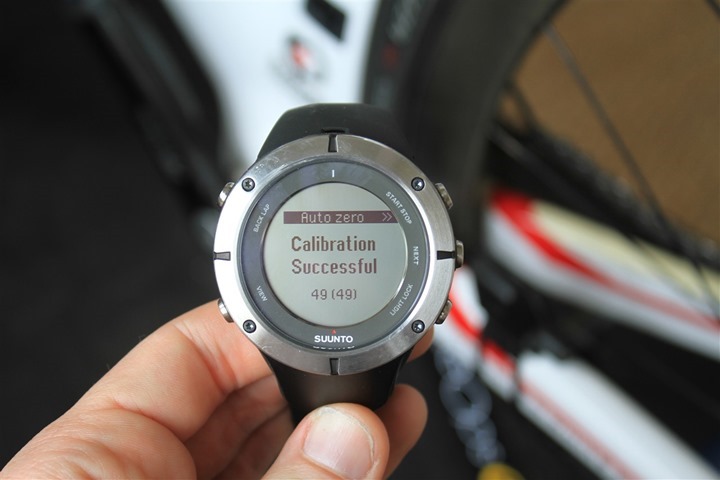
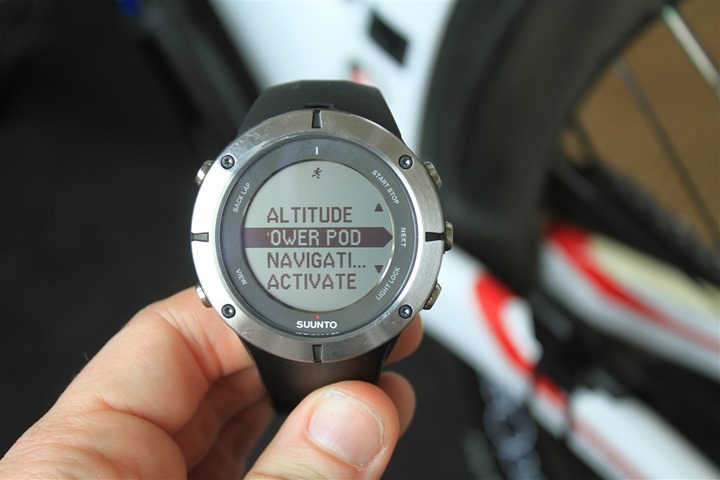
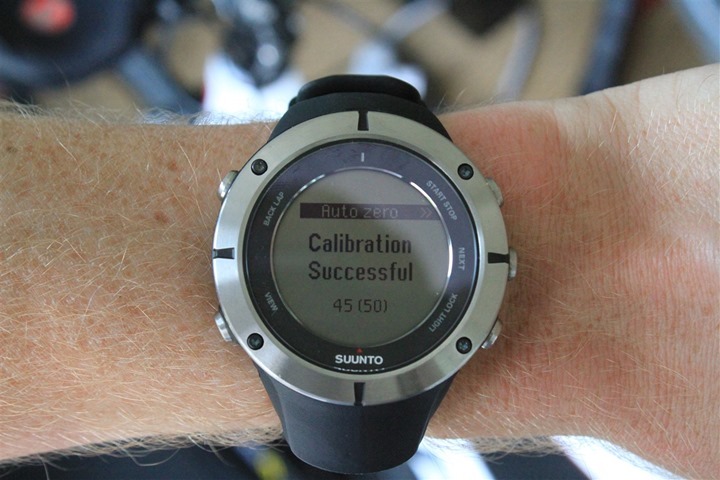
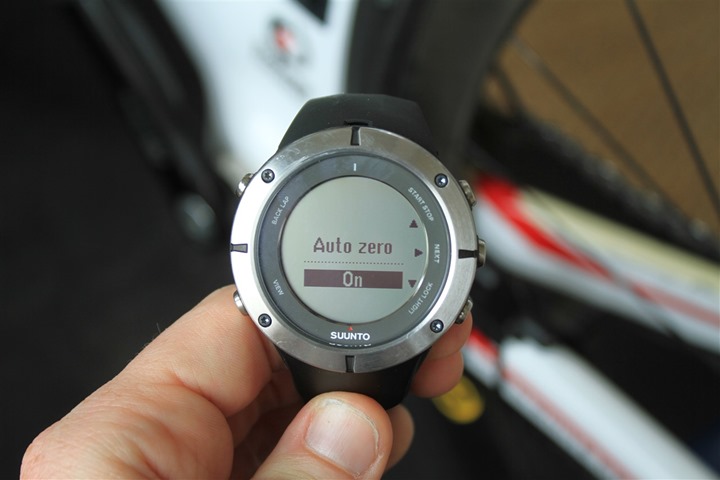
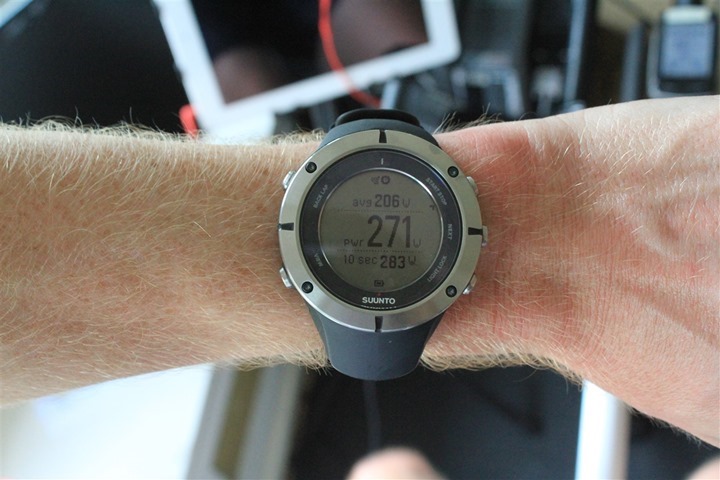
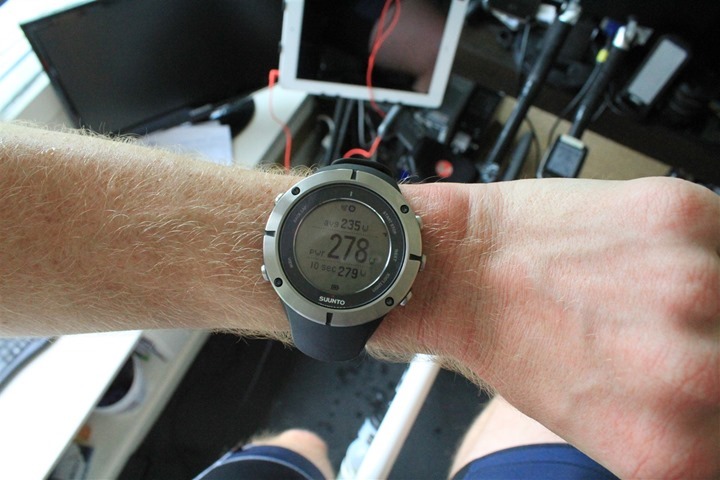
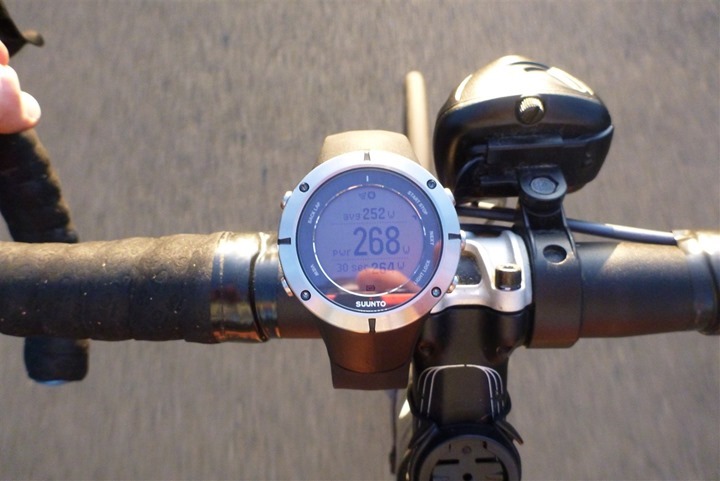

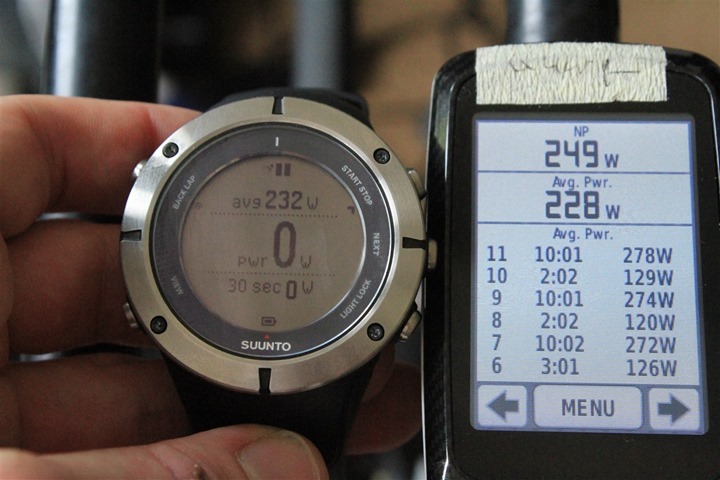
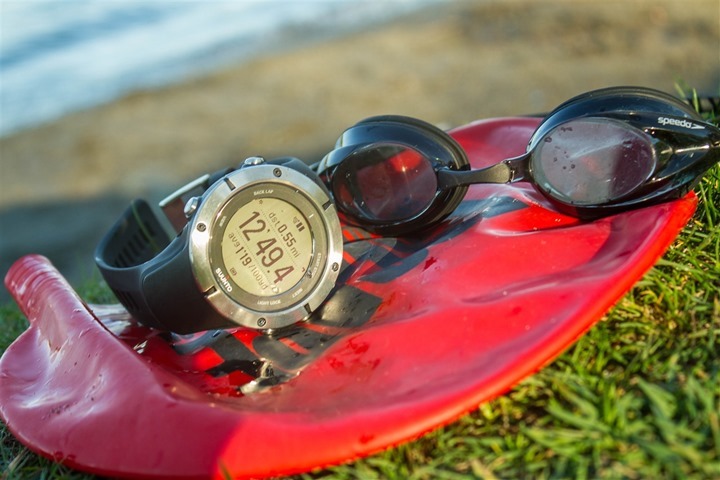
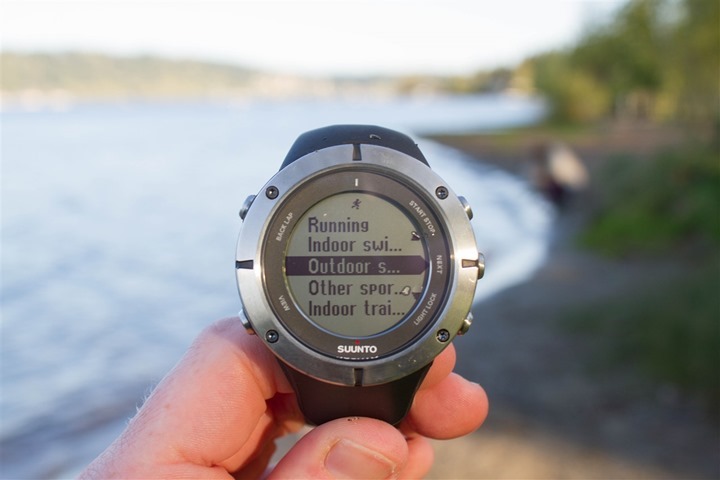
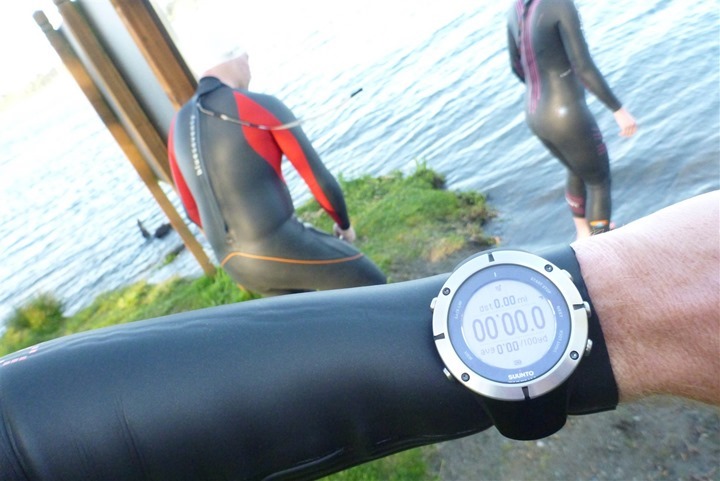
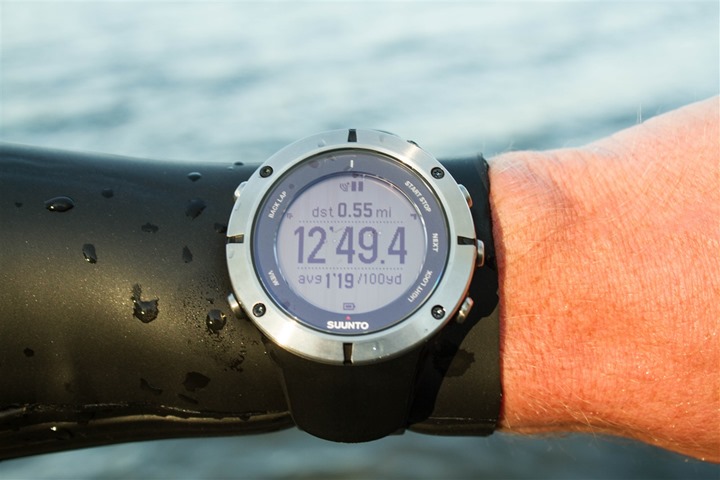
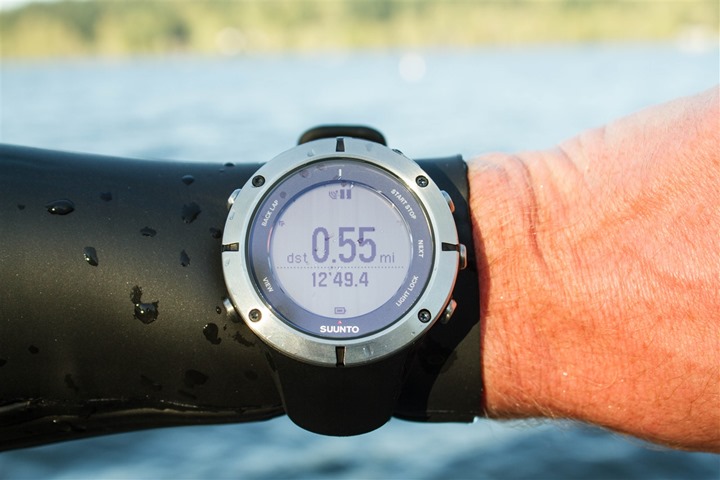
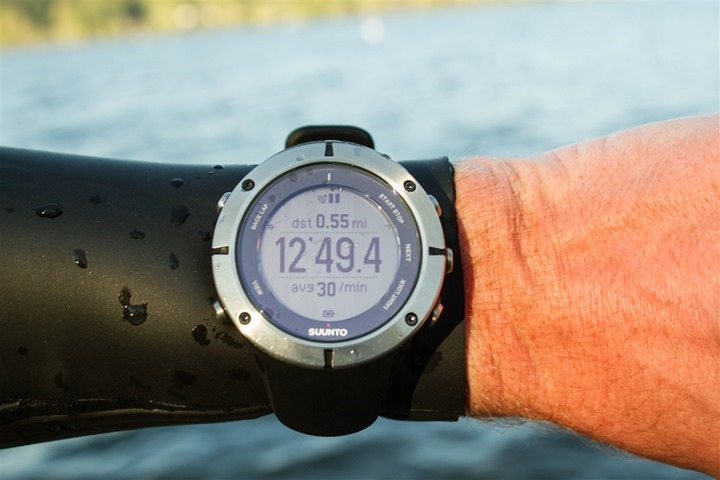

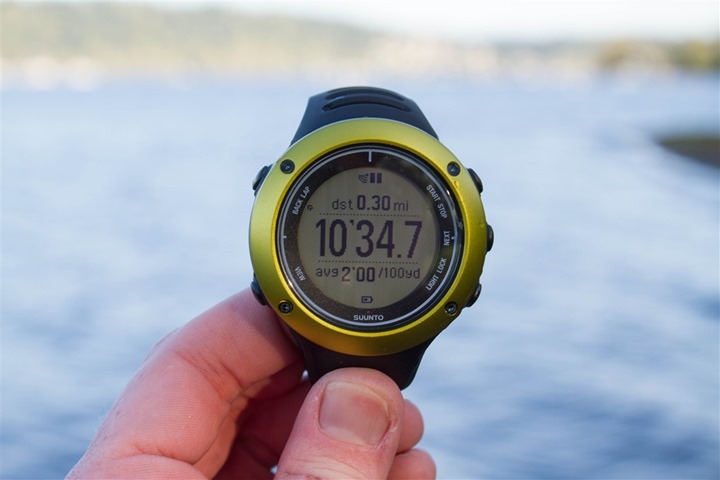
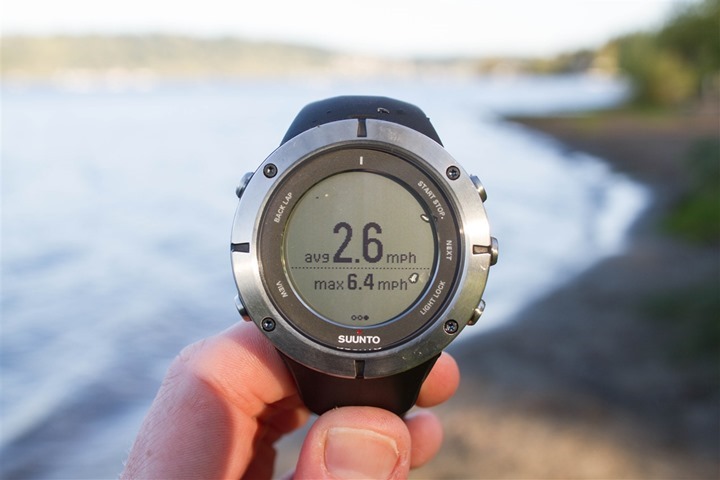
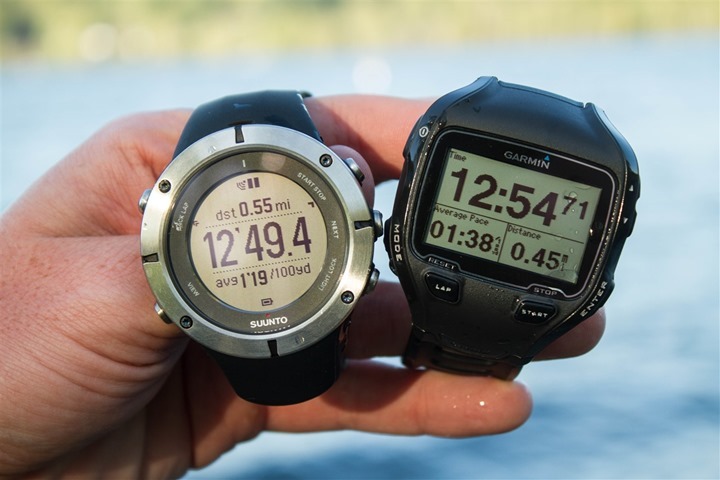



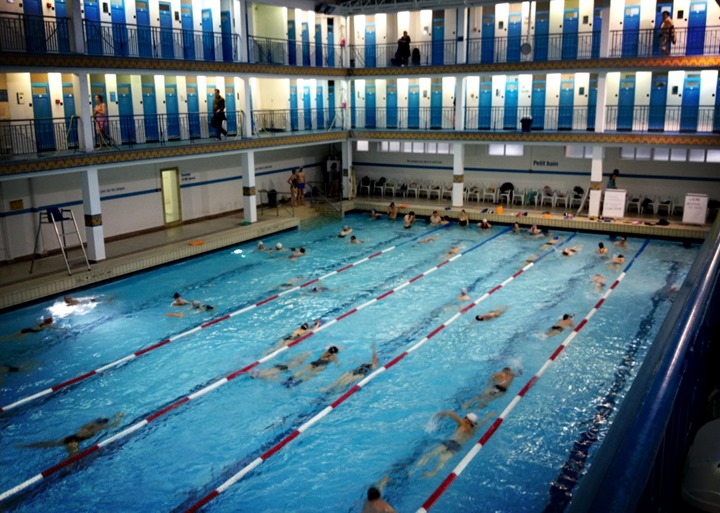
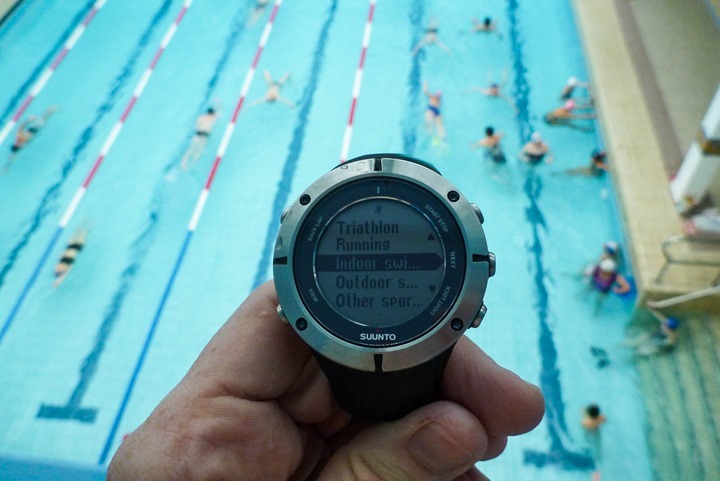
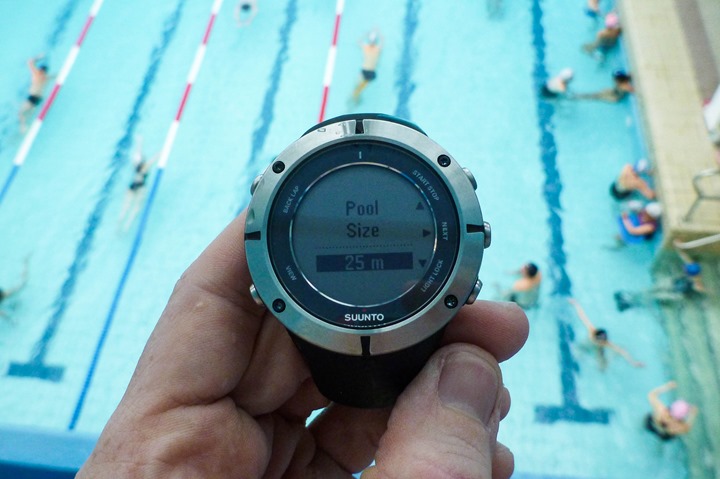
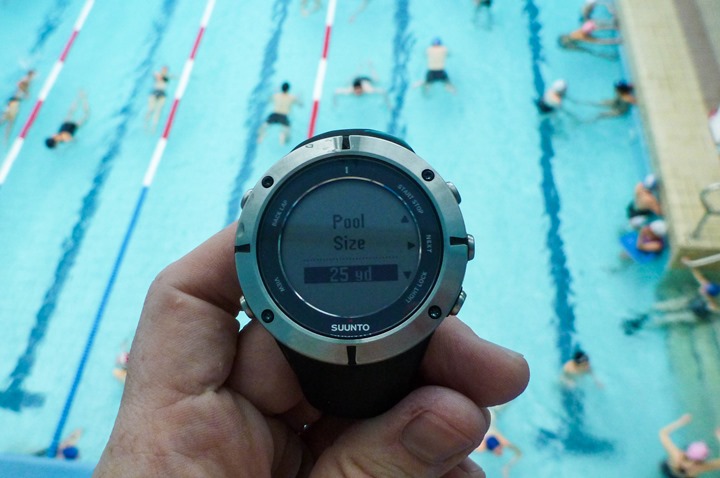
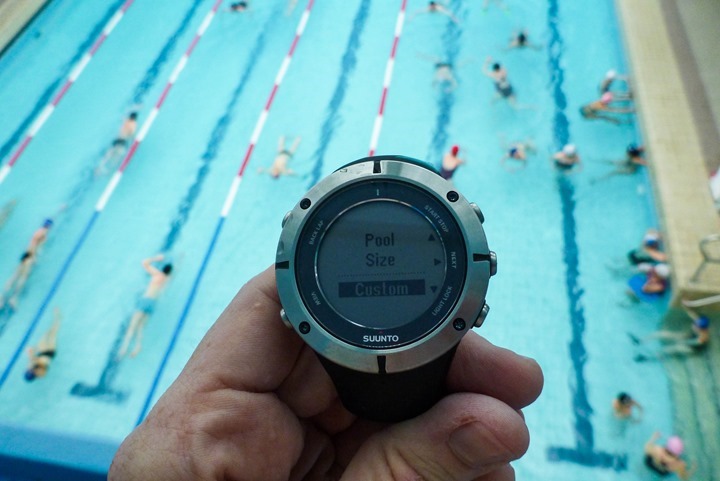
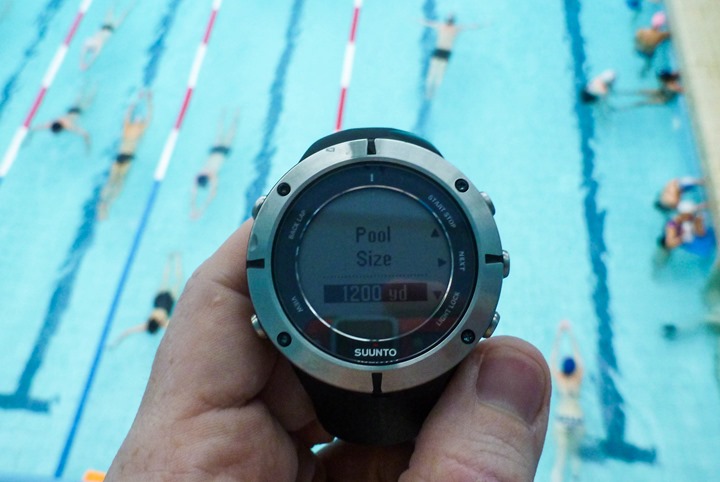

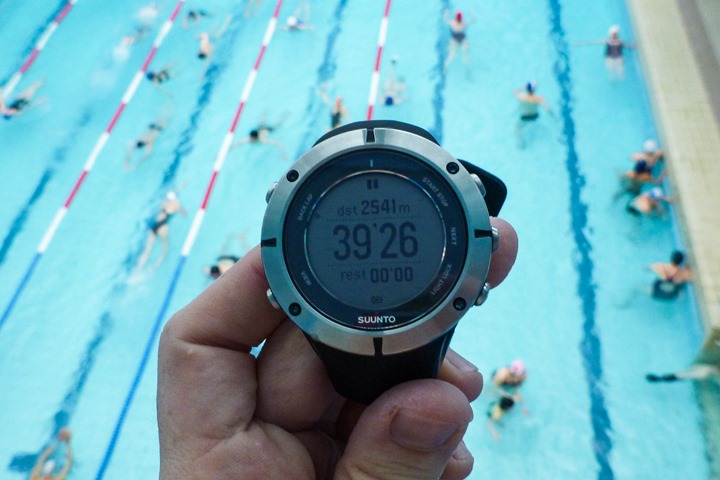
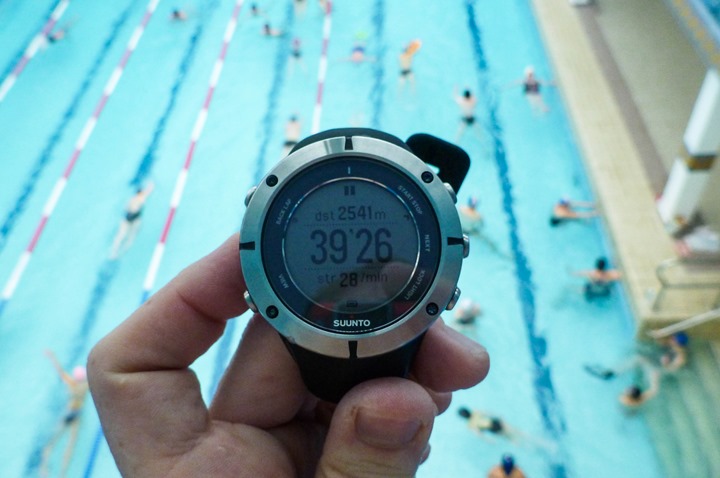
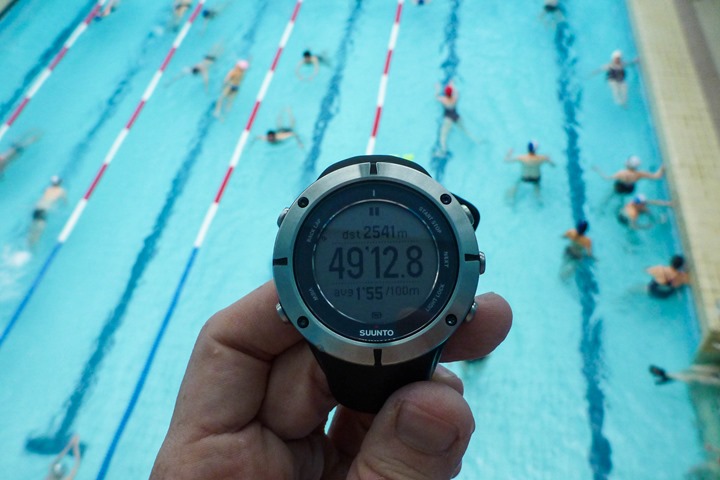



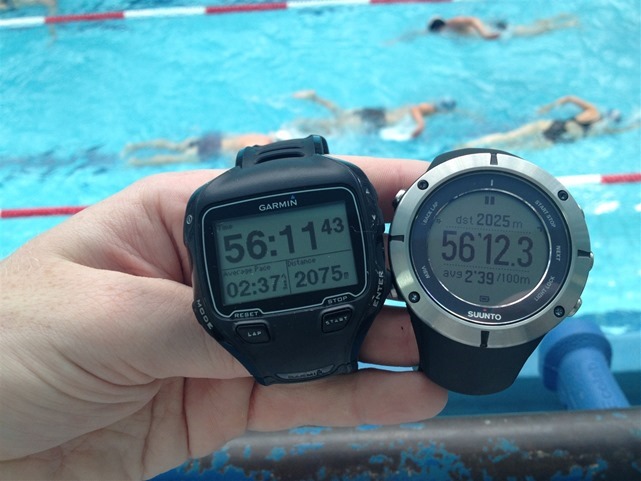

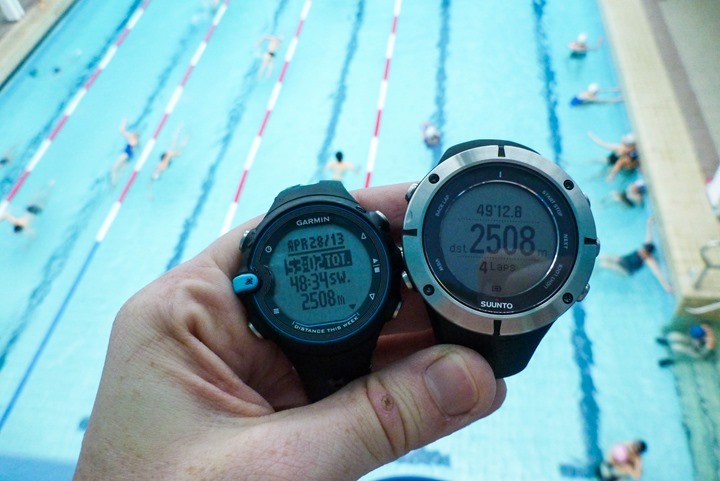
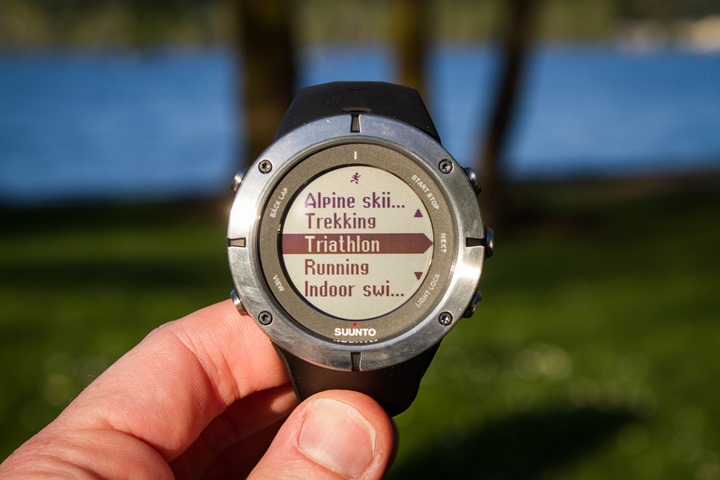
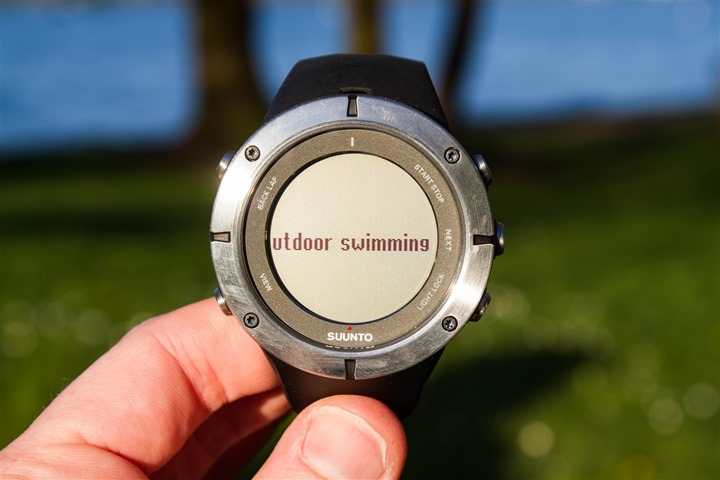
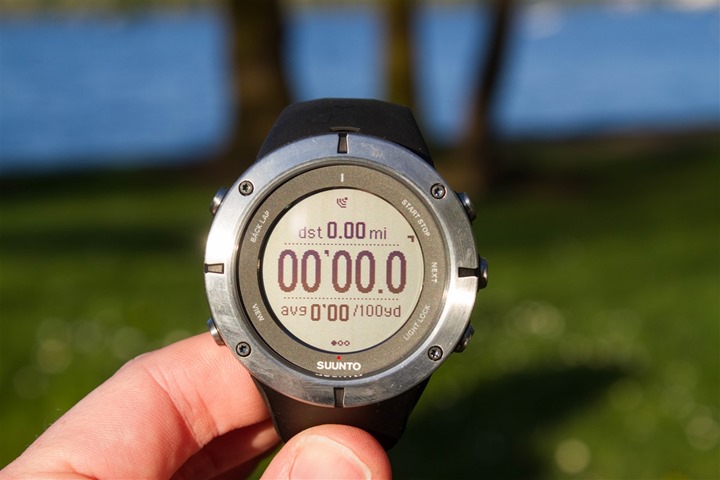
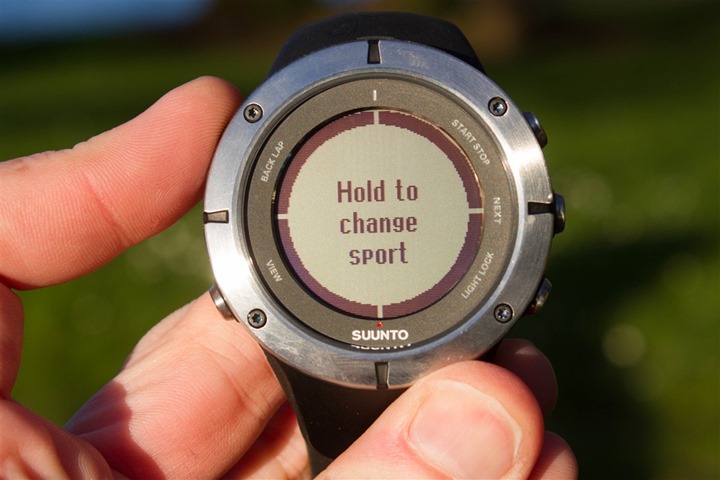
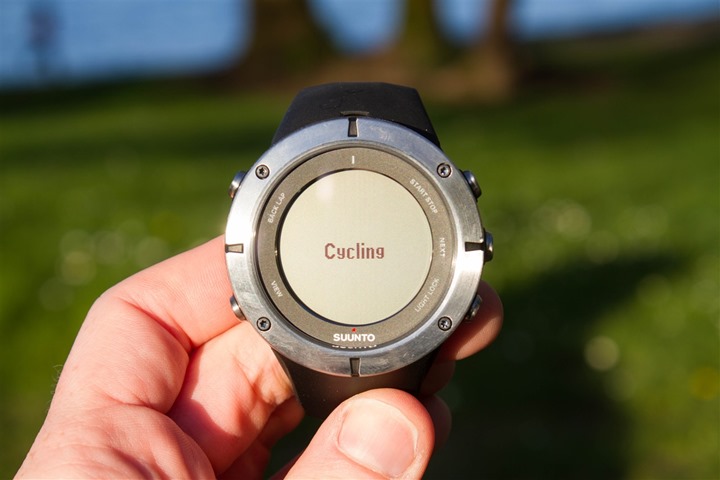
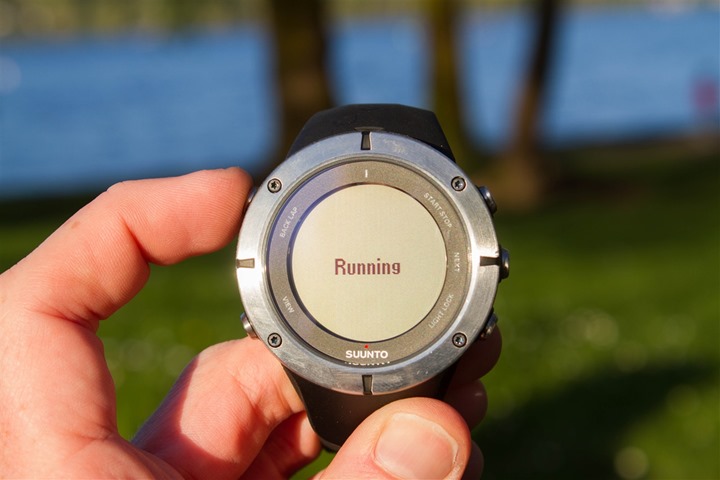
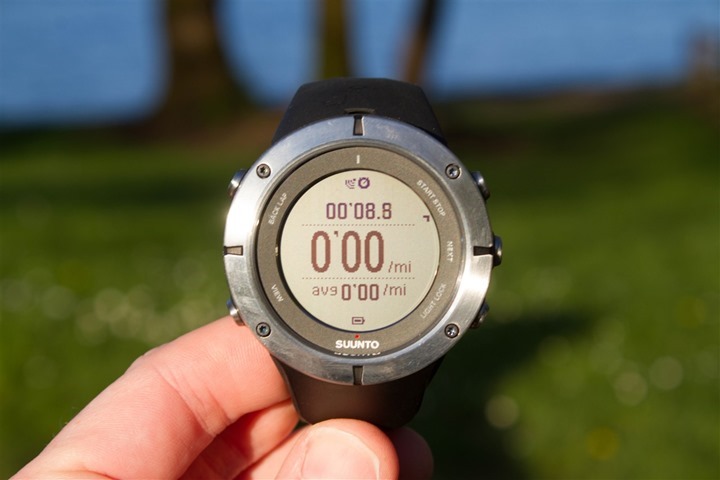





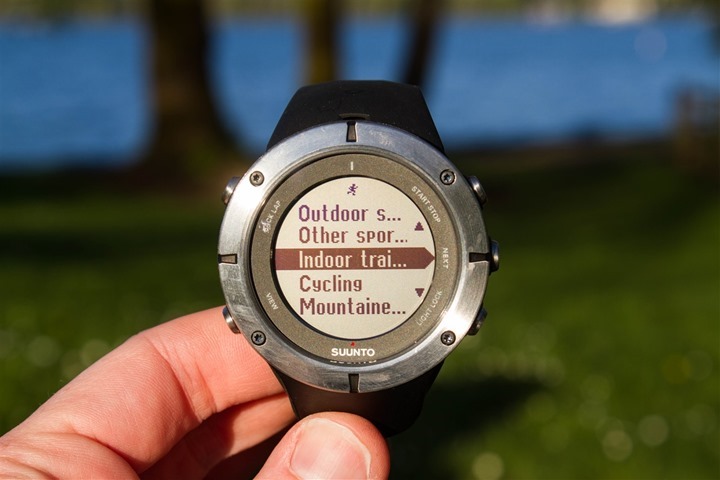
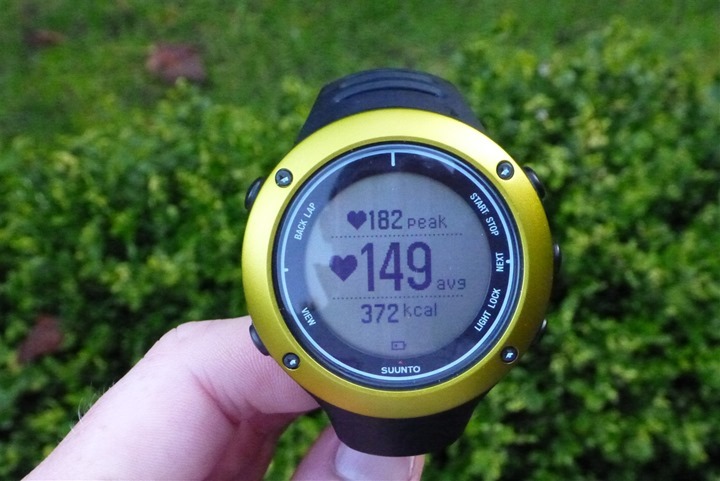

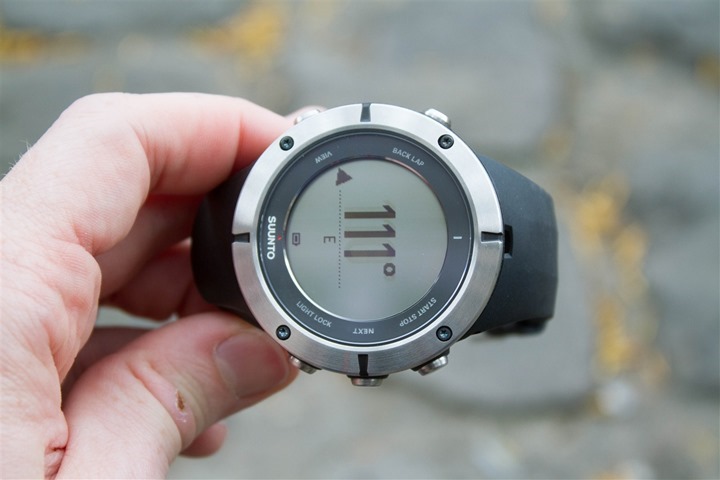
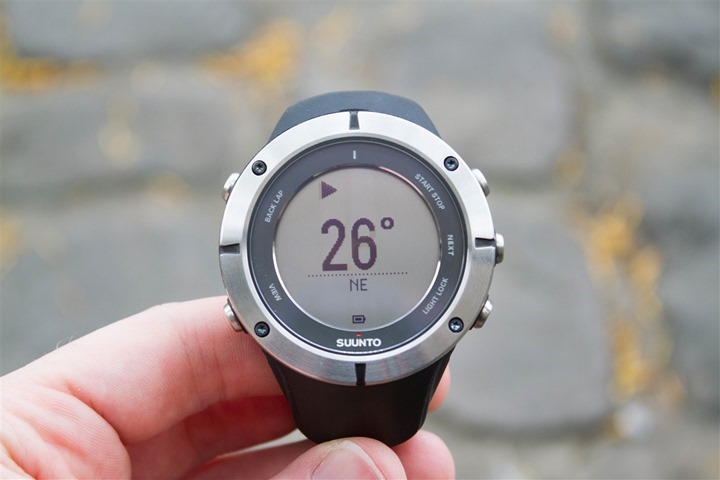
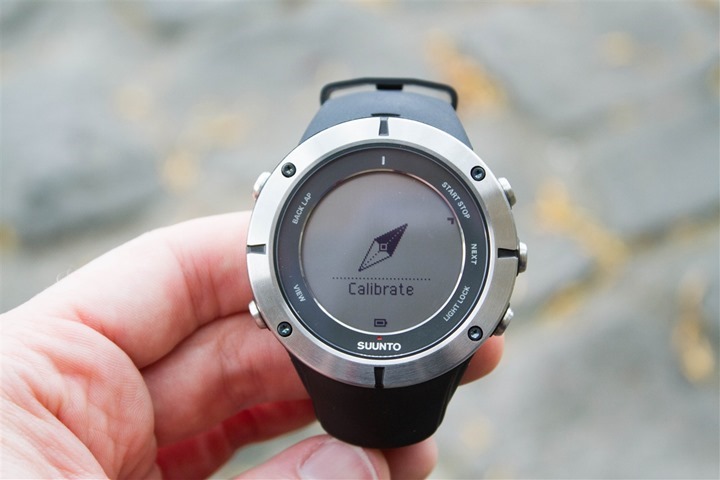
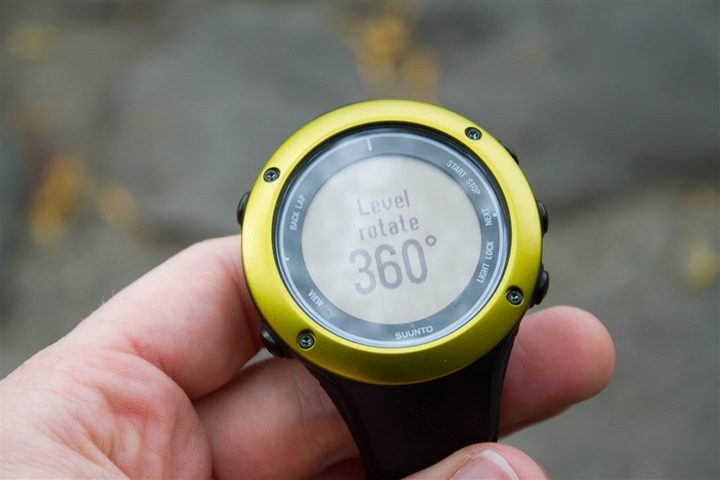
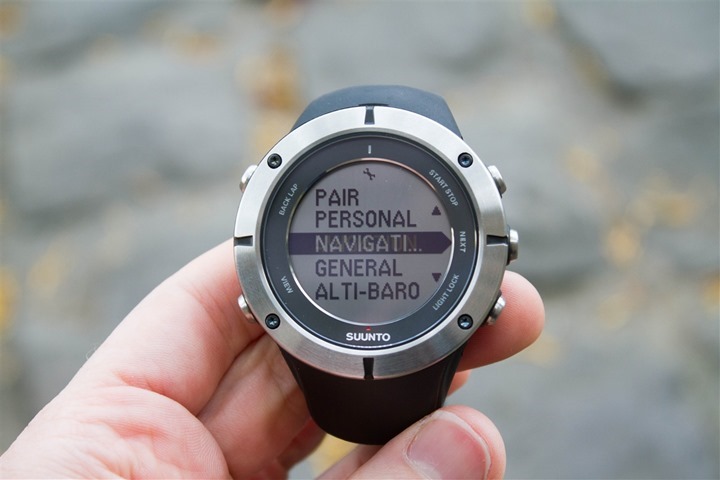
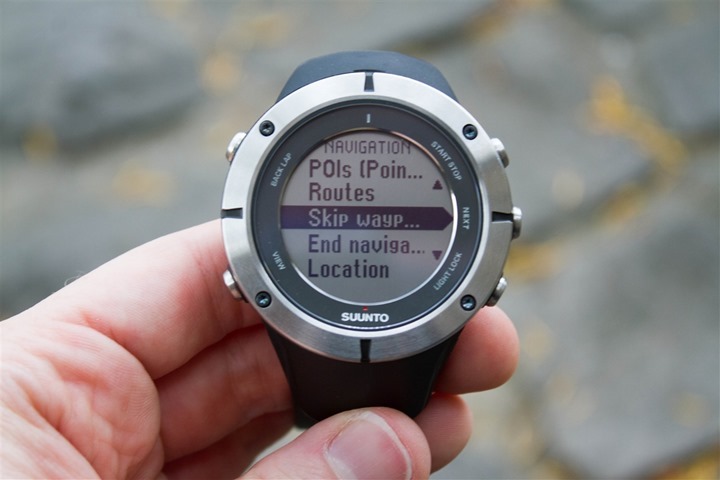
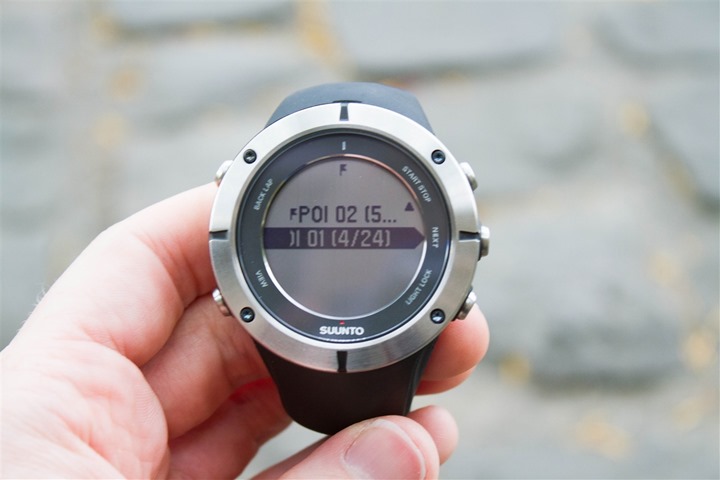
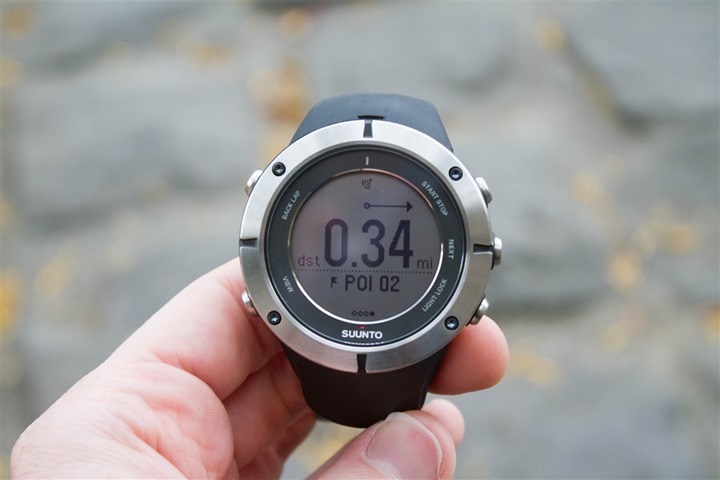
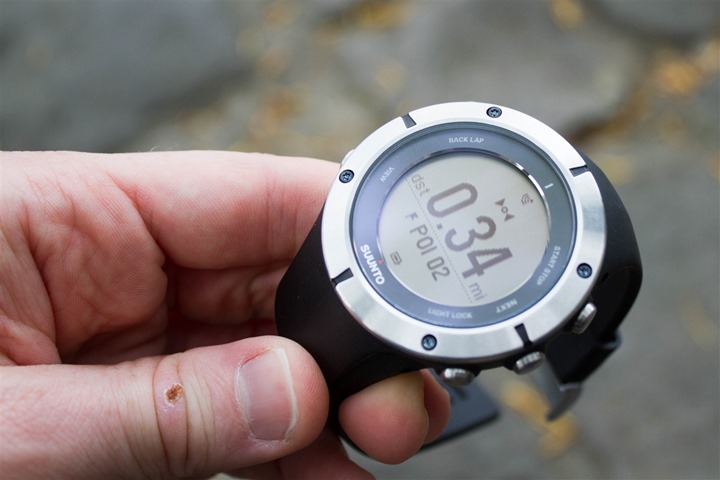
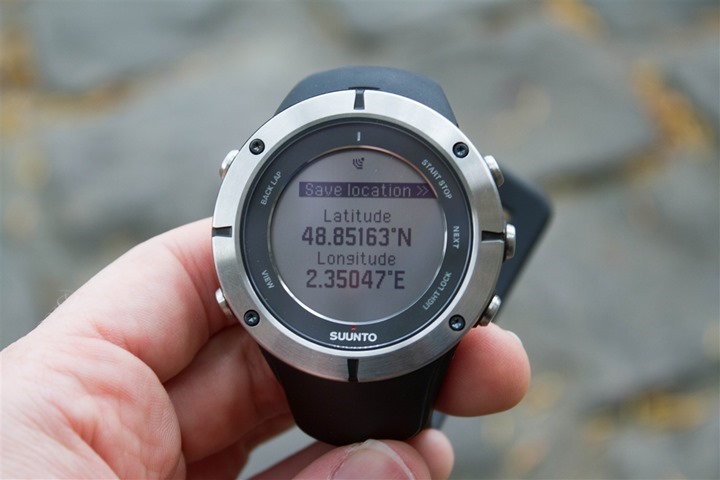
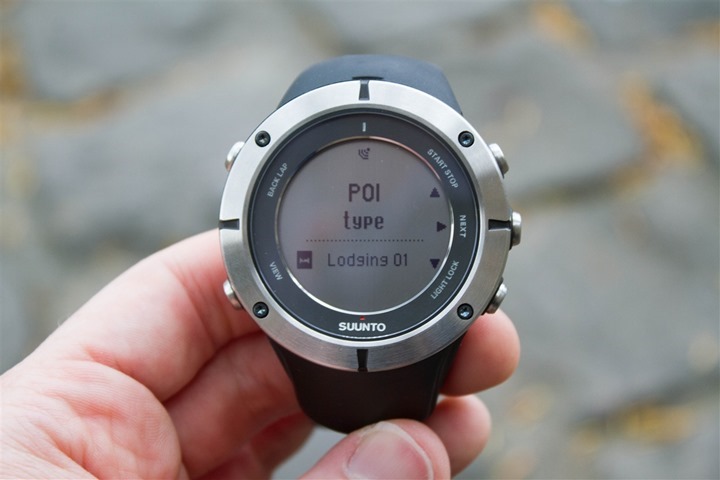





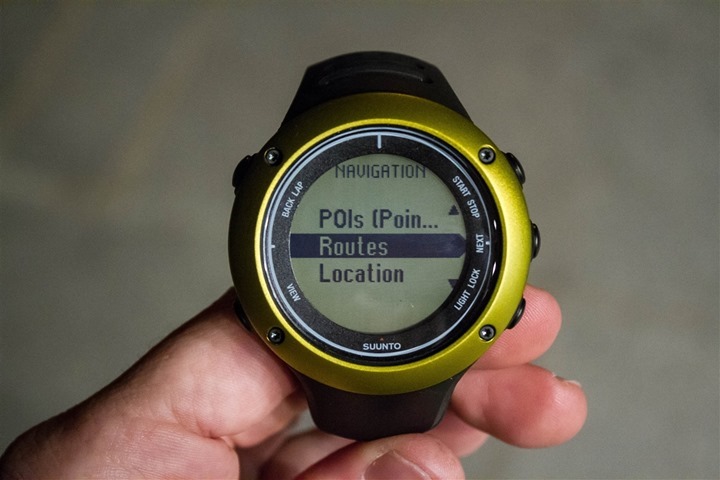
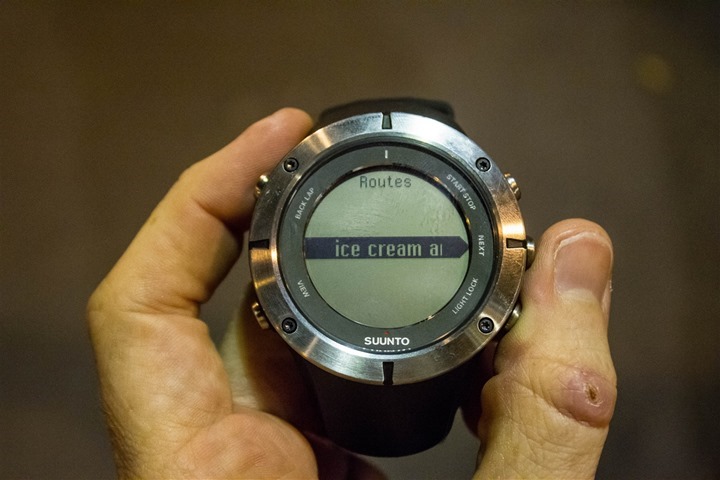
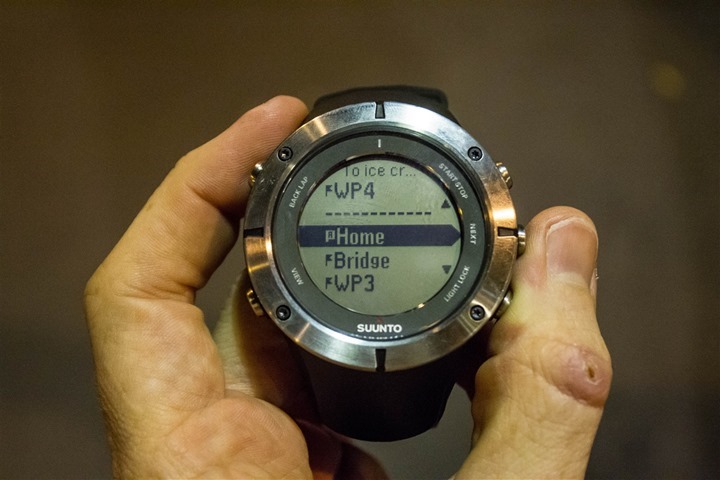
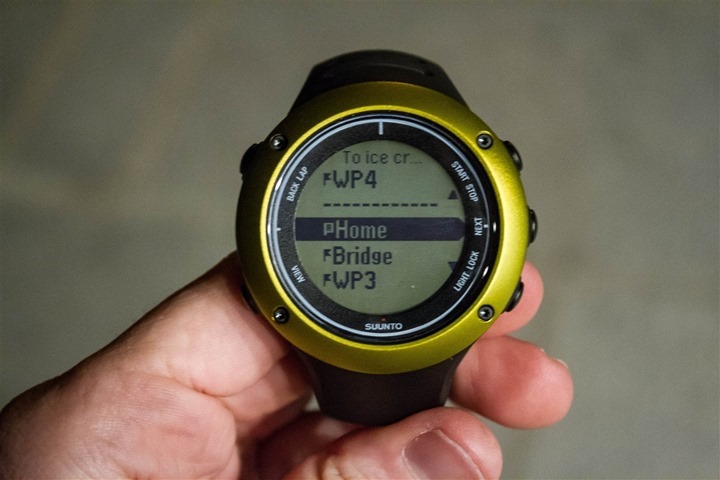
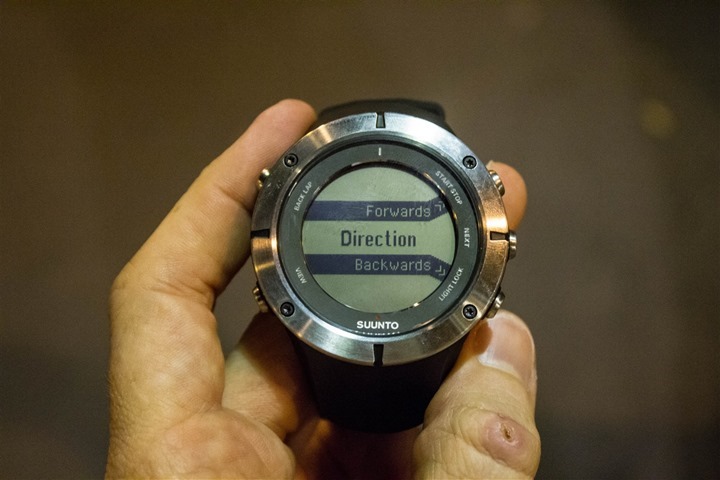
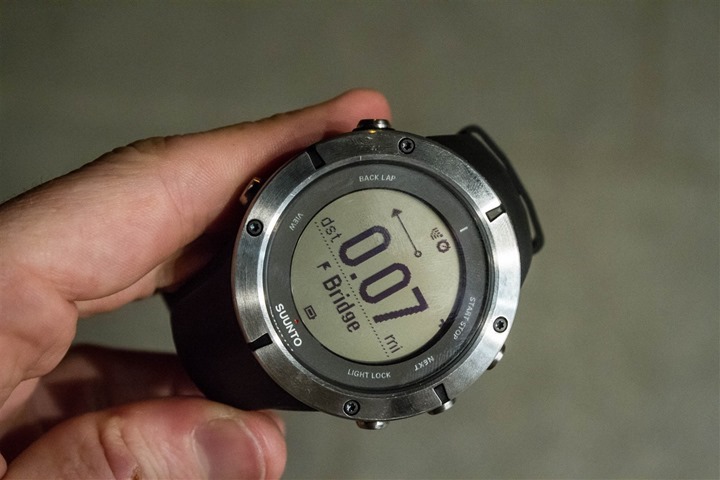
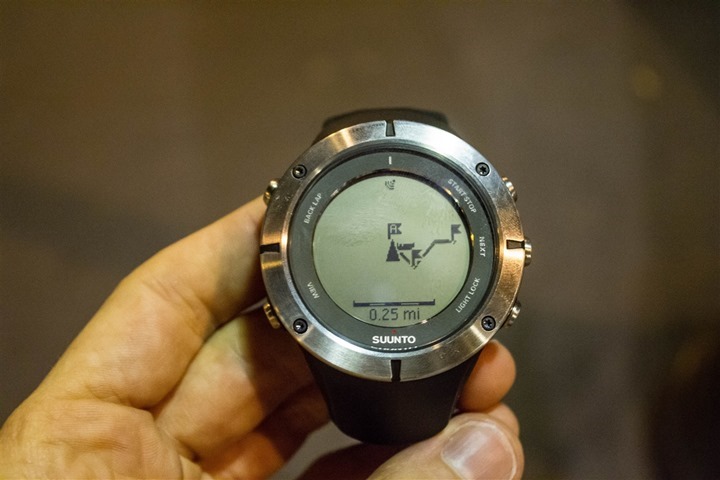
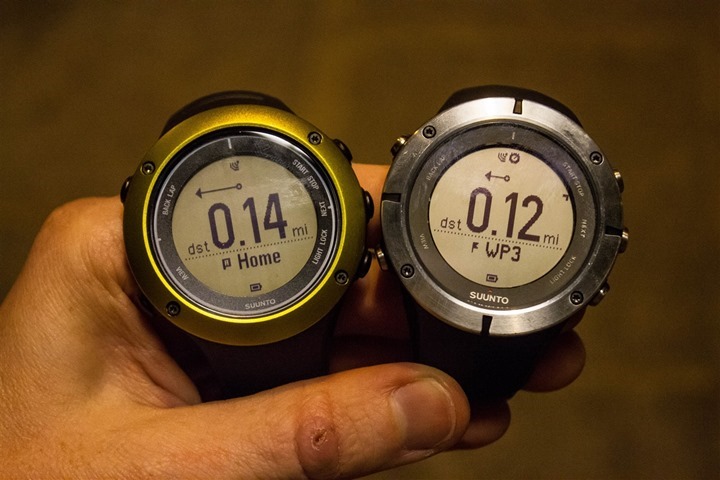
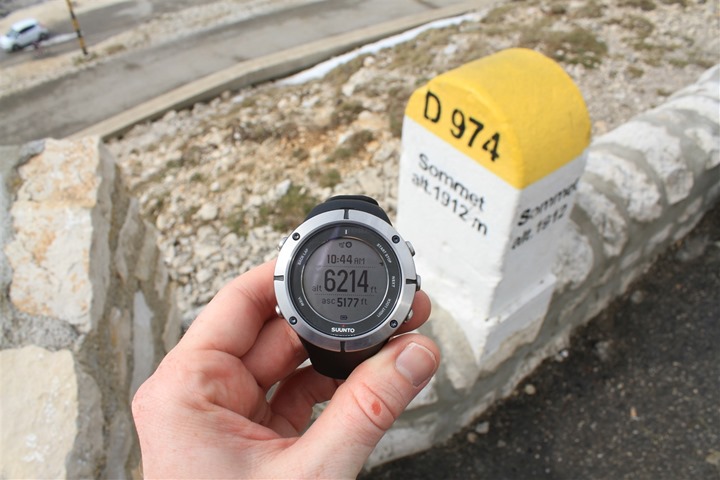

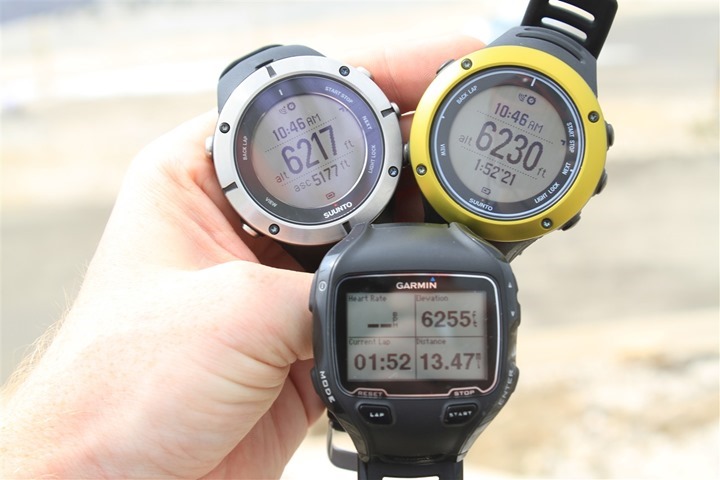
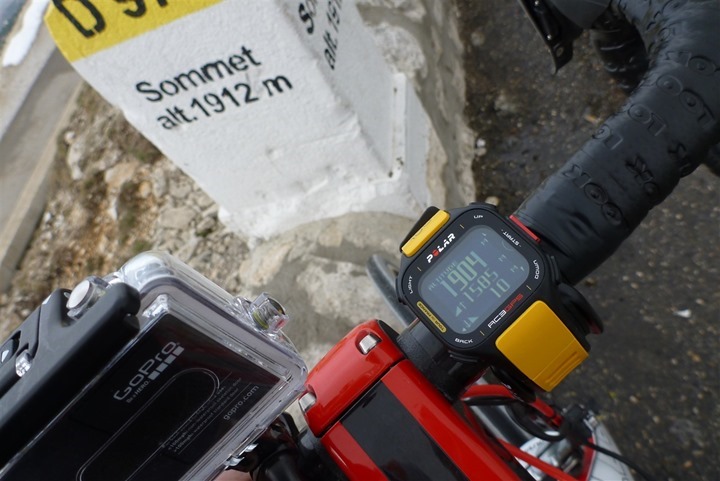

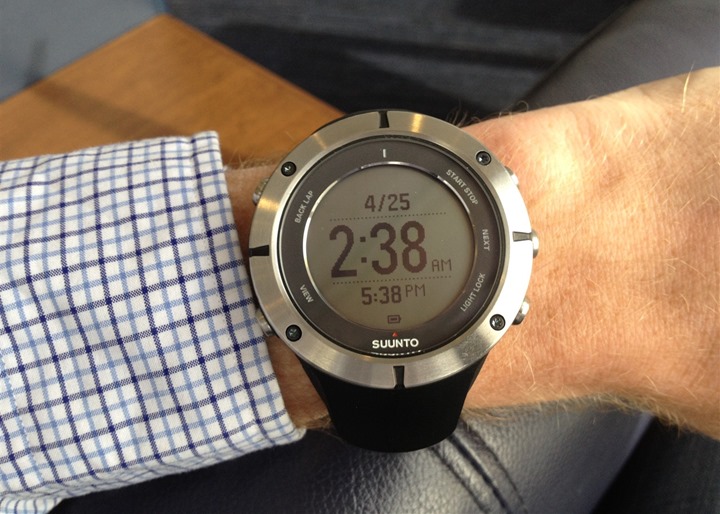
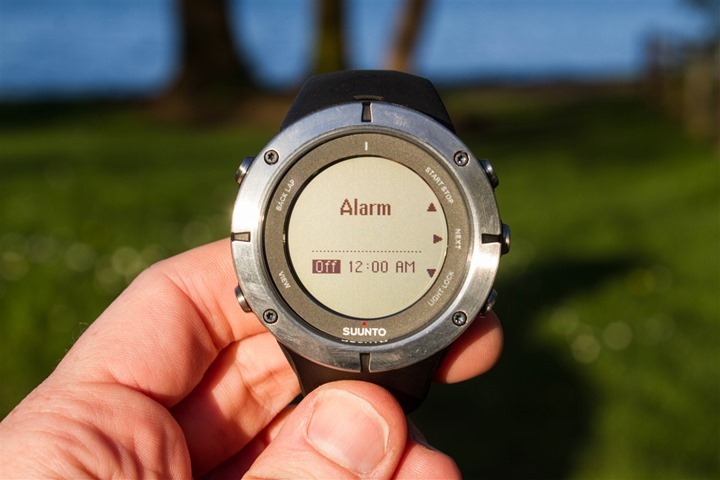
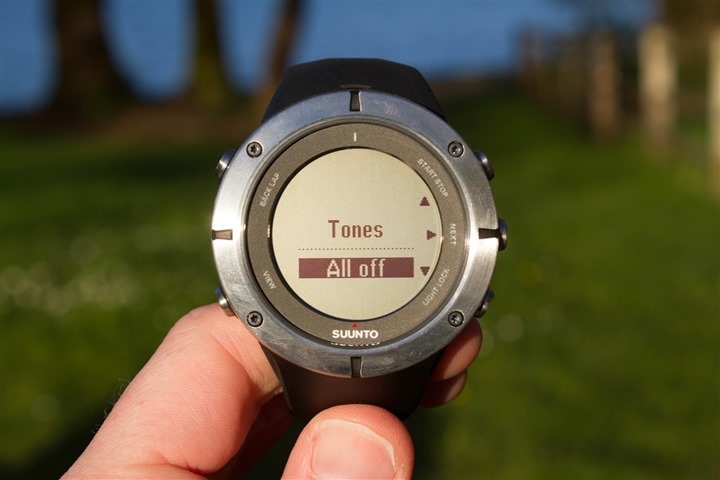
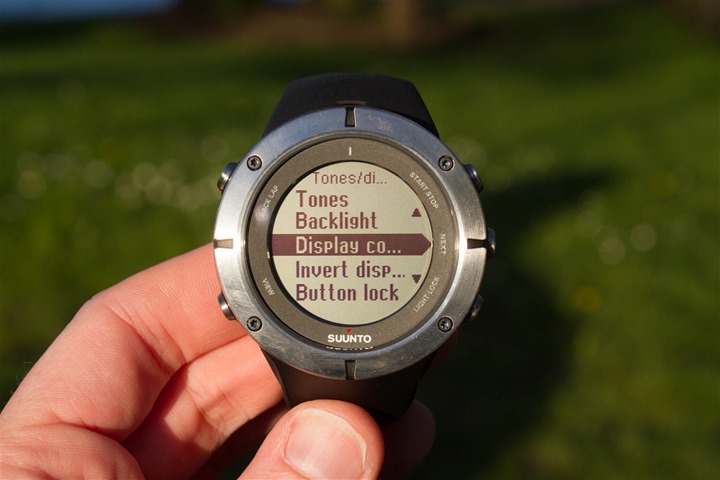
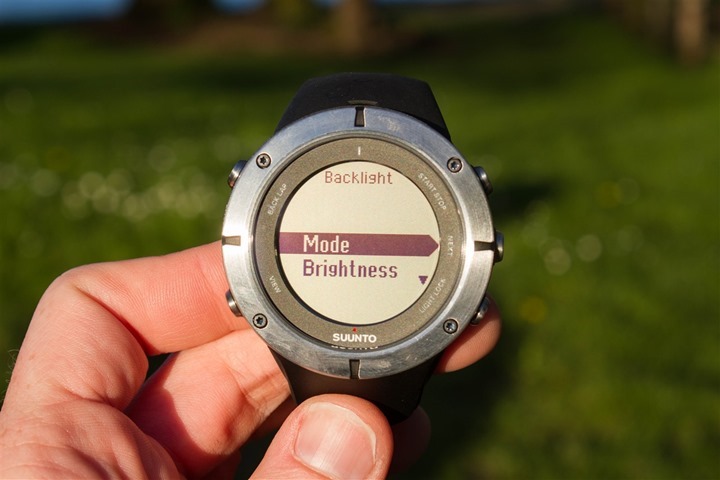
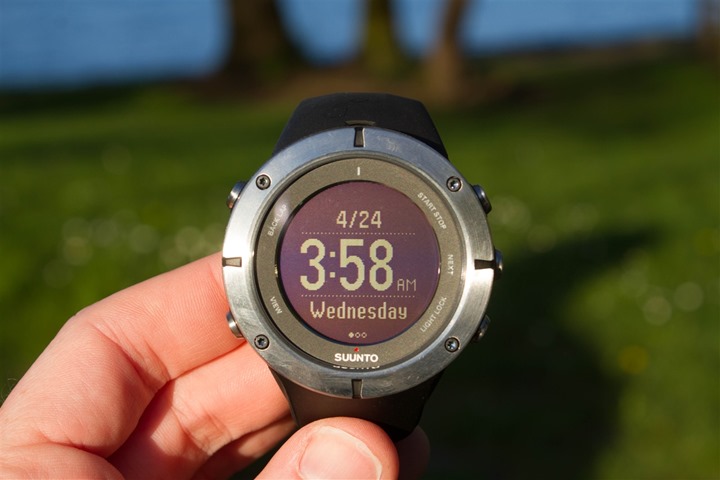
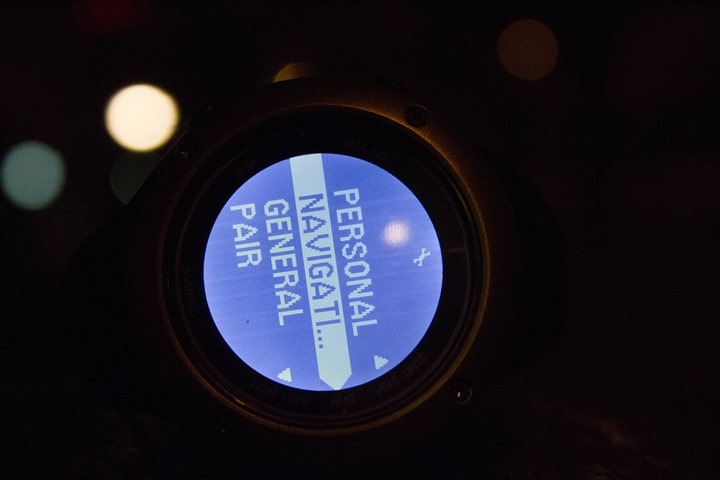

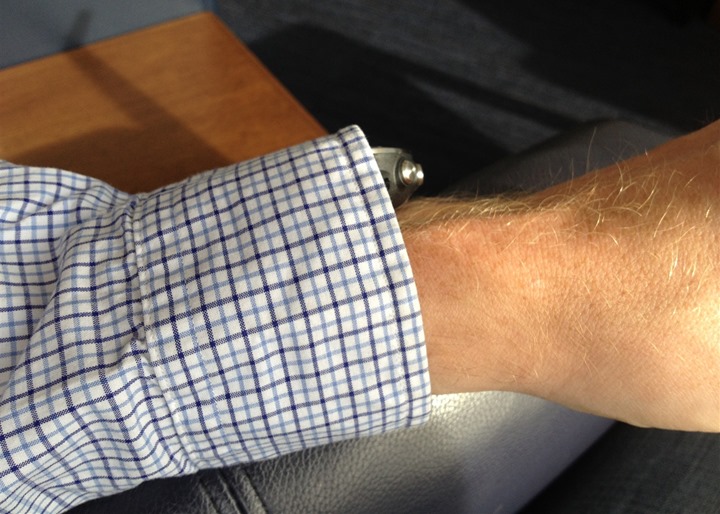
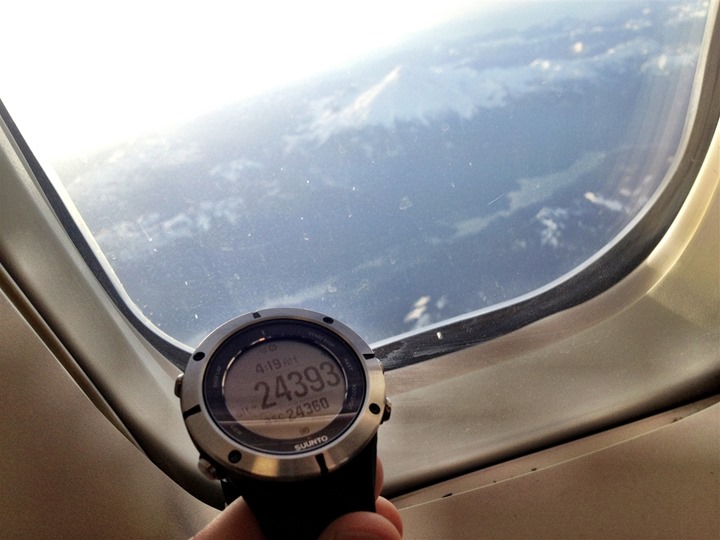

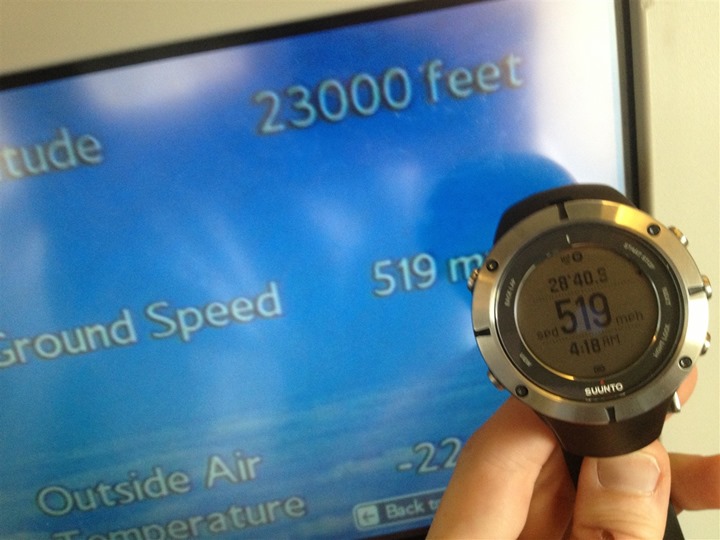
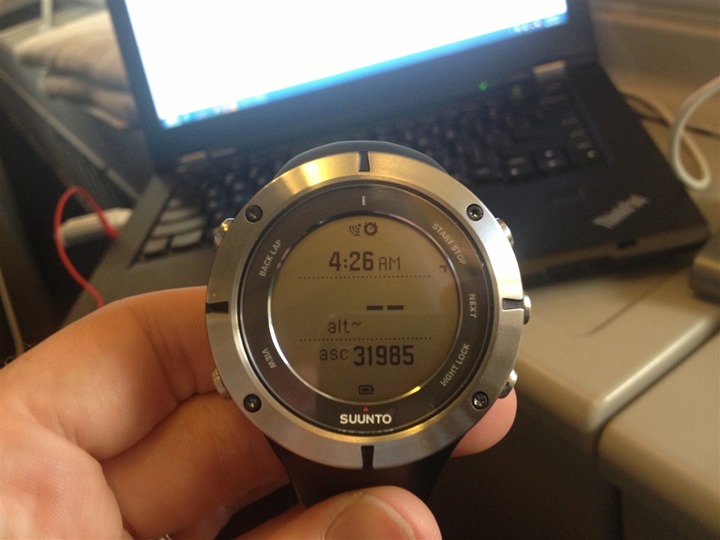

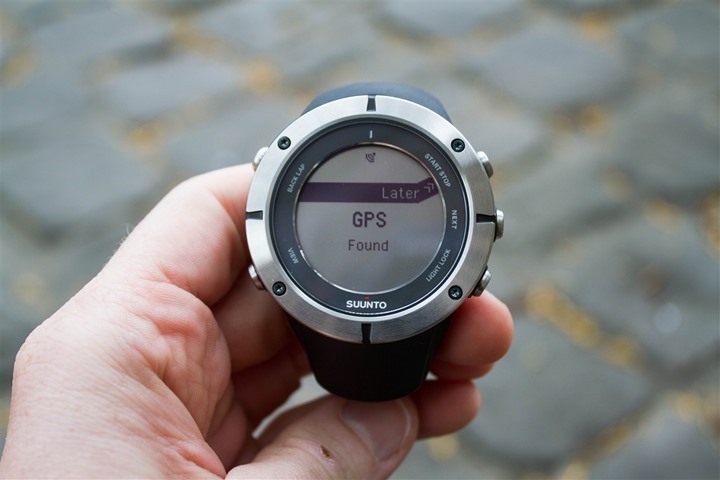
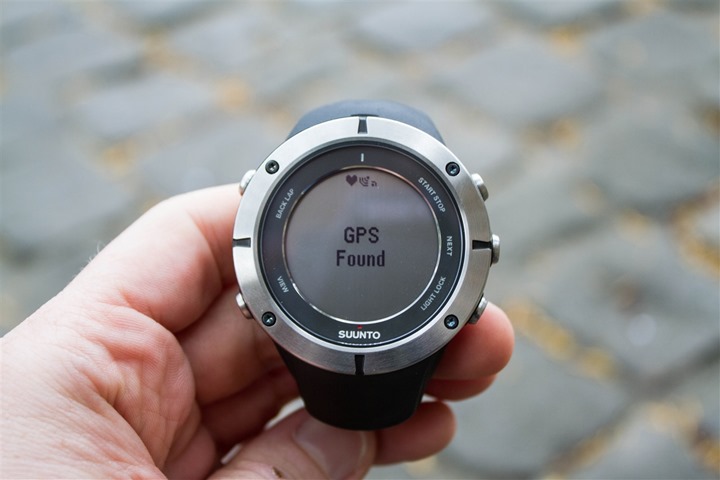



















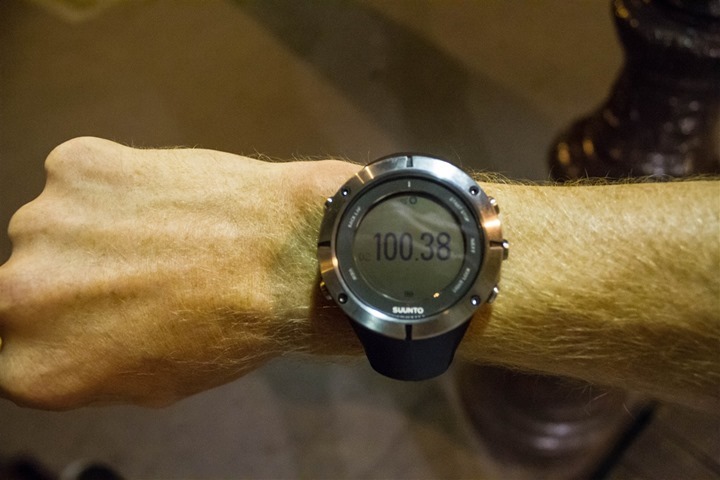
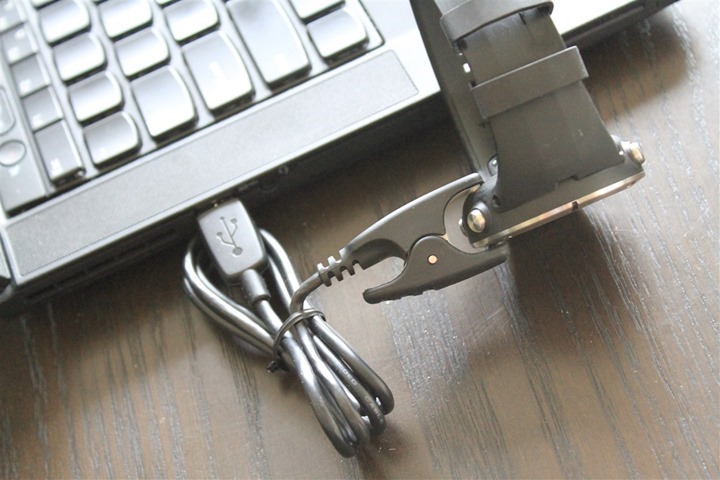



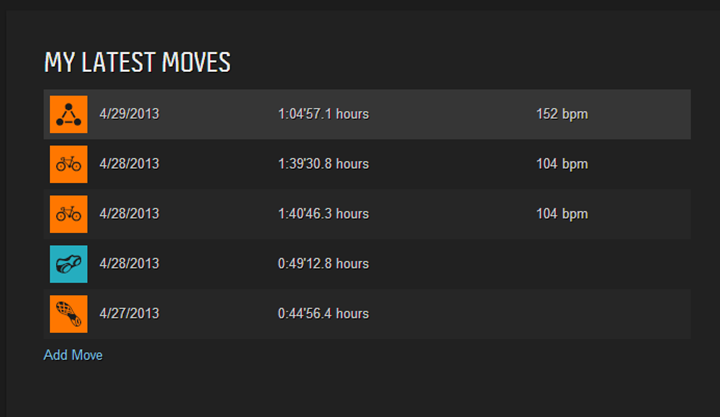

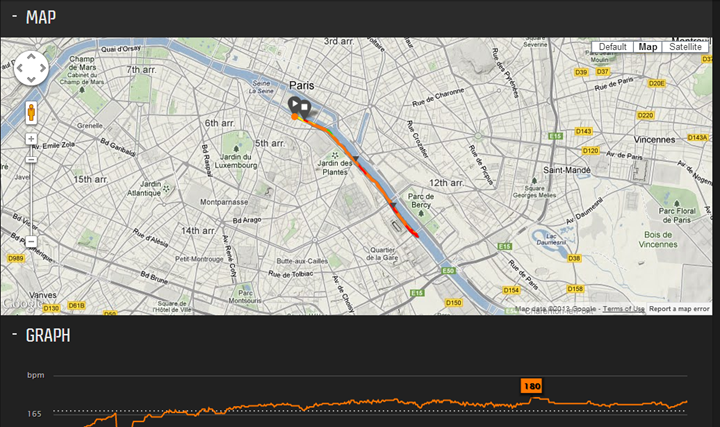







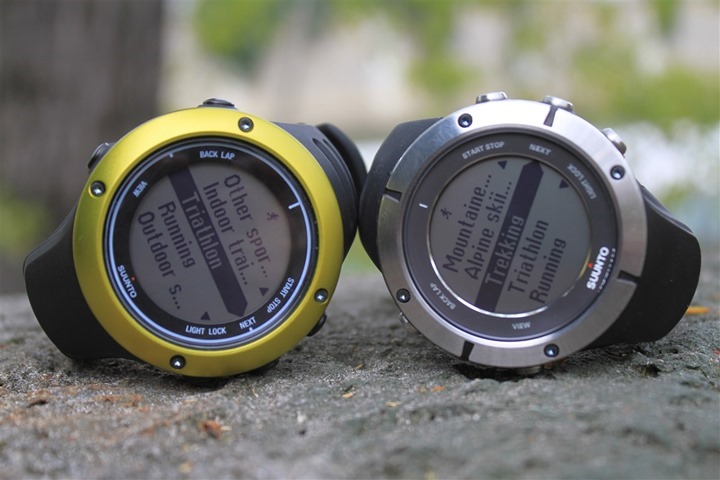
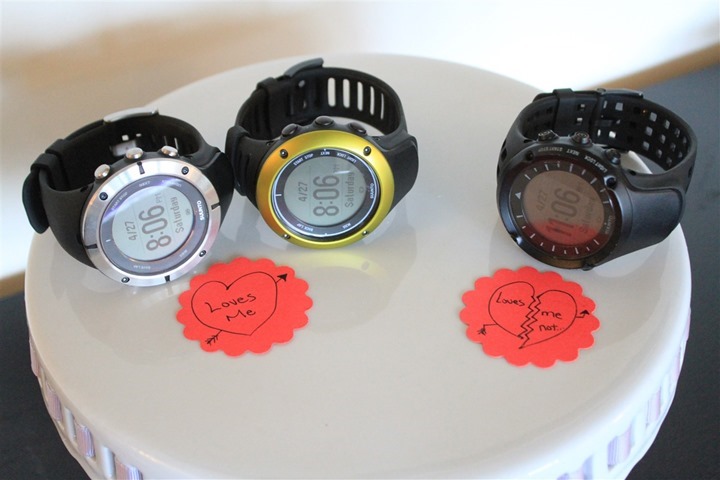
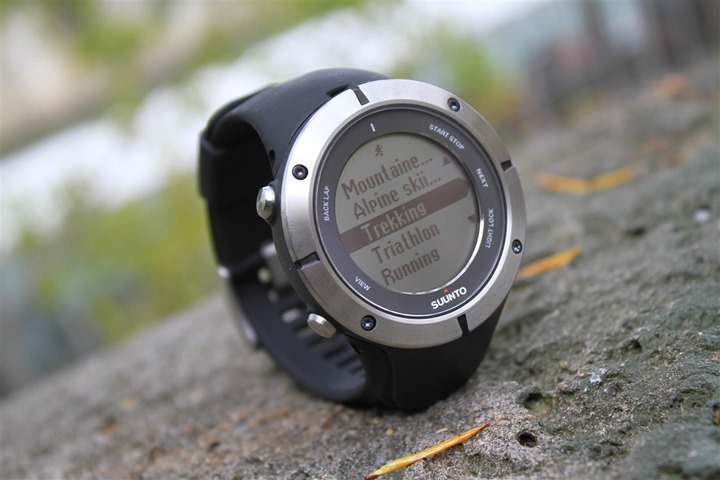





















Hi, I’ve been looking for a tri watch and had it down to the fr910 and the ambit 2 s. I was swaying towards the 910 only because I really need to work on my running cadence but didn’t want to do that at the expense of gps tracking, otherwise I’d go for the suunto. I see the ambit2 new fw now calculates cadence from the wrist. Have you done any testing as to the accuracy of it vs the accuracy with a footpod and also can you display the cadence (calculated from the wrist) during a run with say instant pace and hr?
Thanks for the great reviews btw – it’s made researching a lot easier.
.FIT export is possible for an Indoor sport whaouuuuuuuuuu……
We will have the capability to export inddor Swimmimng, Runnnig sport
IT’s a REVOLUTION !
So what is the final word on the latest firmware update with Transitions being included in the logs? How does this work? Is there a specific course of actions one needs to take to do this? I looked at the multisport mode on my watch after the update and it still only shows: Openwater swim, Bike, and run….nothing about transitions?
Has anyone used the Ambit 2S with the latest firmware on a TRI and see the transition data?
Yes this is important, I’d also like to know how you guys deal with transitioning with the Ambit2.
I have 7/10 sport modes but no multisport mode in use because I never took had time to figure it out either.
T1 and T2 are very relevant since they should be set to search for the pods.
Hi,
I’m not used Multisport mode yet, I have my first Tri in this season at 8th June. But I’m my Ambit2 with this configuration for Tri:
1- I’ve created a sport mode called Transition, with only Activity Time and Distance params in one screen.
2.-I’ve inserted this new sport Transition in a multisport mode and I called it Triathlon. It is composed by 5 sports in this order :
Swimming
Transition
Biking
Transition
Running
(with Lap button you will change between these 5 sports)
Any idea someone else? I think the last firmware update allows to set more than 3 sports mode in Multisport, but not has a specific Triathlon mode with transitions. It is correct?
Yes and you most likely are already using the T1 and T2 to identify the pods or did you leave that to the next sports mode?
I.e. I remember now… I used T1 to search for the HR/GPS/CAD and then BIKE replicated the search, T2 to search again for HR/GPS/FOOT and RUN to replicate the search.
Did you do that too or did you leave this search for the BIKE and RUN modes, leaving only the distance and timing?
Once you update to 2.0.7 or 2.0.9, you will get transitions in triathlon mode. However, you MUST go to your Ambit gear settings on movescount and choose ‘restore default settings’ in order for the transitions to show up in triathlon mode. I’m not sure why they don’t mention that anywhere. I had to go back and forth with their support team in order to eventually get this information.
I now regret that I bought an Ambit 2. Since the firmware update, I have been unable to upload moves. Moveslink always fails with “Failed to synchronize Suunto Ambit 2 with Movescount. The data will be transferred next time you have network connection”. I’m pretty sharp technically, and have probably spent about 12 hours on this problem, time I simply do not have.
I have uninstalled and reinstalled Moveslink multiple times. I have removed all the xml, and all of the local Suunto directories. No dice. I now have a USD 500 paperweight, and hope I am able to collect on the warranty. We’ll see.
Its interesting, it came down to the Fenix 2 and the Ambit 2 for me, and I went Suunto due to all bad reputation Garmin has for bugs. I simply didn’t want to have the hassle of dealing with bugs. Bad call. I’m disappointed, and hope Suunto will make me whole, but I doubt it. I’ll sell the paperweight on Ebay, take my losses, and will buy a Garmin.
Have you had a chance to contact Suunto support?
Randy, ditto here…..I updated…and was having no issues. Then did a TRI today….my first one to boot…and BAM no more sync…..This completely blows…..They need to do something about this fast!
Ok, this watch and firmware update is completely messed up. I tried something….I was wondering if maybe there was an issue with the data that was on the watch for my TRI today…..so I just manually started a run….and let the timer go for about 1 minute. Then I saved the log.
I connected the watch and BAM….it sync’d. Not sure what is going on at this point. If it happens again, a support case is being opened!
You lucked out. I connected my device and noticed the new firmware update. I’m on the previous version prior to 2.0.9 and I’ve experienced zero problems. I’ve never lost track data or had long waits on receiving satellite signals. I’m surprised the most recent firmware version is giving you or anybody problems. With that said, I’ll be holding off on the most recent update until others can confirm it is in fact the firmware and not a borked device.
I tried what Christopher did, a 1 minute run, then a synch, and it synched fine, and all the old moves were there as well.
Don’t know what the issue is, but if you are having this problem, try it. I will do a normal training run tomorrow, and hope the watch is fine. Definitely a frustrating day tho, and wish I had thought of trying this myself.
hi,
i had also the issue about workouts not syncing after update (Win7x64). i uninstalled
moveslink several times, delete suunto’s folder in %APPDATA% folder, but nothing. I was getting mad. then I found the information below in internet. not sure which of these steps fixed the issue. because actually .NET 3.5 framework was not activated in my PC (and actually is sorta strange that you have to activate .NET 3.5, because first thing moveslink does, is to install .NET 4) .
anyway the fact is that after following this instructions, i have never had the issue again.
all the credit to “Sophie_from_Suunto”, original can be found here link to goo.gl
”
First make sure that .NET framework 3.5 is activated on your Windows computer.
– Go to Control panel -> Programs and feature
– on the left side you will see Turn Windows features on or off. Make sure that .NET framework 3.5 has a check mark in front of it.
Then please follow these steps in order to fully uninstall the Moveslink2 software from your Windows computer.
– disconnect the Ambit from the computer
– Open Moveslink2 and then go into the Settings and click on the Remove link to remove the Ambit from the application.
– Log in to Movescount.com and under Settings – Applications make sure that Moveslink is set to Allowed on all applications.
– Go to C://Program Files/Users/%Username%/AppData/Roaming/ and delete the Suunto folder
– Go to the Control Panel and remove the Moveslink2 application
– Restart your computer
After that, please run the following tool that fixes the broken ClickOnce installer:
link to movescount-moveslink.s3-eu-west-1.amazonaws.com
Then please install Moveslink2 again.
If the issue still persists, please contact us directly via support@suunto.com
Top 10 contributor
answered 3 weeks ago
Sophie_from_Suunto
“
I have not, figuring it would be a waste of time on a Sunday. I intend to, and if they resolve the problem, I will post back with an update.
Same issue for me too…
I updated the gear (ambit2s) and movecount : impossible to upload something.
I tried on my PC with windows 7 and on my iMac : same issue:
Meesage is :
-synchro fail
the data will be transferred next time…..
a interesting think I saw :
I got my race on strava with the automatic synchronization tru movescount but i don’t have the race on movescount website..
Go figure….
the race uploaded on strava has been uploaded without the heart-rate data… why ? I don’t know….
Same problems here with uploading workouts. It used to work after 2-3 uploads but recently, not even after 2 hours trying, with 2 computers (Mac), using all USB ports. Very frustrating and definitely not the reliability one expects from such a high-end device.
Great review and an amazing blog, so glad I found it! I am currently trying to decide between the Ambit 2 and the Fenix 2 (as a lot of other people it seems) and am having a really hard time…I mostly cycle, lift weights/crossfit and swim occasionally, but I plan on doing sprints soon. I also like to go hiking from time to time.
That said I think that both watches have enough in terms of functionality to suit my needs and it all boils down to which one is more sturdy and less buggy. I thought I had ruled in favor of the Suunto since I read that Garmins experience a lot of bugs and delay, but seeing the above comments made me think again. I guess my question is: with respect to quality and longevity, as well as overall looks, which watch is better? Does the Fenix 2 have the capacity to be relatively bug free with all the recent updates? Is the Suunto really that awful for swimming? Thanks in advance!
Hi
I got from Suunto on twitter, that Suunto website for upload, was down yesterday night…
It why a lot of peopled had a lot of trouble to uplade them week-end races…
I have searched high and low for this answer, and cannot find it, so I figured I’d come to this community here.
How do you (or… can you) set alerts for distance milestones? For instance, in running mode, I would like to receive an audible tone at every 1/2 mile. Ever 5 miles for cycling. Etc…
Is that possible? I understand that it does not vibrate, I’m just looking for an audible tone of some kind.
Mine beeps every mile when running. Not exactly sure how to explain how to set it up, as it is a side effect of what I wanted. I did not need to use an app. My goal was to see my pace for the current mile “lap pace”, so I set up laps at 1 mile intervals, and it now beeps at every mile. So, look into setting up laps, and you may find your answer there.
Interval and autolap are the features.
Advanced settings.
Unsurprisingly I didn’t know… I run with the music and never at night so I wouldn’t hear the beeps nor would I see the light. 🙂
I believe I found something like that in the app zone, just look for it and I’m sure you’ll find it too.
The alarms work exactly as the HR alarms but as of distances you’ll have to rely on 3rd party apps.
Search on MovesCount’s app zone. I use one for swimming I bet you there’s dozens for running.
Hi, with the new update (2.0.9) Can the watch take distance without footpod on a treadmill?
Thanks in advance.
The accelerometer was given the task to mark the cadence and not the distance.
With that in mind you probably may already find some app in the App Zone that allows you to set a marked stride length which, multiplied by the steps count would give you the total distance.
Your stride length can also be found in an App I use (so i can tell you it’s really out there in this case). No other way but the app to find the exact stride length. 🙂
However… given the fact that 99.999999999999% of treadmills have their own distance counter, I don’t see the point. Upload data and then add the distance on MC manually.
With the latest updates you can get the watch to work on a treadmill without a footpod. I created a new sport in movescount which i then downloaded to the watch which i called logically enough “Indoor running” to ensure it did not try to get a gps fix. Make sure you select no gps.
Details are sketchy on how it works but i gather it bases its estimates on your past running. For me it was undercutting compared to the treadmill quite a bit even though the treadmill was i think reasonably accurate judging by how i felt. I use a treadmill very infrequently and i believe i run quite differently compared to outside. My motoactv that i also used was closer and allowed for post run calibration.
That cannot be.
The watch probably goes on a preset stride length mode and calculates the distance via accelerometer (preset stride length * steps = dst).
This idea is insane because as soon as you look at the watch for data you stop moving the arm… and that means it can’t count cad (and in this case dst as well). With indoors running it may be viable to a minimum dst accuracy but on the treadmill (which is where we all mostly run indoors but luckily there’s other indoor runs that don’t require a treadmill), your best bet is the treadmill’s display.
I’ll stick to my foot pod for out/indoor runs. When properly calibrated that thing misses about 100m in 15km. It’s a bomb.
Actually until i read your post and then looked it up on google i had assumed that footpods work the same way. It probably explains why my ambit is worse the faster i go, i just lengthen my stride but not cadence.
Back to the original question Juan. Yes it works but not as accurately as a footpod.
The lack of monitoring when you look at it is not of much importance in the end as your speed is set by the running machine which has a screen in front of you anyway so you probably want be looking at the watch much. The reason you would do this of course is to be able to download the file with your hr as well (if you have the hr monitor) and log or analyse it. I don’t believe movescount allows for any retrospective calibration.
If you read through my Ambit2 R review you’ll see how well the unit works indoors on a treadmill without a footpod (including cadence). There are some minor limitations (i.e. if you touch the treadmill or stop moving your arms), but otherwise it’s a good first effort by Suunto, and one of the more accurate attempts I’ve seen at it.
I don’t know how precisely the Ambit works with respect to WDR (Wrist Detection pace), however, with the Garmin units it actually ‘fills buckets’ at different pace ranges. So calibration is done across a bunch of different ranges based on your GPS runs. This helps alleviate issues with a single calibration value (though, even on footpods I’ve never really seen that to be an issue).
What’s the point? The treadmill has the display with mileage (as well as everything else).
You can’t compare an indoor run with an outdoor run when you’re NOT on the treadmill so it can never be accurate if it takes the GPS reading from the previous run.
I know something of indoor running, treadmill and outdoor running. As huge as the room can be, you can’t sprint and KEEP it, then you have the 4 bends (the corners of the room) it’s totally different from the outside runs…
… and it’s a huge hit against the foot pod which is very accurate and…. and it’s still being sold at the retailers. To me… it’s a nonesense, really.
In other news…lots of other people run on treadmills, and like being able to record that workout (including all the details of pace/times/etc…).
As for sprinting indoors – I assume you know there are 200m tracks indoor that are well used by races that sprint far faster than you or I can? link to youtube.com
That is not the point, Ray.
The distance meter is already in the software. They could use the DRILL feature which has been there from the beginning in the Swimming mode. Treadmill, you take the dst from the gauge of the treadmill.
If you are in an indoor track (I didn’t see the link but I guess you’re talking of the straight, red-carpeted, sprint lanes) you already know the distance, concept is the same (it could be coupled with MC in interval training and surely hundreds of APPS could also take care of that).
The fact is that this thing is virtually pointless.
1) In non straight you can’t hold the same pace of outdoors (corners)
2) In treadmill you’ve got the gauges, you could manually input (Drill)
3) in straight you already know the dst, you can input manually or even sort it out on MC.
In the meanwhile I’ve got my hands full with the famous REST algorithm.
Out of priorities, between adding a mostly pointless feature, when compared to a CRITICALLY NEEDED fix, I’d say the latter should have precedence, that’s all.
Generally speaking, any new goodie is a good thing, unfortunately I also see the downsides of such choices.
(But I am very optimistic about the REST algorithm issue) 🙂
Just got the news from Suunto is bringing out an Ambit 3 later this year. No major tweaks, just more colours apparently…
Whoa. That is awesome. I hope it vibrates…that came out wrong.
Source for that info? Wht does dc say about that? For me the dealbreaker would be upload via bluetooth or wifi.
I’d like to see the 3 have at least:
1) Vibrate alarm
2) Allow users to select from different font style like “sony sketch font” which is awesome!
3) Allow users to customize homescreen a little more.
4) Allow the user to customize or select a couple different alarm types
5) Allow the user to save the contrast setting when the screen is either black or white. (I prefer the lowest setting contrast when the screen is black but prefer a 70% contrast when the screen is white. I have to change it each time between toggling..sucks it doesn’t auto-save)
6) A red backlight would be kind of kewl but I’ll leave it up to Suunto to see how they can work it in with the user having the option to change white/dark backgrounds. That may not be possible.
Hi Ray,
I am new to ambit 2, previously I am using the RCX5, just one quick question.. when using the speed/cadence sensor, does the ambit have the autopause/autostart function using the speed sensor the same as the rcx5? i know there is an autopause setting but i think it uses the gps function. THanks!
Hi,
could anyone confirm, that maximum zoom in route mode is only 0.25m ?
This sounds akward…
cheers,
Adam
i’m in the market for a GPS watch that i can use primarily for running and standup paddling (SUP). After looking at pretty much every review of every watch out there, I’ve narrowed my search to the Ambit 2S and the Fenix 2. I’m really leaning toward the Ambit 2S, but there are two features of the Fenix 2 that i love that aren’t available on the Ambit 2S out of the box: live tracking to a website and virtual partner/pacer that vibrates. I see in the App Zone there are several pacer apps, so that’s a plus. I’m willing to turn my music volume down when i run so I can hear any alerts. Is live tracking possible on the Ambit 2S with a firmware update, or is that hardware related? I paddle long distances in the ocean and this feature would give my wife piece of mind—also, it would allow friends to see my location during races. thanks in advance for your insight!
German Press release: Ambit 3 will be introduced at Outdoor exhibition 2014 in July….
SUUNTO auf der OutDoor 2014
vom 10. bis 13. Juli 2014 präsentiert SUUNTO auf der OutDoor in Friedrichshafen die Highlights der umfassenden Produktpalette. Neben den Modellen Ambit 2S, Ambit 2 und Ambit 2R stellt der Spezialist für Sportuhren, Tauchcomputern und Präzisionsinstrumenten aus Finnland die weiterentwickelte Version SUUNTO Ambit 3 vor. Mit den umfangreichen Funktionen der GPS-Uhr wird SUUNTO erneut den Bedürfnissen eines jeden Sportlers gerecht, und die Erfolgsgeschichte der Ambit-Familie wird fortgeführt.
My Garmin FR610 has been driving me slowly up the wall for the last couple of years. The three biggest issues for me have been battery life, the lack of a barometric altimeter (I like running in the mountains), and the size of the figures on the display. I was thinking of the FR910XT but checking here have been quite interested in the Ambit 2, especially the navigation features. I’ve got a couple of questions…
How does the display size compare to the FR610?
Could I set hilltops as waypoints and get the Ambit to tell me “distance to next waypoint” in, for example, a race situation?
Well, I splurged and bought one (the Ambit2) as my Forerunner finally froze and died on me. Very impressed! Seems a much more quality item than the Garmins I’ve had before. The display is a bit larger but it’s also clearer with better contrast. The navigation features work as I’d hoped (indeed it is described in the review above!)
I’ve had very positive experiences with Suunto orienteering and diving kit before, so I’ve got high hopes for this.
It’s undoubtedly a fine piece of european-made equipment.
A much higher standard than Garmin’s plastic chinese trash. It’s gonna take a while before you can operate its features 100% and don’t forget the app zone.
With a little bit of better foreplanning, this instrument could be used by NASA. Luckily Suunto is responsive, albeit slow.
I must admit to some buyer regret after I had clicked the amazon buy button… regret chiefly driven by experience of several Garmin devices over the years which all stopped working eventually. The FR610 seems to be the longest lived at just over 2 years of ordinary use. I’ve been keen on Polars in the past but their current offerings seem to be a bit behind. The biggest attraction of the Suunto was its excellent battery life… My FR610 and its predecessors drove me mad with batteries expiring mid run. The Suunto seems solid, durable, lacking in gimmicks (eg touch screen which frequently did the opposite of what I expected) yet very versatile.
I’m impressed and the buyer remorse has been driven away!
There’s no comparison between the quality and sturdiness of the 2 brands. With my T6c, I have 3 IronMan and something like 70 IM70.3 (training only) which, as you can imagine is stress enough for the instrument…. and it still works PERFECTLY. It’s not for the races… you’ve got to imagine the DAILY battles that watch has survived.
3 weeks ago I was digging in an underground tunnel and the guy next to me hit my wrist with a pick, right on its glass. BAM. It BARELY got scratched and it STILL works perfect.
My Ambit 2 in comparison has a lot of scratches because it’s metal not rubber. The screen is bigger and it’s scratched in the middle, only mildly. It NEVER failed me.
Comparison? Had to send back 3 FR910XT in a row for broken baroaltimeter. See how they complain about MC going down yesterday and today? The whiners really have no conception of the quality instrument they’ve got on their writst.
I’ve been comparing my Ambit2 S and Forerunner 620 on every run with them both paired to the HRM-Run. Is there something I should do to unpair that HRM or does pairing with a new HRM just replace the last known sensor?
It’ll just overwrite the previous one.
Go to Suunto support page and click on the product list.
The list already includes Ambit3 Peak and Ambit3 Sport.
COOOOOOOOOOOOOOOOOOOOOOOOOOOOOOL !!!
I have Ambit2….During my training I saved some POIs but when I downloaded track to Movescount I couldn see any of that saved POI…I tried many times but no luck…is that normal…POI from suunto cant be seen in movescount????????
polo
OMG…
I couldn’t read the review as it was to long and I totally lost interest.
I just wanted a key information and possibly a recommendation !!!!
I’ll look for another review
Are you serious? These reviews are best in the industry… all the other “short reviews” are also the “not-objective-half-baked-why-do-they-even-bother-reviews”…
Your opinion is questionable.
Can you please direct me to any other independent site that offers such an in-depth review?
(other than support forums where information is scattered and hardly organized in the same manner)
I’d love to read more, honestly.
Anyway, though I do belong to the “Suunto camp”, and I find their products superior to other companies by parameters that are not always emphasized on this blog (aesthetics, quality, reliability, etc.), I respect DCR functionality over form paradigm. At least, he is very transparent about it.
In that sense I think he is objective.
Also, I honestly wonder what bias are you talking about.
I read you had some issues with the ambit, but I must say I haven’t encountered the same incidents, so as far as I know – all that is written above matches my experience.
It is not possible to have a website on the review of instruments because there ain’t. What is possible is to talk with people who review them because they OWN them and for that there’s forums like watchyouseek. In this case the review is far more reliable because it’s HUNDREDS of users explaining how their instruments work and where they fail.
Ray has his opinion and reviews the instrument the way he thinks proper but reliability of a review comes from multiple sources.
For example, when you see the review of a PC Game you will hardly ever read that the game is crap… yet you buy it and you find it at an early alpha stage.
Before buying a game I go to the games’ forums. Before buying an instrument I go to its forums.
…. it’s essentially why I asked Ray (I think 4 times already) to open his own forums… but he declined (don’t worry I’ll keep asking him ahhahahahah). 🙂
PS I also had issues with several other instruments… not just with the Ambit2. Don’t worry, they’re working on “my” issues. 🙂
Ray,
How about these combination with Wahoo TICKR or Scosche RHYTHM+ to capture HRM while swimming? Is there any ways to capture HRM while swimming by using external devices?
Thanks,
You can definitely pair while swimming, except there’s a few catches. First is that it has to be within an inch or two (thus no luck with the TICKR), and second that it won’t capture HR in swimming mode. Which means you have to put it into an alternate mode, so you won’t get swim lap metrics but instead just HR metrics. :-/
Thank you for this fantastic review. I just purchased a 2S after reading through it a few times and have started my triathlon training after reading through about 100 other posts. Thanks for the information and the motivation.
Hi All
I’ve an Ambit 2s & need to record a race that will last 24hr & get as much info as i can ie distance/elevation/pace, from what I’ve read i would need to set it to 60sec GPS recording to get 25hr, but on movescount i only get the option for 1 or 10 sec, am i looking in the wrong place?
On my last race the watch stopped recording before i finished & i just want to make sure i get this right.
Thanks
what you describe that you see on movescount as a choice of 1s or 10s is a RECORDING INTERVAL, for logging only.
What You are looking for is GPS ACCURACY (just below) and in order to set the device to 60s GPS sampling interval, check the OK option (in case of Ambit2S, it should show expected battery life of 24hrs next to OK option). More info under “Learn more” in each setting.
Different thing is that stated 24hrs might not be really true. I would rather believe it’s just the best that watch can do with such settings, but multiple conditions might impact it in negative way (temp, GPS signal strength, etc). You might end up with sthg closer to 20-22hrs. Just keep that in mind.
cheers, Adam
Hi Ray
Got an Ambit3 already for testing? Looks like there’s good news coming up on July. Many retail stores are rebating their units! Come on tell us the truth 😉
Hi,
l went to the website of Clever Training and added code DCR10AKG at checkout. But there is no discount given. The comments stated no discount for this model, Sunnto Ambit2 S. Since it’s not on clearance sale so why there is no discount as mentioned? Pls advise, thanks.
It is on Clearance Sale through today – down to $219US (for non-HR model, a bit more for the HR model). The sale ends at the end of tonight, are you seeing different prices?
My apologies. l didn’t notice that there’s a Clearance Sale today. But it’s a blessing in disguise, instead of USD360 after 10%, it’s now only USD249.99 with the HR model. Woohoo!
Ok, so I am starting to get a little annoyed at the data on my Ambit 2S……I rode 75 miles yesterday. My garmin 800 has me in at 4:01:58 with an average speed of 18.5MPH….the Ambit 2S has me in at 4:03:15 (which is accurate because I paused the watch when I was stopped refilling water) – but that is pretty much the only accurate thing about the data…
Garmin Mileage – 74.62 MILES
Ambit 2S -101.2 MILES
Garmin Avg Speed – 18.5 MPH
Gamin Max Speed – 35.3 MPH
Ambit 2S Avg Speed – 25MPH
Ambit 2S Max Speed – 163.1MPH (WHAAAAT???)
Garmin Ascent – 3199 Feet
Ambit 2S Ascent – 2254 Feet
Garmin Avg HR – 137 Max 156
Ambit 2S Avg HR – 138 Max 159 (OK here too)
What was up with the rest of the data?? Is there some sort of funky calibration thing I am missing with the Ant+ Cadence sensor or the GPS.
With regards to the GPS map, the Garmin and Ambit 2S maps match…so someone please help me figure out what is up with this thing?
I suppose the Suunto data you’re posting is coming from MovesCount?
This is the data right from the watch…but I did a ride the other day and the data was skewed basically the same way….
Enter the advanced options and try again with the highest possible accuracy.
More frequency in the records = higher accuracy (and shorter log capacity).
Watch is set for the highest accuracy and fastest recording duration already.
In using Cycling, Running, and Swimming, the accuracy is far less than what I was expecting….Cycling being the one with the biggest accuracy differences.
Here is the Movescount data – link to movescount.com
Here is the garmin data – link to connect.garmin.com
There are significant differences in the distance and speed metrics….
MC (and the watch) have serious problems in the management of TIME.
That would be the issue with the speed. The GPS is a lot more accurate than its Garmin’s counterpart. figure that in 10 runs I did, on the same track (on the road) I end the 10km marker within 10 steps from the same place, one time after the other, always in the same place. That’s very accurate indeed.
As I said there’s an EXTRA set of problems within MC so you should really use a third party software to narrow down the problem. I suppose you’re not using PODs on the bike? It’s just GPS/based data?
I am using the Garmin CadenceSpeed Sensor pod on the bike. Which is what makes this all the more confusing…the distance is way off..by 25+ miles but the maps between the Gamin 800 and the S2 are the same…..oh well, guess I had my hopes up too high for the watch…was really looking forward to using it on Triathlons and not using the Garmin for the bike segment….looks like that was a pipe dream
I use the GSC10T by Garmin on my mule-bike on the TacX with the Ambit2 and I’ve noticed an increase just like you have, occasionally and in my case it was EXACTLY the double of the projected distance (TacX reporting 10km and Ambit2 reporting 20km, for example). The reason behind this was the misalignment of the magnet on the wheel.
Make sure the magnet is correctly placed. It must be close to the rear side of the “arm” of the GSC10T and not in proximity of both sides because on the front side of the “arm” there’s the CAD.
Separate CAD from DST and it should go better, at least this is what I did to fix my problem (I originally thought it could be the battery).
Be advised that this particular POD hasn’t got a good transmission and I frequently lose data connection when in Aero Position. This doesn’t happen with the CAD POD by Suunto (which is on my TT Bike).
Hello, first of all thank you very much for such great reviews. I’ve been thinking very hard about buying an Ambit 2S for myself, but I’ve noticed that you can’t get the distance from the GPS and the cadence from footpod or bikepod at the same time. Was that fixed with the newer firmwares? Thanks and wish you the best
Nope, once you engage the Pod, that Pod prevails over GPS data and GPS will only provide the map for navigational purposes.
i’ve been using ambit2s for my outdoor pool swim training but I’ve been having discrepancies between data showing on watch vs. data uploaded to movecounts. I tried to rely on the lap count on my watching doing 20 laps at my 25yd pool. at the end of swim my watches tells me i swam 1000yds but after uploading to movescount it’ll say i swam 1075yds. happened more than once and i always have GPS on since its a outdoor pool. Anyone has idea why? thanks in advanced! I really should have count my laps in my head but i always lose count after awhile..but looks like relying on the ambit isn’t that accurate either 🙁
GPS is not to be used for outdoor pool swimming but for open water swimming.
No point in counting the laps, there’s applications that even give you a sound alarm when you reach a certain distance. Browse the app zone. 🙂
One year later and it is fixed in last firmware update, 2.0.11 … Was dealing with same issue.
Suunto Ambit2 S 2.0.11
Bug fixes:
-distance calculation mismatch between Ambit2 and Movescount.com in pool swimming
Hi,
Can the compass be operated while GPS data is being recorded? I frequently use a compass to get my bearings while trail running. I also want a watch that can predict the barometric pressure, so that I can get out of the forest before it pours. The reviews here all seem to indicate that the Ambit 2 simply works, whereas the Garmin Fenix 2 is like a beta unit.
Ray, is there a way to let CleverTraining know that I am buying an item from them based on your recommendation? They can figure it out from the discount code, but if the item is on sale, that doesn’t work during checkout.
Thanks for all the reviews!
I just don’t understand how the navigational features work, since I basically only tried once today.
I have a few POIs and 2 routes. This afternoon I was at the other side of the town and I wanted directions to get back home (which is a POI called… obviously… home).
The distance kept being near to 2 Km and never changed, the compass arrow kept moving and I had 2 vertical bars on the “12 ‘o clock” on the Ambit2 display.
Did I do something wrong? What do you guys do when you want to navigate to a specific point (and have that point in the POIs of MovesCount like I did)?
About navigation, I used that a lot, but with preprogrammed routes, and it works perfectly. The two vertical bars on the north are new since last update (something with the bearing lock, i suppose), but the circle and/or arrows pointing left or right work great with distance to the next waypoint. You don’t use compass for that, Ambit uses compass to determine your direction related to next waypoint.
This was not a preprogrammed route.
I ended my run then I decided to walk back home and at some point i engaged navigation and tried to understand how it worked. I basically used find back HOME, where Home is a POI I set in MC.
The arrow was pointing right (3 o clock) as I had home in front (12 o clock). The 2 vertical lines at 12 o clock are something I don’t understand (but it didn’t move). I have NO IDEA of how navigation works but you get my point, I wanted to know where HOME was, relative to where I was.
The distance started at 1.9 km and ended, something like 4 km of walking, at 1.89. Completely illogical hence I have no idea and was wondering if you or anyone else can help.
I don’t feel like looking into the manual or asking Suunto.
Is it possible that your Home POI isn’t really your home location?
What you are saying really doesn’t have any logic. 😉 If i have a POI located 3km on my 3 o’clock, if i go towards 12, at some point i will start to increase the distance to the POI, but if I turn towards it, than it starts to decrease.
You won’t believe it but for some strange reason the HOME POI is not where it was supposed to be… that explains a lot. 🙂
It might be that I ve used Garmin for many years and I got used to it’s navigation, but I do prefer it over Suunto’s. From what I experienced so far, navigation to waypoints (or POIs) is pretty cool in Suunto, but navigation over predefined route is much worse than Garmin’s:
1) Garmin draws live little breadcrumbs tracks that You actually do next to full straight line of predefined route (suunto does not, only pointer of Your current position)
2) Garmin notifies You with alarm (vibrate or noise) if You leave a route. If I understood correctly, Fenix2 allows You even to define the offset in meters when the alarm should be triggered (older devices had it fixed at sthg like 20m??). Suunto does not do that (only for waypoints, not the route)
3) Suunto has auto zoom (that works in a way that when off route, the level will adjust to always see the route on the screen), that actually is ok. But what really sucks is that it’s maximum zoom level is only 200m! I dont like it. Garmin allows You to zoom in to sthg like 3m!
4) Garmin, together with predefined route, gives You also route’s profile! Which is awesome in case of hiking/trail running where elevetion is much more important that distance. You can always check how much ascent is left in how much distance. Suunto does not offer profile at all (actually when You draw a route in movescount, there is no profile even there!). This is a huge advantage of Garmin over Suunto (at least for me)
Of course if I am missing sthg, please correct me 😀
Adam
Hey,
is this the new Ambit 3? looks cool 🙂
link to ilblogdegliorologi.com
cheers
I would say the one on the pic is Suunto Ambit (the first one :-P)
Got an Ambit2S and really liking it, one question though, where is the Average HR per lap option? Ave HR overall seems to exist but not per lap, am I missing something?
Most certainly you can find it in the App Zone.
Found this: link to movescount.com
Thanks for the link,
Hi Ray,
Does Suunto Ambit2(Outdoor GPS) compatible with Mio Link (Heart Rate Band)..?
Yes it is.
Thanks for all the great reviews–been following for a while. I just picked up an Ambit 2s and can’t get it to display imperial units for pace, but it shows imperial for distance (and I set it to imperial three times using moves count/link). Anyone else have this issue?
Do any of the wrist watch GPS units offer a feature to download a gpx file to the watch and then give an audible/vibration alert before each turn. I have been doing more Gran Fondo type events and they all offer the routes in gpx format. Thanks for the incredibly detailed reviews!
Both Suunto and Garmin will allow You to load .gpx file through their respective web services (movescount or garmin connect). I am not aware of wrist GPS that is seen by PC/MAC as drive in order to copy file directly (I know my eTrex30 and all EGDE series can do this).
When loaded on the watch, only Garmin watches will notify You with alert when off route (which is ultimately kinda like “before each turn”). Suunto has alerts only for waypoint and You would need to edit route before loading by adding waypoints.
This is at least what my knowledge is. Maybe some one will correct me in some details…
Adam
Is it worth the extra money to get the ambit2 rather than the 2s? Seems pretty close to the same watch other than the battery life.
there is a good section in this review stating exactly the differences and more comments on them from Ray (just go from JUMP TO on the left to section Differences between the Ambi2…). I agree with all that Ray says that lack of barometric atlimeter is really hard to notice and the temperature sensor is mostly useless as it’s too close to your wrist and though tends to meassure much too high temp. So yes, the main factor is the battery life, but on the other hand it is a huge factor! It’s double battery life and if You are doing some longer trail running (50K and more) than Ambit2S and R can be just not enough. Read some comments under Ambit2R, where some athletes reported tha watch going out of battery after 7hrs regardless of lower GPS accuracy and stated battery life of 12hrs! With Ambit2 You will not have this problem.
But if You run no more than 4-5hrs, I dont think there is a point of overpaying. Even Kilian Jornet uses Ambit2S 😛 (I guess for a weight factor hehe)
cheers, Adam
I purchased the Ambit2 S a couple weeks ago and I have one major gripe. I can’t get it to show me mile intervals. Movescount will show a graph and I can scroll and see various points but I want splits? I want to see Mile 1 7:35, Mile 2 7:43, Mile 3 7:41 etc. for a run or ride. So if I ride 35 or run 10 it will list out each mile and its pace. Is this not possible? Would be nice to view on phone(which I can on my $70) Timex Ironman.
Export the move to Strava. Strava shows mile splits. HTH.
Strava is one option.
Other is to set Autolap (to 1.0mil) in activity settings and then You will get all the info You ask for per lap (in Your case per 1mile):
– time
– pace (avg, min-max)
– speed (avg, min-max)
– HR (avg, min-max)
– ascent
– descent
– cadence (avg, min-max)
You can then sort them anyway You like (which is actually more funtionality than strava – the free account at least).
checkout my move with autolap set to 1km (I am in metrics):
link to movescount.com
scroll down and open “LAPS” section.
cheers, Adam
Had this issue as well and figured out how to get the Autolap. When you are on Movescount, at the top hover over gear and click on your Suunto Ambit2 S, then go to the profile under customize that you want to add the Autolap. Scroll down and just under Pods to Search click on show advanced settings. Once this opens up, you will see an option for Autolap, which you can configure however to whatever distance you want.
HI, just got the Ambit 2S and have a Duathlon tomorrow. I would like to create that in the Preconfigured multisport mode but cannot find anywhere in Movescount where I can do this?….The manual is not very clear as it only says “you can create your own multisport mode in Movescount and download it to your Suunto Ambit2 S”. Yes nice but where is that function? Hope someone can help! Thanks
Login to MovesCount. Go to Gear. Select your watch. Scroll down to Customization and select Create New Multisport Mode. Save and Sync your watch.
Found it, many thanks!
I posted this in the Ambit 1 site but got no response so am trying here as I guess there will be the same issue for the newer watches
I have an Ambit 1, great watch and very reliable. When I use it on multiday treks, I stop the watch at the end of each day and start the next. I would like to join the days together on movescount to give one single track with combined stats. Can anyone let me know how to do that.
Also is it possible to delete a section of a track where I have inadvertently left the watch recording
Hello, I bought the Ambit2 as my first GPS watch and I am really happy with it so far, except one issue. During open water swims, it doesn’t count the distance after I hit the stop button to pause during the swim. I wear the watch around my wrist and hold it above the water surface when I resume the exercise. GPS signal is also still there. Do I have a broken device?
Thanks for any suggestions.
Once you press pause, it stops counting distance/time. After all, that’s why it’s paused. Do you mean something else though?
You’re right the stop button works just fine – it stops counting time and distance. But when I press the button again to continue to record the exercise, it only counts time but no distance at all. Even though I still have GPS signal. Dunno what I am doing wrong.
Thanks for the fast reply!
Gotchya. Hmm, that’s definitely odd. I’d ring up Suunto support and see if they have an idea. It should definitely resume.
had the same issue.
Just to explain – I do not swim at all! 😛 But when got the watch, I was curious about it meassuring swim in open water. So I went straight line off the shore into the sea, about 200m (all fine), then stopped and paused and after ~20s started again and went back to the shore. The swim back was never meassured (only time, no distance)! Zero problem for me, but it did happen.
Adam
I just tried again to swim, pause, and resume and it didn’t work. BUT when I upload the move on Strave it actually does show me the right distance. So, I don’t know why the watch isn’t showing me the distance. Is Strava calculating the distance based on some waypoints or is my watch recording the whole distance but isn’t showing me on the display (and neither onmovescount!!).
Anyway, I will call the customer service tomorrow and let you know what they have said.
Hi,
I have same issue, but my Ambit2 S dit not show distance at all when i’m swimming in open water (freestyle).
I did contact suunto support and got new watch but the problem is still the same.
No idea what to do next.
/Arek
Anyone else having issues with Moveslink2 after the most recent update? Haven’t been able to connect any of our SUUNTO devices since. Application refuses to open, regardless of remove, reinstall, etc. SUUNTO support = no response.
Description:
Stopped working
Problem signature:
Problem Event Name: CLR20r3
Problem Signature 01: moveslink2.exe
Problem Signature 02: 1.1.63.4443
Problem Signature 03: 53b67e50
Problem Signature 04: Moveslink2
Problem Signature 05: 1.1.63.4443
Problem Signature 06: 53b67e50
Problem Signature 07: 19e
Problem Signature 08: 122
Problem Signature 09: System.BadImageFormatException
OS Version: 6.1.7601.2.1.0.768.3
Locale ID: 1033
I have had the same problem. I have to uninstall it then reinstall using the Run as Administrator option when installing. What stinks is if you shut down your computer, you have to go through that again, so I’ve just been leaving Movelink2 open on the desktop.
Hey Andy….glad that worked out for you.
Surfing the web there appears to be a lot of unhappy people with the most recent changes having completely rendered useless their moveslink app. Mine included.
I’ve tried your work-around and unfortunately that one won’t do the trick for me. I even rolled back my Windows to 2 weeks ago, to see if any Windows update might have conflicted with the new version. Still no joy.
I guess I’m lucky that I jacked my knee up during my last 50k, because it doesn’t look like this is going to get resolved quickly or easily.
Thanks though and happy running/swimming/cycling to you.
same for me. Windows 7 and latest Moveslink2. If I start my PC, moveslink2 starts automatically and soon after fails. I remove it, install again (right-click on setup and “run as administrator”). After installing, I am guessing moveslink2 is also launched as administrator and works fine. But when started after starting PC, then it probably does launch as administrator and fails every time – a real pain in the ass!!!
All this led me to use my older watch for everyday street running and Suunto only once per week for mountain long run. So I install moveslink2 every week. If/When they will solve it, I will probably start using Suunto as primary GPS watch for all runs.
Adam
Hi!
Would love to get some help with this issue:
HR drops occasionally for no apparent reason. I switched the battery, tightened the HR strap, changed locations, added water, but still, it seems like HR is not stable. Especially after half an hour of running.
Can it be that too much sweat prevents smooth HR data?
I know the strap is OK since it works perfect with edge 510. I also know the watch is OK since when using MIO LINK, the watch shows HR constantly. Can’t figure what seems to be the problem. Should mention it’s an ANT+ strap.
ANY HELP?
Thanks!
I often find if I have the watch showing hr that it will not display on the watch while running. However it is recording and shows up in movescount.
Thanks for the reply Brent.
I actually noticed something similar (i.e., no HR while running but a somewhat more consistent graph on movescount). Thing is, I think the watch just grabs the last known value before the HR dropped, and treats it as a constant HR, thus, giving a false average.
movescount does give a false average.
I’ve had the HR drop off the watch for no reason for over half an hour, only to appear and then disappear again, before appearing back on.
because of the long duration of the drop, you can see it uses the last known value.
link to movescount.com
Asaf – I have seen this exact SAME behavior with my Ambit2. When I use the HR Strap (the one that shipped w/ the Ambit2), the HR constantly drops / disconnects. I also have the Mio Link and noticed that it will drop as well if I wear it on the opposite wrist from my watch. Of course, if I wear the Mio Link on the SAME wrist as my watch, it rarely drops. Not ideal at all and very frustrating that the HR strap that ships with the Ambit2 loses the connection several times during exercise.
I’m actually considering returning my Ambit2 as I really think this is a flaw with the watch. I don’t fully trust the mio link yet and my experience with HR straps suggest more accurate data but if they wont work w/ my ambit2, it’s kind of pointless.
Any thoughts / opinions here? My friend has the Fenix2 and I’m considering a switch or perhaps holding out for the Ambit3.
Hi John,
MIo link works only on the same hand for me too. Strange that it’s true only for ANT+ devices. BT data works both hands. I really hope MIO will deliver a firmware sometime soon. I don’t mind having half the battery life as long as during that time it works… As for switching to Fenix2, I really wouldn’t recommend that, given the instability of the watch. Ambit3 on the other hand, sounds amazing
Hi Ray,
do You happen to know if autolap feature will be improved? I mean now only supports distance, but it would be also nice to see other options for autolaps, like : elevation (say every 100M) or better ascent.
Are there any plans for fw?
Or maybe adding new functions for Apps? (this would actually be much faster and I assume also easier for Suunto). Then writting an app would be fairly easy…
Adam
I don’t expect to see autolap changed at this point. I’d agree it sounds like a better option for an app, which a 3rd party could develop.
Hi there, I just buyed my Suunto 2 S, and yesterday I tested a planned move that I programed on movescount(5 mins warm up, 45mins zone 2, 5min cold down) but the clock just stayed on the 5 minutes warmup forever, any Idea how can I get the clock to send a beep any time I need to change of zone ???
Thanks in advance
Hi there,
Does anybody know how to make your Ambit beep if you reach the HR maximum you set before? And if you reach the interval criteria? Because I tried several ways: first of all, set the heart rate limits in the advanced menu in Movescount. Nothing. Secondly, ticked the interval timer and set it to 0.2 km (that should be the sprint interval) and 0.8 km (that should be the jogging). Nothing. I even dowloaded an app, called HR alarm to my watch but it doesn’t work at all, just shows me the current hr meanwhile running. So how the hell is it possible that I don’t look at the watch in every second to check my hr instead of a beep??? The only voice is a short beep when autolap is in use and the watch beeps one when I reach the set value… But for me max hr would be more important. Can anyone help me?
Hi,
with the incoming Ambit 3, I have noticed that prices are going down on Ambit 2S..then I was thinking about buying now a 2S. do you think Suunto will stop updating the Ambit 2S firware after releasing Ambit 3?
I would expect you’ll still continue to get minor firmware updates (fixes/etc…), but Suunto hasn’t clarified if any major updates would come to the Ambit2.
Hi Rainmaker,
I just recently discovered your website and applaud you for your excellent and well written reports. I guess you help a lot of people making a buying decision. I am one of them and wanted to buy the Ambit2 and did so by clicking your link and using your promo code on the clevertraining website. Unfortunately it says that “THAT COUPON CAN ONLY BE USED ON SELECTED PRODUCTS. NONE OF THE ALLOWED PRODUCTS ARE IN YOUR SHOPPING CART. (DCR10WHP)”. Have you or anybody else has had this message before?
Thank you for a short reply,
Alexander
Hi Alexander-
Thanks for the support! The reason is that right now the Ambit2/2S is on deep-sale starting at $219 (over $100 off already), thus the extra 10% doesn’t work there. But you’ll still get the free shipping, etc…
Hope this helps, and again, thanks for supporting the site!
… thanks for the quick answer and the price cut is a reasonable explanation. But I have to correct you because I cannot enjoy free shipping as it is an international shipment 😉
Went for a 7 mile run with the Ambit 2 yesterday. While it knew I ran 7 miles, it only recorded GPS tracks for the second half of the run. Map on both movescount and strava shows me starting in the middle of the run in a random place. Looked at the xml, and verified it was only recording GPS coordinates after the first 30 minutes. I verified that I had the satellites acquired before I started the run. This is the first time this has happened to me, and is also the first move downloaded after a forced update to movescount when I downloaded yesterday. Anyone else seen this? Anyone have a clue what is going on?
its happened to me twice. both times when I started from the same location which has some tree cover. I guess it lost GPS and with running took a while to regain. it was only a few minutes for me though.
Hi Ray,
Do you know if Suunto plan on improving the zoom feature on the Ambit2? I’ve just bought one and it looks like you can only zoom into 200m, whereas the Garmin (FR305) allowed me to to zoom into 25m. There is a risk with 200m that you run down the wrong track when tracks are close by and end up having to back track. The Garmin was great when running my last ultra – if I deviated from the course just slightly it warned me that I was off track. I would have though that the Ambit2 (given the nature of the watch) would allow better zooming. Are you aware of any plans to improve it?
Thanks….MIke.
I haven’t heard of any discussion there. Doesn’t mean they aren’t considering, just hasn’t been brought up.
Many thanks for the prompt response…..
Nearly a year later and still can’t zoom closer than 200m. Its a real problem when tracks are close to each other (for Mountain biking). Backtracking in a race is a no-no and more and more races require gps tracking.
Looks like something like a Garmin 510 is a lot better in this aspect.
My Ambit 2s doesn’t work with my Scosche Rhythm+ sensor. It pairs but then always displays a HR of 60. My IPhone and also a Garmin FR620 of a friend displays the correct HR. Any ideas how to fix this or what the problem might be?
Thx for your response!
Just replied on your Scosche post (probably better suited there). In short, it sounds like somehow you got a un-upgraded unit. As noted simply open a support case with Scosche and they’ll ship you a new one, last international person had it in a few days.
Just in case anyone has problem with failing sync in moveslink2:
I have noticed this while creating a new route. Movescount will allow You to create a route with multiple waypoints with exactly same names without any objection/error reported. But later, if You mark “use this route on the watch”, the sync will fail. You need to use unique names for every waypoint in order sync to work.
I have checked it only in situation where the same route had multiple waypoints with same names, but I suspect the unique names apply for any waypoint in any route that is marked to be “used on the watch”. Just something to watch about…
Adam
Hi,
I got the Ambit2 and wanted to use the barometer so I can come indoors if the air pressure trends downwards. However, the barometer’s weather predictor and storm alarm feature do not seem to match outside conditions. My storm alarm has gone off multiple times when there was not an obvious sign of rain (and no rain fell), and once I forgot to turn it off, and it rang while I had been indoors for several hours (no change in air pressure there, either). Does anyone else find that the weather predictor is inaccurate? My Casio Pathfinder’s barometer trend never makes a mistake, and the Ambit2’s is never right. Does anyone else rely on the barometer to watch for rain/storms?
Thanks
I got my watch two weeks ago and am still trying to figure out the barometer. The first day I had it, the barometer showed ~33.5 inHg. After a couple of days, it was down to ~30.30 and has not left the range of ~30.15 – ~30.45 since. That is even going from higher to lower elevations (2000′ worth). My storm alarm has never gone off, and we’ve had rain 7 times the last two weeks. So no, I do not trust my Ambit2 for storm alerts or even the barometer.
How (and when) does the GPS Timekeeping works?
I have set slightly wrong local time (+1 minute) and slightly wrong dual time (+3 minutes). As instruction said, time that has <7 minutes error will be sinchronized by GPS once a day. After two days of GPS use (3 hours one day and 5 hours another day) the time is not sinchronized yet.
Am I doing something wrong?
In Movescount, hover over gear at the top and then click on your watch. Click on General Settings and make sure you have the option for GPS Time Keeping on. If not, turn it on and connect your watch to the computer so you can import the setting. Then go outside and turn on the GPS. Another way to do it is to hold the Next button for two seconds on the watch, go into General, Go to Time/Date, then go to GPS Time Keeping and make sure it is on. The reason you want to make sure it is set up right online is that if you have it set on the watch and then connect it to the computer, it will set it to whatever Movescount shows. Hope that works.
Thanks for advice, but both Movescount and Watch have “ON” for this setting.
Is there an option to view OS grid reference’s on the Ambit2S?
Here are all the current GPS position formats from the Ambit series: link to dcrainmaker.com
I know the battery will last for an ultra. But sounds like there is concern about memory. Will the memory last for a 100 mile about 24 hours?
If You set the device properly for the battery to last 24hrs (meaning 5s or 60s GPS sampling) then You should also take care of recording interval (set it to 10s) and with this You are good to go and memory will be sufficient. Check out post #1174 for details. i.e settings with Good GPS accurancy (5s GPS sampling), 10s recording interval and HR monitor logged, can log upto 58hrs, while battery should live 24hrs (all for Ambit2).
Of course You need to remember about all possible scenarios like: alarms, apps, weak signal, low/high temp, humidity etc affecting battery life; and apps (if let to log result) affecting log capacity. Probably numbers below are “the best scenario” and I personally wouldnot risk to get any close to them.
If I would know that I would run i.e. close to 22-24hrs I would use more secure settings with 60s GPS sampling and 10s recording interval, I wouldnt run too many apps (or even none), wouldnt use to many alarms (maybe only autolap).
You will find a lot of posts complaining about watch powering of at 12th hour instead of stated 16th! But none one mentions they had all possible alarms beeping every 2mins…
cheers, Adam
Bought the Ambit 2S about 3 weeks ago for $249. That’s got to be the best buy on the market. Amazing function! Watch has performed perfectly so far. Thanks for the review Ray, it played a big part in my purchase. I’m wondering if they will ever be able to update the pitiful interval mode?
Thanks!
I think eventually they’ll be forced do. Whether or not they add it to the 2/2S line would be an unknown.
Hi,
Would you recommend the older garmin GSC 10 which I can get for $62aud or the newer magnetless garmin speed and cadence sensor which is about $20 more for the ambit2s.
Thanks
I prefer the magnetless these days, but that’s just me.
Does anyone expirience problems with Movescount site from yesterday?
I tried to open it from smartphone and from PC, Wi-Fi and 3G – and there is only error page opens.
What’s a problems with it?
The site was supposed to be under maintenance but I think they ran into some problems in the process.
link to facebook.com
Thanks for info, hope they fix that quickly!
They must have run into some big problems. Still can’t connect. Glad to hear it’s not just me. While I’m at it, does anybody have ideas to improve the watches interval fct? Apps? Multisport combos? Thanks
Site back up and working now 🙂
Three more questions about Suunto Ambit 2. 😉
1) The directional arrow often starts to turn in different directions during navigating when it comes to 0-1 meters distance to waypoint. Why does this happens? Sometimes it very precisely reports of arrival to waypoint, sometimes displays “0m” or “1m” and arrow does turns in different directions… Is that normal? Is it just due to GPS accuracy limits?
2) Why does watches NOT pick cadence from wrist during walking (about 5 kmh)? When running, watches pick 78-82 rpm, when walking – not, just displays “cad — rpm”…
3) What an impact the body temperature has on internal temperature sensor? Maybe someone was experimeting with this? And where is this sensor physically located in the watch?
1. because you are closer to your waypoint than the position accuracy. So watch thinks it’s 5-10 m to the left or right, or anywhere. Direction cannot be accurate.
2. I didn’t write the algorithm, but based on using the cadence function regularly, my guess is that it doesn’t use arm swing, but rather the ‘shock’ of hitting the ground. You must walk too smoothly for it to recognize the steps.
3. I think you already know the answer to this. your body temp will most certainly affect the temperature of the watch, and its internals.
I’m quite happy with my watch.
However I see the same issue as Sirginhoovs, when walking the watch does not display the cadence even not if you swing your arms more then usual.
Another thing I noticed is that the average anf highest heartbeat is half of the value which I see in Movescount for the same run. This is very strange. On the display of the watch the value seems to be wrong.
Does anyone know how to solve these ?
I have a dooubt: does suunto ambit2 have its sensory cadence device or not? I don’t find any cadence device on amazon made by suunto.
Instead xt910 is proposed in many combination ( only the watch, with HR, in bundle version…)
Thanks for a reply.
These reviews are fantastic!!
there is no extra accessory / sensor to measure Your cadence. The watch measures it from movement of Your arm using it’s built-in accelerometer. It’s not as perfect as i.e. footpod, but it’s pretty close (plus it can measure cadence in ather activities like kayaking, rawing etc where footpod is useless).
Adam
if You meant for cycling, I dont think Suunto is producing anything, but it will work with any ANT+ sensor of any vendor.
Yes, I mean for cycling, I’m a triathlete , ( even if I turn 50y …). Maybe I’ve submit a silly question but I haven’t any experience with suunto watches , I sometimes use a garmin edge500 ( a friend give it to me ). I like Suunto Ambit2 because is better than xt910 as normal watch to wear at work for example.
So I don’t need any device for show the cadence in cycling mode?
For cycling, you’d need a cycling cadence sensor. I’d recommend going with the Wahoo RPM2 these days, since it works for both Bluetooth Smart and ANT+. This means it’ll work with your Edge 500, a FR910XT and the Suunto Ambit2/2S. But, if down the road you switch lanes and go with the Polar V800 or the Suunto Ambit3, which are all BLE-only devices, it’ll work there too.
Just my two cents…
I’ve read the review Wahoo RPM2 Thanks a lot
Hi Ray,
In one of the earlier posts (#1198), the data memory limits for the Ambit 2 were outlined as follows, where Best GPS accuracy is a 1 second fix, and the Good GPS accuracy is a 5 second fix:
– Best GPS accuracy and 10 sec recording interval rate using an HR belt: battery life 16 hours; log capacity 50 hours.
– Good GPS accuracy and 10 sec recording interval with HR belt: battery life 24 hours; log capacity 58 hours.
My question is general for any GPS watch: what scenario would make a runner choose a “1 second GPS fix and 10 sec recording interval rate” over a “5 second GPS fix and 10 sec recording interval rate”, if the latter choice can add hours to the battery life (in the case of the Ambit 2, 8 extra hours)? If the user is recording at 10 second intervals, why go for a 1 second fix and drain the battery faster?
Thanks, Gene
Excuse me for my poor English, bu i have a big problem with the watch.
This function doens’t work anymore: “Once you’ve completed that sport segment, you’ll then hold the upper left button down for about three seconds. The outer ring will then loop around 360* as you hold it, to prevent just an accidental change of sport.”
Also par example with indoorswmming i have tha problem. I can’t get to the function drills.
Anyone an idea ?
I have problems vid some button beeing slow.
When i push them they stay pressed/stucked.. slowly coming back in the original position.
I have tried to clean the buttons, leaving the watch in vinegar overnight.. seemed a little better at first but quickly went back to the same behaviour.
Any suggestions? except contacting Suunto support (which I will do after a planned race in september)
/Thomas
Siliconespray did the trick!
Has anyone seen an app on movescount that is similar the Garmin 620’s ability to predict race performs or VO2 estimation?
Hi
has anyone managed to configure HR zones so that it actually applies to the recovery time.
I’ve configured my movescount settings to show my desired HR zones, where I defined HR<145 as zone 2.
still, when I do recovery runs at ~125HR average, I can still log on as much as 24 hours of recovery time.
When I go out for the weekly volume run (~143 HR average) I can log on up to 110 (!) hours of recovery time.
this is for an easy pace volume run, no even progressive.
Because of this, I get accumulated recovery time in my logbook, and as a result, I do all "trivial" workouts without a HRM.
So – is there a way to successfully configure HR zones, or alternatively, to remove the recovery time backlog from the logbook?
thanks
–Avi
as far as I know this function, there is no way to define HR level for recovery. The device calculates Your recovery time (probably based on HR from any activity) and than just counts down while not in activity mode. This counter is not counted down if any activity is ongoing! I have checked it while recording my HR during sleep: it recorded about 8h of my HR, no recovery time was calculated for this “activity” (I guess it was 0h so not even displayed), but my recovery counter from my previous run did not change for entire night (being stopped for the time any other activity was ongoing – in this case monitoring my HR over night).
So, this functionality is very basic. Simple calculation after run and then counting down the hours while not in activity mode. I wouldnt trust much these calculations anyway. I treat them more like fun feature, not much usefull.
Although I never had numbers like You mention! My easy runs (~1h15min, ~15k, ~135bpm) never exceeded 15h of calculated recovery time. And my biggest efford so far (96h of recovery) was after mountain run race (2h15min, 21k, +1100m elevation gain, avHR 165bpm, maxHR 177bpm).
Is there any way to upload the new file format from Movelink to SportTracks?
Suunto has made some changes with the new Movelink release and now I have trouble to upload swim workouts. (Bike and run workouts are no problem, because I can download them as gpx and tcx file from movescount.)
Yes, you can import the SML files stored in the Moveslink2 folder directly with the latest update.
Did Suunto post a new firmware update this morning?
I believe I’ve read somewhere that there was supposed to be an update to the 2s to add more running features that exist in the 2r. I don’t recall that happening, do you know if it’s still in the works?
Also, I was just curious.. with how much gear you must own it all needs to be charged. Is that a full time job in itself, or do you pay a minion to take care of such things??
I bought the Ambit2 a couple weeks ago. I mostly run mountain/trail, and for routes of known distance, I find the Ambit2 to be consistently 10-15% short. I run in Oregon, and we have a lot of tree cover, but that still seems excessive. So all the recorded information (speed, distance, ascent, etc.) either has to be converted or used as approximate. The Garmin Fenix2 is now available for $300 as well. For these difficult to track runs, is one GPS better than the other? I also use the altimeter to judge distance, and that has seemed fairly accurate, so I don’t necessarily want to trade one problem for another. I have also found that the Scosche Rhythm+ struggles to communicate with the watch while running. While standing still, it’s fine, and while running, the red light blinks. It simply doesn’t register. I don’t know which product this communication issue is related to, however. Thanks for any input.
Thomas – I’ve had my Ambit 2 for a couple months now and I have had a lot of the same issues. Pace & distance are often “off” (ex – my “standard” running route came up 2/10 mile short last time). Also – that run is in a hilly neighborhood (foothills) but nothing like a forest or mountain.
I also have tons of issues with my HR devices losing connection. The HR strap that came with the Ambit loses connection often, especially over long distances (even with adjusting). The Mio Link is the best option so far for me but ONLY when i wear it on the same wrist as my Ambit 2. When I put it on the opposite wrist, it loses connection as often as the Suunto HR strap.
Considering the amount of $$ this watch costs, I’m considering taking it back. My friend uses the Fenix2 and absolutely loves it — the reason I went with the Ambit2 was because of the comments on this blog but I think I’m at a point with my own person use that suggests I need to reconsider. It’s a shame because I actually like the data captured & organized in Movescount (I know, I know) but if the data is inaccurate because of the device, what’s the point?!
Would love to hear what others think.
Need to replace my old Polar S625X (foot pod & altimeter) and Ambit2 seems to be the way to go – my main concern is battery life, somehow I just prefer a battery that you can replace……two questions:
– When you notice battery life is getting low, can you switch from 1s satellite tracking to 5s in the middle of a recording?
– I notice Ambit2 has great battery life, but seeing how other rechargeable batteries ‘deteriorate’ over time (mobile phones, laptops) how long before the 15 hours recording time becomes 7 hours? For how long (years) will the battery be ‘as good as new’?
Thanks
No, not easily. You’d have to end the activity and switch to a different sport profile where you preconfigured (on computer) the lower rates.
It’s always hard to say on years and batteries, but In most cases it’s based on re-charges, with 500-1000 charge cycles being the norm. After that you could send to Suunto for battery replacement.
Bought the Ambit2 in mid-May and was pleased with its functions, particularly that it is well suited not only to running and cycling but also to mountaineering (well, as long as you don’t plan to measure throughout the trip, unless of course you’re Ueli Steck). Movescount was a little awkward at first but OK, though I don’t try to take full advantage of its potential functions, in which case it may well fall short of Garmin’s and others as other folks have complained.
Two quality problems have emerged, one small, the other big. First, the case and glass aren’t terribly robust–a small brush with a rock (as happens in the mountains) leaves a pretty nice scratch. Probably best to keep it inside the pack. Not sure if the sapphire version would fare better.
Second, the alligator-clamp style charging/USB connection has always been a bit finicky, and today, after it failed to synch (happens often), the watch just went completely blank, as though the battery had somehow been completely drained (it was at 85% charge before I plugged it into the computer). No (reasonable) amount of fiddling or waiting has restored it. Now an expensive doorstop, it’s going back to Return Every Item tomorrow.
Only problem is what to get to replace it.
Which units are those?
All Garmin units, and soon Polar V800.
Just purchased the Ambit2, for running ultras (50K, 50M and greater). Needed the extra battery life, I am not that fast. I really liked my Garmin 610 but it would not last over 7.5 hours (mountain races) with 1 second recording, not using HR monitor, and only using vibrating alerts.
I really miss the vibrating alerts Garmin provides. The Garmin 610 is great if you only need it to last 7 hours and I say go with the Garmin 610.
I do like the Ambit2, but I am very disappointed with the lack of vibrating alerts and the very hard to hear audible distance alerts. I did not think I would miss the vibrating alerts so much but I do quite a lot, may not be so disappointing if the sound was louder. Even while running trails alone it is very faint. Sound Volume is not adjustable.
Otherwise I love the Ambit2 but only wanted it due to its longer battery life. Additionally, prefer Garmin Connect over Movescount, which always fails the 1st time I try to upload a run, just a bit annoying, always works the 2nd attempt. Honestly I do really like the Ambit2 it is a high quality watch and would be nearly perfect with louder alerts and vibration. If the Garmin’s with longer lasting battery were better I would still be with Garmin.
so no one can help with comment #1475?
suunto support is of no help there (didn’t even publish the question on the forums)
Adam answered you already: link to dcrainmaker.com
That said, I’m unsure based on your comment above if you did or didn’t contact Suunto support (phone/e-mail). If you didn’t, that’s probably your best avenue for a tech support answer. These posts aren’t really supposed to be tech support forums.
thanks
Adam only answered after this bump :).
I did contact suunto support, but no response has been received for a few weeks already…
As Z80 mentioned, we are relying on the assembled knowledge of this forum even though it’s not a technical forum. thanks for hosting us anyway.
Update – so only 6 weeks to get a reply from suunto support:
“At the moment this is not possible. But we have now forwarded your suggested feature to our R&D department”
this means that for the above average athlete, recovery time is only a suggestion for the time being and cannot be taken seriously.
Hi all,
just a heads-up for anybody (like me) who needs the Ambit 2 for the altimeter, but prefers the strap of the Ambit 2S (it’s more supple, making it a better fit around slim and bony wrists like mine).
I was close to getting the 2S, because I just couldn’t warm to the feel of the Ambit 2 on my arm. But then I decided to go for the 2, but got a replacement arm strap for the 2S with it. The screw placements looked identical, so I thought it could work.
And so it does! You just need a Torx T6 key (one comes with the replacement strap, too) to make the exchange. The softer strap will fit just nicely on the Ambit 2, and I like the feel of the watch on my arm now.
This makes it essentially perfect for my needs (apart from the missing vibration alarm, that is…)
Cheers
Kaspar
Or wait a little longer and order the strap of the new Ambt3 PEAK Sapphire, it is black, ultra fine and soft, and even has a metal Suunto arrow logo in it.
All Ambit straps are compatible with all Ambit models. Even top lens with bezel can be interchanged.
Thanks, that’s nice to know if they ever stop making those 2S replacement straps.
Cant seem to find an answer online for this. I just bought the Ambit2 S and love it so far. First GPS watch. I have my Movescount profile setup and everything is in MILES/Imperial. When I share my workouts with friends they are in METRIC/KM. They have no way to change them. Do you know a work around for this. Very annoying that my friends can’t compare workouts easily when not in Miles.
Hi DC, absolutely love your reviews! You truly go the extra mile 🙂
I was just deliberating as to whether to get the Garmin 910XT or the Suunto Ambit 2 S? Both (with the HRs) are at about £230 now here in the UK and so I’ve decided to invest a little; well actually as a student quite a lot so I really want to be the right one. They seemed to be pretty matched?
If we did a versus between the running/cycling/swimming capabilities which would win for each sport?
And is the wireless charging for the 910xt a real toes up on the Suunto’s ol’ fashioned USB syncing?
Finally, now a bit of time on which websites compare as the best? I’m no Bill Gates when it comes to computers, so I’d like someone which both looks good and is easy to use I.e.mto view what I’ve done that day, to compare my progress for each sport or just setting up work outs.
Many thanks!
BACKLIGHT DOES NOT WORK WHILE USING GPS.
A new issue revealed itself during a night early morning run. The BACKLIGHT does not work while using the GPS to record an activity or at least I cannot figure out how to get to work. It works fine in all other modes but not while in GPS. I have read the entire manual and emailed Suunto with no response.
Has anyone else experienced this problem or found a solution?
To be clear to others, it does work just fine using GPS. Any chance that you’ve locked the screen when you started the GPS? Is there a lock icon in the lower corner of the screen? If so, unlock the screen then press the light button.
I appreciate the quick response! I may have an issue with my individual Suunto2. I checked and the watch is not locked, just to be certain I locked and unlocked the watch. Right after stopping my run the backlight works fine, but never during the exercise mode.
There has to be something in settings or movescount that is causing this the issue.
I have outlined my procedures below:
1. Press Stop/Start button
2. Press Next button with Exercise selected
3. Running, press next button
4. Wait for HR and GPS to be found
5. Now GPS and HR are connected
6. before pressing start, I press the light button, NO LIGHT, and it is not locked
7. Now to be certain I hold the light/lock button and it locks
8. Now I hold again and unlock, still the light does not work
9. Press Start, Light does not illuminate, if I hold too long it attempts to lock
10. Press and hold Stop button, once workout is ended Backlight Illuminates again.
Hi Chris
One more option: check the configurations in Movescount. You can define for each sport how backlight should behave regardless of the default choice for the watch.
Asaf,
Thanks so much for the reply and solution. You fixed my problem! Backlight was off in Movescount. Synched the watch and now the backlight works. Thanks again.
Chris